
TotalEnergies 552 006 454 RCS Nanterre - France. Photos: AdobeStock - Design: rm.lubrifiants-industrie@totalenergies.com lubricants.totalenergies.com TotalEnergies Industry Solutions Mining Lubrication & services Operating sustainably and responsibly everyday MARCH 2024 VOLUME 7 ISSUE 2









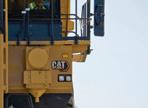

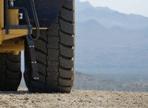

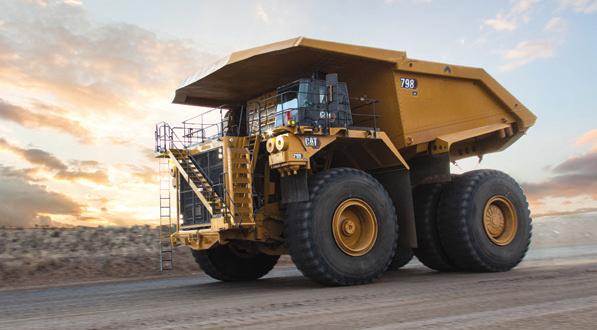



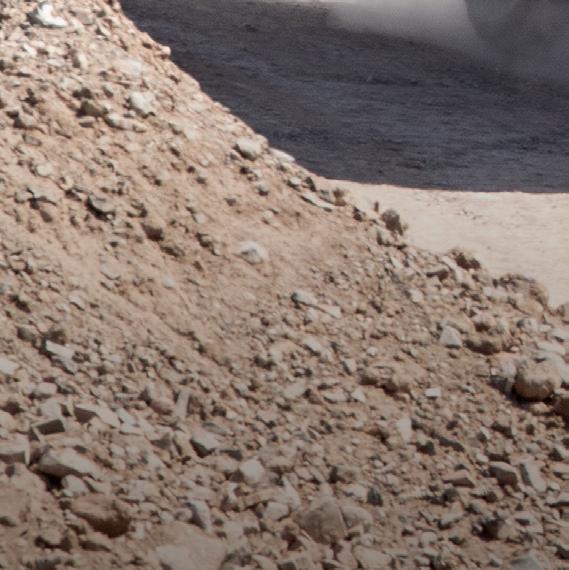
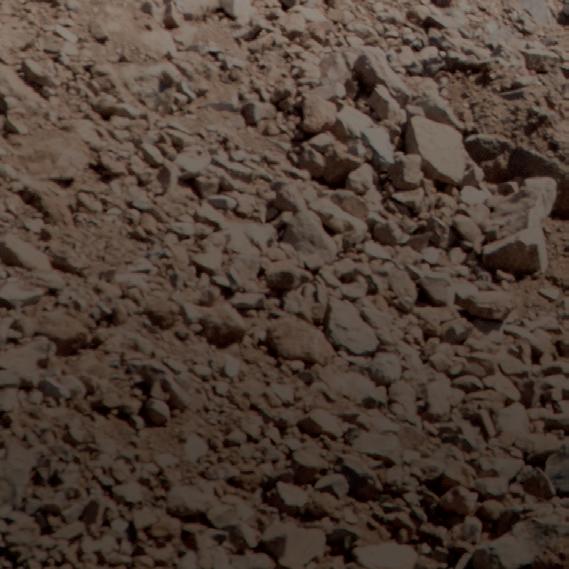
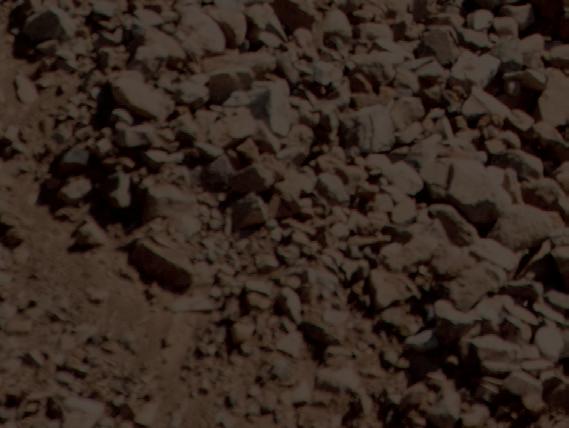



The development of every Cat® mining truck is driven by a commitment to delivering what you require: highly reliable and durable machines, technology and autonomy solutions that boost efficiency and safety, features to reduce environmental impact, and services that improve your overall hauling operation. Our efforts are driven by your results.

With a focus on continuous improvement and an innovative mindset, we’re committed to your operation today and in the future.

TOGETHER WITH CAT DEALERS, WE’RE YOUR PARTNER FOR THE LONG HAUL.
Discover new ways to improve your hauling operation today: CAT.COM/MININGTRUCKS


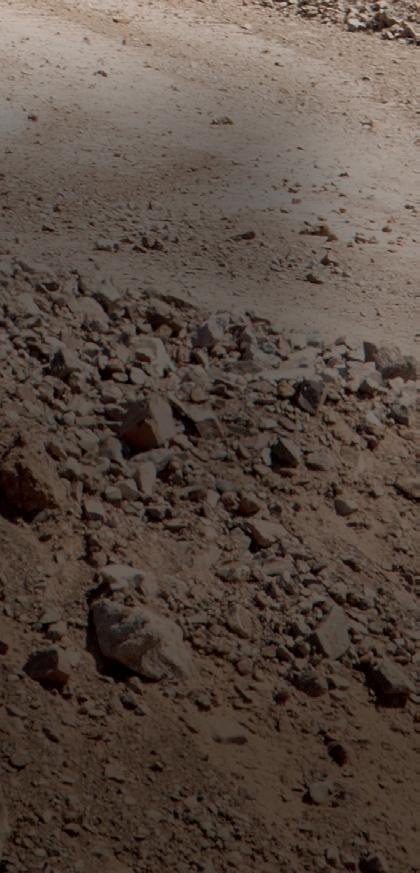



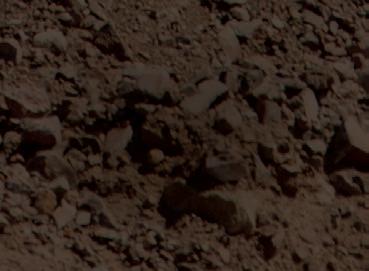


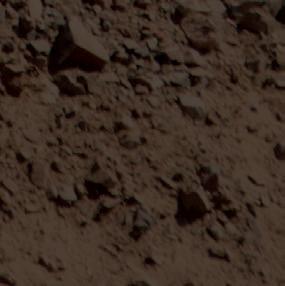
CAT® MINING TRUCKS DRIVEN FOR RESULTS ©2024 Caterpillar. All Rights Reserved. CAT, CATERPILLAR, LET’S DO THE WORK, their respective logos, “Caterpillar Corporate Yellow”, the “Power Edge” and Cat “Modern Hex” trade dress as well as corporate and product identity used herein, are trademarks of Caterpillar and may not be used without permission.

CONTENTS
03 Editor’s Comment
05 Guest Comment
07 Industry News
10 Navigating Nickel
Luc Lachance, ION Commodities, Canada, discusses nickel’s performance in 2023 and explores how operational excellence can ensure sustained business success.
13 In Tune With Nature
Paul Kos and Chris Jaros, Stantec, USA, consider the advantages of implementing nature-based stream restoration methods in mine closure.
17 The Evolution Of A Workhorse
Gordon Wilkin, Caterpillar, Inc., reviews the evolution of the CAT® R2900: an LHD on the verge of celebrating 30 years since its first introduction to the mining industry.
21 Around Tyres And Beyond
Caroline Wies, Michelin Group, France, examines how data mining can be pushed to the next level for safer, smarter, and more sustainable mining operations.
24 An Ecosystem For All
Komatsu USA presents a framework for what an open, democratic, and interoperable ecosystem for the mining industry – that leverages technology – might look like.
29 Lighten The Weight, Maximise The Payload
Josh Swank, Philippi-Hagenbuch, USA, describes the importance of choosing a lightweight truck body that offers all of the benefits, without the sacrifice of short wear life.



32 Paving The Way For Sustainable Mining
Luiz Sampaio, TotalEnergies Lubrifiants, France, highlights the critical role of lubricants in reducing the ecological footprint of mining activities.
37 Breaking New Ground
Elitza Terzova, Shell Lubricant Solutions, outlines the four factors that could shape the future of mining and the importance of collaboration in addressing key challenges.
41 Crushing Downtime With New Oil
Jim Thomas, Lubrication Engineers, USA, addresses how the right choice of lubricant can boost operational efficiency and prevent costly failures.
45 Expanding Exploration Across The Western US
American Pacific Mining Corp. provides an update on its portfolio growth in the western US; with joint venture partnerships with industry majors in Alaska and Nevada, the Canadian junior miner has expansion plans for precious and base metals opportunities.
49 Revamping Slurry Management
Frank Termeulen, Rhosonics, the Netherlands, explains how technological advancements can make slurry density measurement safer, greener, and more cost-effective.
53 The Future Is Digital
Tibor Nemes, Nokia, Hungary, assesses the benefits of utilising digitalisation to drive sustainable mining practices.
57 Drive System Overdimensioning: Still A Necessity?
Eric Åström, Hägglunds, Sweden, evaluates the pitfalls of overdimensioning and considers how electrohydraulic direct drives can provide a more efficient solution in the management of peak demand.
61 Driving Towards Sustainability
Giancarlo Scaturchio, Rockwell Automation, Italy, explores how variable frequency drives can deliver improved sustainability for mining operations through a collaborative business model.
ON THE COVER
Lubrifiants is a leading global manufacturer and marketer of lubricants, with 42 production sites around the world and a direct presence in 160 countries, delivering to more than 600 mines per day.
Lubricants division offers innovative, high-performance, and environmentally friendly products and services to help mining customers reduce their carbon footprint and ensure lowest total cost of ownership. Copyright © Palladian Publications Ltd 2024. All rights reserved. No part of this publication may be reproduced, stored in a retrieval system, or transmitted in any form or by any means, electronic, mechanical, photocopying, recording or otherwise, without the prior permission of the copyright owner. All views expressed in this journal are those of the respective contributors and are not necessarily the opinions of the publisher, neither does the publisher endorse any of the claims made in the advertisements. Printed in the UK. MiningReview like join Global Mining Review @Mining_review follow CBP019982
TotalEnergies
TotalEnergies’

















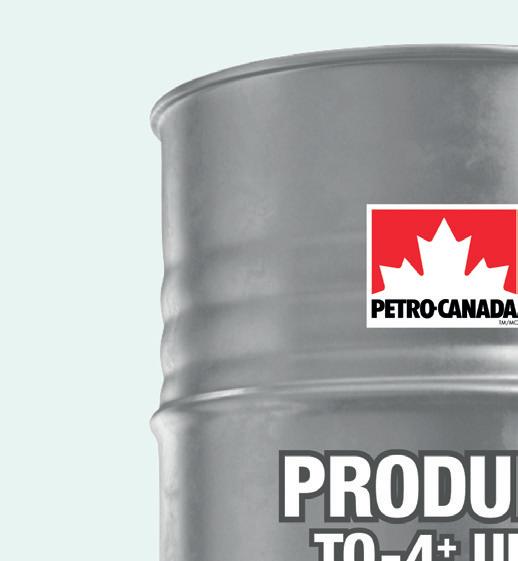







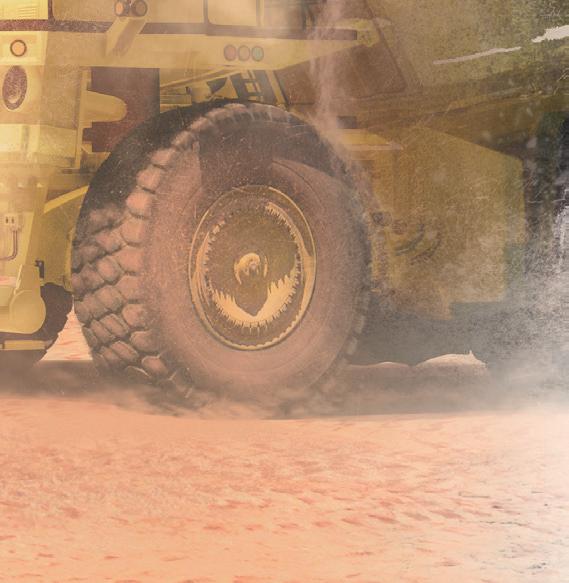


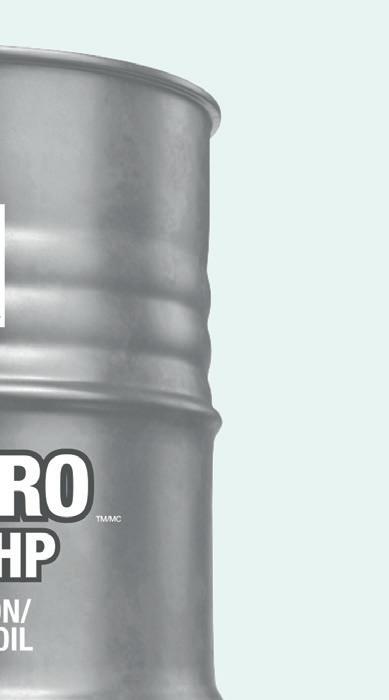

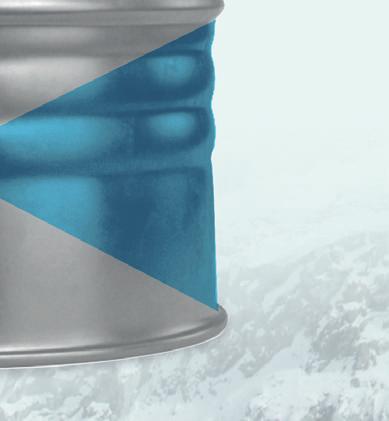


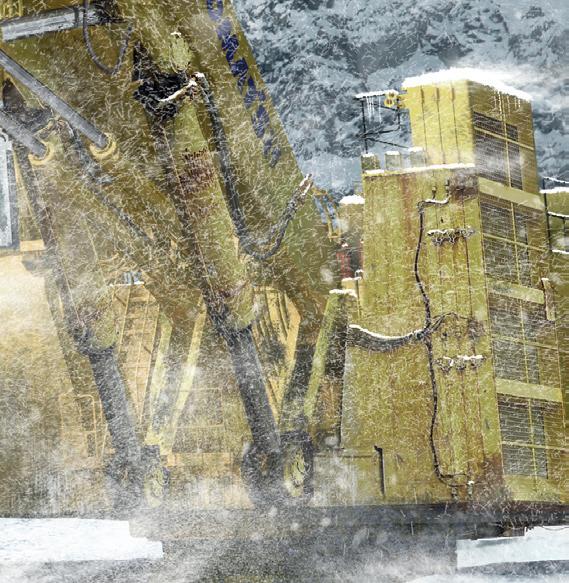






Premium multi-purpose synthetic all weather transmission, drive train, hydraulic and wet brake fluid for heavy-duty mobile equipment. Trademarks are owned or used under license EXTREME MINING CONDITIONS? CONSIDER THEM CONQUERED GAME CHANGING ASSET PROTECTION VISIT US AT CIM, BOOTH #504. VANCOUVER, MAY 12-15, 2024

Editor’s Comment

MANAGING EDITOR James Little james.little@globalminingreview.com
SENIOR EDITOR Callum O’Reilly callum.oreilly@globalminingreview.com
EDITOR
Will Owen will.owen@globalminingreview.com
EDITORIAL ASSISTANT
Jane Bentham jane.bentham@globalminingreview.com
SALES DIRECTOR
Rod Hardy rod.hardy@globalminingreview.com
SALES MANAGER
Ryan Freeman ryan.freeman@globalminingreview.com
PRODUCTION MANAGER
Kyla Waller kyla.waller@globalminingreview.com
ADMINISTRATION MANAGER
Laura White laura.white@globalminingreview.com
DIGITAL ADMINISTRATOR
Nicole Harman-Smith nicole.harman-smith@globalminingreview.com
DIGITAL CONTENT ASSISTANT
Kristian Ilasko kristian.ilasko@globalminingreview.com
DIGITAL
Merili Jurivete merili.jurivete@globalminingreview.com
EVENTS MANAGER Louise Cameron louise.cameron@globalminingreview.com
EDITORIAL ASSISTANT, GLOBAL MINING REVIEW
As spring arrives, groundbreaking ideas and initiatives within the mining industry continue to bloom. Only three months old, 2024 is already proving to be a remarkable year for innovation and transformation across all aspects of mining operations.
I, along with the rest of the Global Mining Review team, had the privilege of attending SME MINEXCHANGE in Phoenix, USA, at the end of February, to meet industry leaders and witness their new technologies and programmes in action. This was an excellent opportunity to observe how much mining has developed in the past year, with the adoption of sustainability initiatives increasingly becoming a key point of discussion.
From electrifying vehicle fleets to improving energy efficiency through the use of artificial intelligence, the vast range of sustainable approaches promoted at the conference was impressive and encouraging. Undoubtedly, the next generation of mining leaders and engineers must adapt to increasing demand, not only for critical minerals across the world, but also for green technology that aids the decarbonisation of the industry as a whole.
By 2030, only half of the cobalt and lithium required for the green energy transition, and 80% of copper, will be produced by mines.1 With mining so crucial to the progress of this transition, and consequently, to the future of our planet, it is clear that a unified, holistic approach to boosting production, while keeping emissions low, is required.
The need for investment in the net zero transition seems even more acute approaching the summer months. Scientists at the EU’s climate service recently raised alarm bells by confirming that 2023 was the warmest year since 1850, and they have warned that 2024 could be even hotter.2
Everyone within the industry must therefore strive to work together, as minimising the impact of mining operations on the environment and surrounding communities is paramount. The safety and protection of the environment are at stake, not to mention the financial impacts and damage to the reputation of companies.
Electrification has become a hot topic across the mining industry as it searches for ways to reduce its emissions. This entails not only implementing battery electric vehicles (BEVs) in the mining process, but also using green energy to power every element of an operation. While the rise in electricity costs may pose an obstacle, companies have managed to develop automation and digitalisation solutions to improve energy efficiency and optimise the decarbonisation process.
Recognising the importance of electrification, GMR has launched its first virtual conference, titled ‘Electrification in Mining’. Taking place on 16 April, the event will feature a range of presentations from mining leaders and industry experts exploring the evolution of technologies and initiatives to promote the future of sustainable mining. Register for free on our website now: www.bit.ly/49ytkos
This March issue of Global Mining Review also delves into other ways sustainability initiatives are implemented in all stages of the mining process. For example, TotalEnergies’ article on page 32 highlights how lubricants can play a crucial role in reducing the ecological footprint of mining activities. Meanwhile, on page 13, Stantec considers the advantages of implementing nature-based stream restoration methods in mine closure.
With the climate crisis looming over everyone’s lives, effective collaboration and cooperation between companies and countries are essential. The adoption of sustainable technologies and innovations across mining operations is not a matter of if, but when.
References
2.
1. SOBOTKA, B., ‘The mining industry must be ambitious in its support of the net zero transition’, World Economic Forum, (12 February 2024).
Palladian Publications Ltd, 15 South Street, Farnham, Surrey, GU9 7QU, UK t: +44 (0)1252 718999 // w: www.globalminingreview.com
SEABROOK, V., ‘2023 was world’s hottest year on record – and 2024 could be worse’, Sky News, (9 January 2024).
EVENTS COORDINATOR
Global Mining Review (ISSN No: 2515-2777, USPS No: PENDING) is published 10 times per year by Palladian Publications Ltd., and distributed in the USA by Asendia USA, 701 Ashland Ave, Folcroft, PA. Application to Mail at Periodicals Postage Prices is pending at Philadelphia, PA, and additional mailing offices. POSTMASTER: send address changes to Global Mining Review, 701 Ashland Ave, Folcroft, PA. 19032. Annual subscription (10 issues) £50 UK including postage, £60 overseas (airmail). Claims for non-receipt must be made within four months of publication of the issue or they will not honoured without charge.
JANE BENTHAM



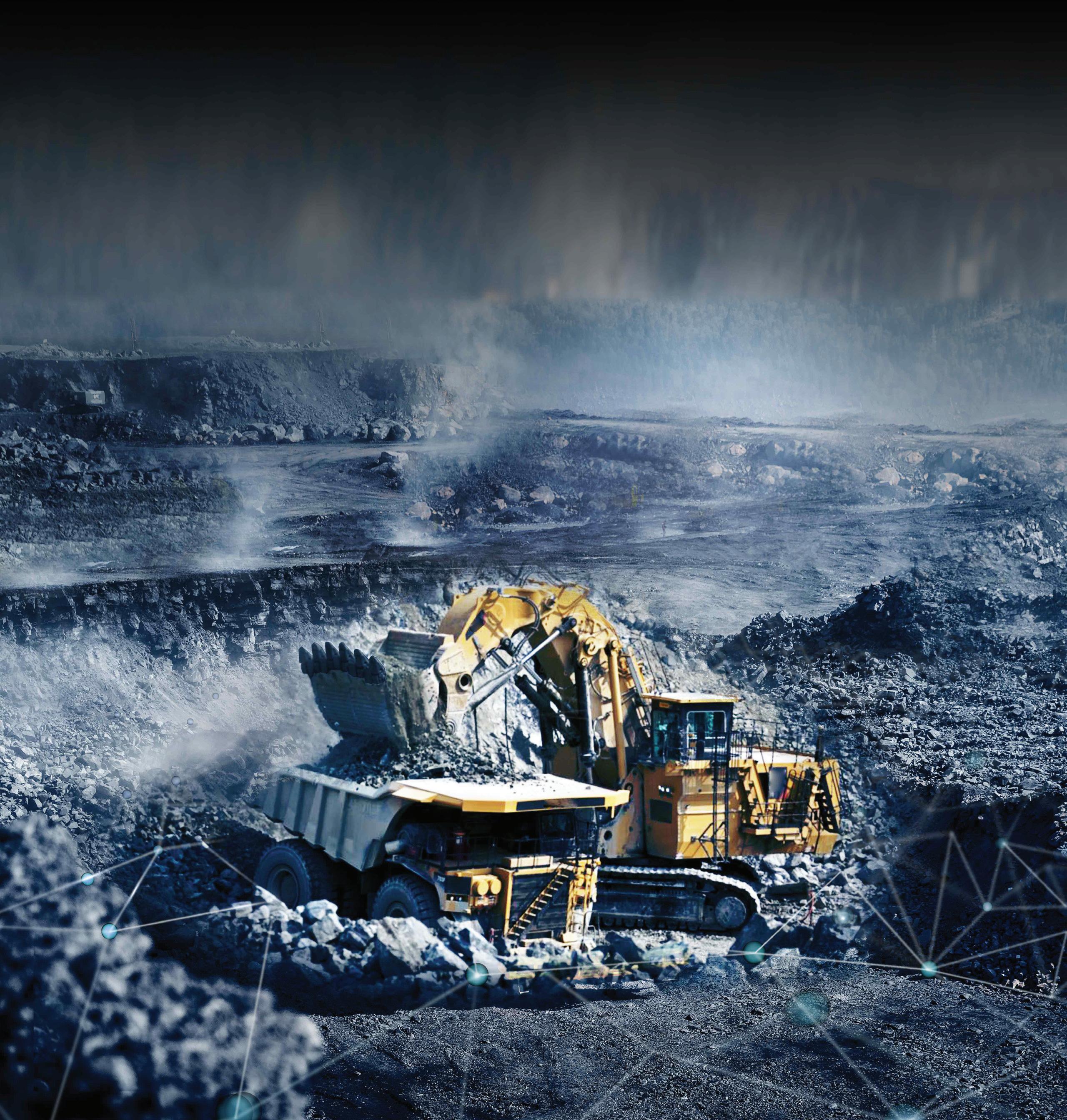
Truck Trakka technology Identify haul truck fleet to optimize individual vehicle payloads Empowering the next era of real-time payload management crmining.com Titan 3330™ is the most advanced real-time payload management system for mining operations, able to track and automatically report on all material movements. With its high-precision GPS offering 10cm accuracy to the bucket teeth via a user-friendly interface, operators can benefit from knowing where they need Start the conversation Globalsales@crmining.com 1300 33 8482 crmining.com/digital
3330 real-time payload management Load & haul maximized High-precision GPS, providing 10cm accuracy to the bucket teeth
Titan


NGuest Comment
GREGORY BEISCHER CEO, ALASKA ENERGY METALS
ickel activity is rising to accommodate multi-sector demand. Its importance as a transition metal has grown, but today’s production of critical clean energy inputs, from batteries to solar panels to critical materials, is concentrated in only a handful of countries, which is an issue.
Nickel will be required to support global population growth, which is anticipated to hit 8 billion in the next six years. At the same time, the world’s largest producer of nickel – Indonesia – may experience a change in its laterite nickel supply. Last year, the Indonesian Nickel Miners Association revealed the country’s reserves of high-grade nickel ore may be depleted by 2030, due to high annual production and increased demand from smelting facilities. If Indonesia exhausts its existing reserves without further exploration, this would mark a significant turning point for the global nickel supply chain.
On one hand, this would be the most ideal scenario for our environment. Indonesia and Chinese companies operating nickel mines, smelters, and refineries do not share the West’s standards for environmental protection. However, on the other, it could cause serious disruption, which is why long-standing dependence on Indonesia’s nickel supply is becoming highly unfavourable to activists and governments alike.
A new focus: Disseminated sulfide ores
While the West is far behind compared to where it needs to be to support demand and avoid an industrial bottleneck and supply chokehold, it has revived nickel exploration with a strong focus on the delineation and discovery of disseminated sulfide ores.
Sulfide deposits, which are typically formed in igneous or volcanic environments, contain higher concentrations of nickel and are generally easier to mine. Several decades ago, explorers overlooked this grade of nickel, but today it has gained favour, most notably in the electric vehicle sector, because it aids in the development of EV batteries. In order to keep pace with production expectations and keep
decarbonisation goals on track, nickel exploration in the West must continue. In the US, for example, a sudden supply halt would be detrimental to various groups, including the country’s national defence.
Nickel exploration in the US
The US Geological Survey includes nickel on its list of fifty minerals critical to the country’s economy and national security. As of now, the US has only one existing nickel mine, and, while it is operational, the country imports 100% of the nickel it actually uses. This mine is anticipated to reach its end of life by 2027.
New federal legislation like the Inflation Reduction Act and the bipartisan infrastructure law have worked to encourage and create big incentives for domestic production, but mining operators in the US continue to be met with challenges. In the US today, there are only a few states in which nickel can be found. These include Michigan, Minnesota, Alaska, and a few others, but proposals for mining operations have not exactly been met with open arms. Alaska is particularly important because it is a pro-mining state with the gold standard environmental and regulatory regime to support truly responsible mining.
The hard truth
While the above is an ideal scenario, at the present time, Indonesian nickel production is up by one quarter from 2018 and currently accounts for half of the world’s nickel supply. Indonesia’s ministry is also working to attract more investment for exploration projects, but the Indonesian Institute has warned that if further exploration continues, it will not come without potential consequences, some of which we have already seen.
If Indonesia overbuilds nickel processing facilities, nickel reserves will decline due to over-mining and environmental risks will intensify – something we simply cannot afford if, globally, we are to meet our ambitious climate goals and protect the environment.
Palladian Publications Ltd, 15 South Street, Farnham, Surrey, GU9 7QU, UK t: +44 (0)1252 718999 // w: www.globalminingreview.com

Innovative solutions. Positive transformation.
You need a partner that can meet your needs and embrace the future. One with new solutions for a changing world. Together, we can work toward a better future. komatsu.com/hardrock
© 2024 Komatsu Ltd. or one of its subsidiaries. All rights reserved.
WX07 LHD

World NEWS
SOUTH AMERICA Metso opens slurry pump hubs in Peru and Brazil
Metso has established pump assembly and competence centres in Peru and Brazil, investing in its slurry pump capabilities in South America.
These regional Metso Pump hubs serve mining customers by offering a full range of slurry handling solutions and shorter lead times with reduced transport-related CO 2 emissions.
“Our investments in our regional pump hubs have paid off. Our customers get fast access to our experts and the whole breadth of our pumps offering. As examples of some of the latest orders, I’d like to mention this quarter’s record-breaking order of nearly 100 pumps for an iron ore mine and another major order for a copper mine in 2023, including a significant number of horizontal and vertical slurry pumps. A key enabler of these sales has been our comprehensive technical and service support, as well
as our quick delivery times, effective collaboration, and competitive prices,” said Eduado Orsi, Manager, Pump Application and Sales at Metso in Brazil.
“Slurry handling is vital in maximising productivity and efficiency of minerals processing plants. Our offering has been designed to serve our customers’ needs for effective slurry handling. In addition to the major growth in new pump equipment orders in South America, customers are increasingly interested in our aftermarket offering, including our agreement-based services. To support our customers, we have strengthened our regional supply chain and assembly capacity, as well as application and engineering resources. Metso will continue to invest in slurry handling capabilities in South America and other key market areas,” added Kalle Sipilä, Vice President, Pumps Business at Metso.
CANADA Rio Tinto to decarbonise iron ore processing
The Government of Canada has awarded CAN$18.1 million from its Low Carbon Economy Fund to Rio Tinto’s Iron Ore Company of Canada (IOC) to support the decarbonisation of iron ore processing at its operations in Labrador West.
The funding will enable IOC to reduce the amount of heavy fuel oil that is consumed in the production of iron ore pellets and concentrate. The company will install an electric boiler to displace emissions from the usage of the heavy fuel oil boilers, as well as instrumentation and fuel-efficient burners to further reduce heavy fuel oil consumption from induration machines.
Over the lifetime of this project, IOC will see a cumulative reduction of about 2.2 million t of greenhouse gas emissions.
Installation of the new equipment will begin in 2Q24 and is expected to be completed in 1H25. The project will create more than 100 jobs during the construction and implementation stages in Labrador West.
IOC President and Chief Executive Officer, Mike McCann, said: “Rio Tinto IOC has a plan to decarbonise and continue producing some of the lowest carbon-intensity high-grade iron ore products in the world, right here in Canada. This project alone will eliminate approximately 9% of IOC’s greenhouse gas emissions. We look forward to collaborating with the Government of Canada and other partners towards our goal of achieving net zero emissions by 2050.”
Labrador Member of Parliament, Yvonne Jones, added: “By working with organisations across Canada, such as IOC, we can help the community save money on monthly operating costs and grow the economy, all while fighting climate change. Through the Low Carbon Economy Fund, the Government of Canada is partnering with climate leaders nationwide to cut emissions. I applaud the leadership shown by IOC for helping to keep our air clean and build resilient communities in Newfoundland and Labrador.”
7 global mining review // March 2024

World NEWS
Diary Dates
Electrification in Mining
16 April 2024
Online Conference www.globalminingreview.com/ events/electrification-in-miningvirtual-conference
CIM Connect Convention & Expo
12 – 15 May 2024
Vancouver, Canada www.cim.org/events
Discoveries Mining Conference
21 – 23 May 2024
Mazatlán, Mexico www.discoveriesconference.com
Euro Mine Expo
28 – 30 May 2024
Skellefteå, Sweden www.euromineexpo.com
Exponor Chile
03 – 06 June 2024
Antofagasta, Chile www.exponor.cl
Elko Mining Expo
06 – 07 June 2024
Elko, USA
www.exploreelko.com/top-events/ elko-mining-expo
International Fairs EXPO KATOWICE
04 – 06 September 2024
Katowice, Poland www.expo-katowice.com
MINExpo INTERNATIONAL®
24 – 26 September 2024
Las Vegas, USA
www.minexpo.com
To stay informed about upcoming industry events, visit Global Mining Review’s events page: www.globalminingreview.com/events
SWEDEN Boliden partners with Hypex Bio for environmentally-friendly explosives
Boliden has signed an agreement with the Swedish explosives supplier Hypex Bio regarding the production and delivery of nitrate-free and environmentally-friendly explosives to Kankbergsgruvan, Boliden.
The agreement means that Boliden and Hypex will cooperate on the production and delivery of nitrate-free and environmentally-friendly explosives to the Kankberg mine, which includes the establishment of a production facility at the mine, as well as a delivery and service agreement.
The supply and service agreement for Hypex’s explosives solution spans five years starting in 2024. The production quantity is expected to amount to 400 – 450 t and thus largely meet the Kankberg mine’s annual needs. In addition to the fact that the explosive drastically reduces the need for nitrogen treatment of water, the climate impact is reduced by approximately 400 t of CO2 per year (Scope 3).
“For us, it is important to be part of technology development in many areas and when it is successful, we also want to be early with implementation. Together with the electrification of transport and other machines, this means another important step towards being able to conduct mining operations that are, in principle, fossil-free,” said Peter Bergman, General Manager of the Boliden area.
GLOBAL Komatsu adds new LHD to underground hard rock line-up
Komatsu has introduced to the global market the new WX11 LHD, an 11 t machine that offers optimum breakout force and payload, helping to maximise productivity and provide a lower total cost of ownership.
The WX11 showcases Komatsu’s commitment to providing underground hard rock miners with a load, haul, and dump solution, integrating next-generation data management capabilities, operator ergonomics, intuitive controls, and compliance with EU Stage V emission requirements. As a new model within the Komatsu hard rock family of products, the WX11 is designed to be a leading LHD for all underground mine operators and contractors. With ease of operability, optimal performance, and ground-level maintenance position, the WX11 has several competitive edges in the 10 t LHD class.
“The WX11 is a game changer for hard rock miners. Developed through a close partnership between our experienced team and our longtime customers, this product reflects a shared commitment to design excellence,” said Ryan Karns, Director of LHD and Truck Products at Komatsu. “The WX11 is the LHD every miner will want to have in their operation.”
8 March 2024 // global mining review

PROdUCT NEWS
Many mining companies around the world suffer from water stress and, although mine managers understand that evaporation may be reducing their available water, most do not understand its full impact.
Table 1 shows a few examples of evaporation losses from water storages of various sizes, based on an average daily evaporation rate of 12 mm. This is a typical figure in hot climates, but it can vary according to ambient temperature, humidity, wind speed, and other factors.
To address these water losses, Aquatain Products Pty Ltd – an Australian company which has been pioneering its water-saving technologies since 2006 – has developed a unique product called WaterGuard GOLD. The product is a liquid which self-spreads across the surface of water storages, forming a very thin ‘liquid lid’ on the surface.
Danny Bryan, Special Projects Consultant with Aquatain Products Pty Ltd, says: “The principle is simple, but the impact can be huge. Trials have shown evaporation reductions of 50% or more. As you can see from Table 1, a one-hectare dam can lose more than 800 000 litres of valuable water each week. Evaporation is really a silent assassin, as you can stand beside a dam all day and not realise that the water is disappearing in front of you. WaterGuard GOLD is very easy to apply. For most dams, it can be simply poured on from the edge and it will self-spread to cover the surface. For larger storages, it can be applied directly from a boat or barge.”
The product is economical to use. In a harsh environment, for example, an application of 3 litres will protect 1000 m2 of water surface for up to three weeks. A lower rate can be used in less-severe conditions.
The components of WaterGuard GOLD are safe chemicals, and are used in many food and pharmaceutical applications.
In addition to WaterGuard GOLD for evaporation control, the company has another flagship product called Aquatain AMF for mosquito control. Like WaterGuard GOLD, it spreads across the water surface to form a very thin film. However, its action is slightly different: the Aquatain AMF film reduces the surface tension of the water, preventing mosquito larvae from attaching at the surface to breathe and causing them to drown. The product involves an entirely physical action without any toxic chemicals. It is highly effective in breaking the mosquito breeding cycle, is approved for sale
in nearly 70 countries, and has been prequalified by the World Health Organisation, which ensures users that it has been extensively assessed for its efficacy, safety, and quality.
Malaria and dengue fever are endemic to multiple countries around the world (malaria kills more than 700 000 people in Africa each year), and mining companies are affected severely in many cases. In addition to recognising its responsibility to protect its employees and families from disease, there is clearly a benefit to a mining company’s bottom line if absenteeism can be minimised by reducing the incidence of mosquito-borne disease.
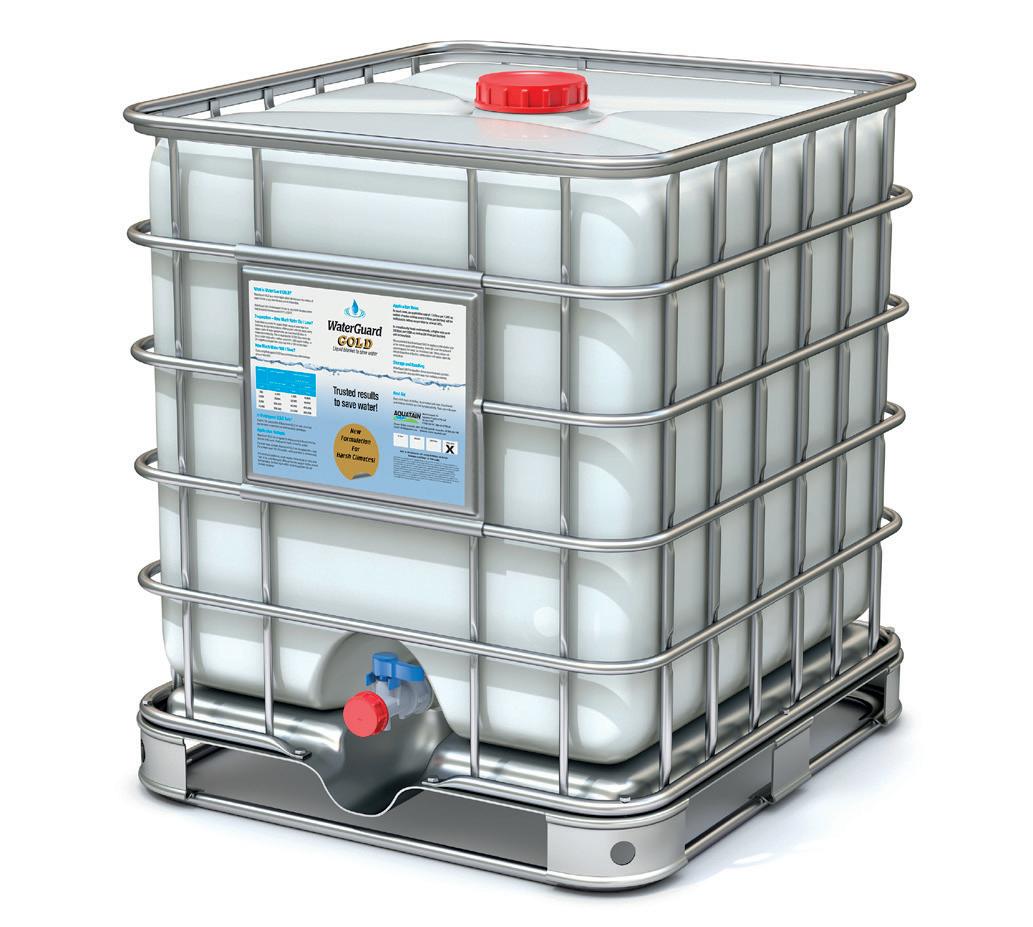 Figure 1. WaterGuard GOLD is available in several sizes, up to 1000 litre IBCs.
Figure 1. WaterGuard GOLD is available in several sizes, up to 1000 litre IBCs.
Surface area of dam (m 2 ) Evaporation losses (litres) Daily Weekly 500 6000 42 000 1000 12 000 84 000 5000 60 000 420 000 10 000 120 000 840 000 9 global mining review // March 2024
Table 1.
Luc Lachance, ION Commodities, Canada, discusses nickel’s performance in 2023 and explores how operational excellence can ensure sustained business success.
The demand for nickel – all over the world – has undergone considerable growth over the past two decades, with the market evolving from 1.12 million t in 2000 to 3.42 million t in 2020.1 However, 2023 posed fresh challenges to the industry, marked by volatile pricing dynamics, oversupply concerns, and uncertainties surrounding demand from China’s struggling property sector.2 Under these challenging conditions, nickel emerged as the weakest performer among LME base metals in 2023, with prices down by around 45% according to ING.3
In response to this turbulent market environment, nickel producers – from the C-Suite to process professionals and plant superintendents – should focus on what they can most readily control: operational excellence. While financial derivatives offer a hedging option to navigate fluctuating supply and demand dynamics, operational excellence stands out as the single most important tool at the disposal of nickel producers for gaining a competitive advantage and ensuring sustained business success amidst persistent market volatility.
Nickel overview
Nickel, the fifth most abundant element on Earth, plays a key role in various industries ranging from stainless steel production to electric vehicle (EV) lithium-ion batteries. Although reserves available for economically viable mining are limited, the current land resource base is estimated to endure for over 100 years at the present mining rate, according to the International Nickel Study Group (INSG).4 Geographically, Asia dominates the nickel market, with China alone representing nearly 60% of the world demand in 2020 (up from 39% in 2010).5
The primary application for new nickel remains stainless steel production, with this market experiencing a growth rate of approximately 5.8% per annum, driven by demand across the automotive, consumer goods, and construction industries.6 However, nickel’s usage extends to alloyed steels, high nickel alloys, castings, electro-plating, catalysts, and chemicals.

10 March 2024 // global mining review
What changed in 2023?
Supply and demand dynamics
The demand for nickel witnessed substantial growth in 2023 and is projected to further increase by 9% in 2024.7 However, this surge in demand has also been met with a simultaneous rise in production, presenting a challenge for balancing the market. Consequently, the global nickel market experienced a surplus of 223 000 t in 2023, over double the 104 000 t surplus in 2022. This surplus is particularly noteworthy given that the total global nickel output reached approximately 3.42 million t in 2023.3 Projections from the INSG indicate that this surplus is poised to expand to 239 000 t in 2024, marking the third consecutive year of excess supply.1
The surge in supply stands out as one of the key drivers for nickel’s relative underperformance in 2023, which can be mainly attributed to class II and nickel chemicals – particularly nickel sulfate, rather than the historical association with LME deliverable/class I nickel. Indonesia has played a pivotal role in this supply surge, particularly in nickel pig iron (NPI) and nickel mesh. To position itself as a significant raw materials supplier to EV battery manufacturers, Indonesia has substantially increased its mined nickel production in 2023. Holding the largest nickel reserves, Indonesia produced an estimated 1.6 million t in 2023, constituting nearly half of the global nickel production.8
China’s influence
In China, the second-largest producer of nickel, class I output rose by over 36% y/y in the first three quarters of 2023, responding to historically high LME prices.
However, the Chinese housing market, which was marked by a considerable slowdown in the latter half of 2023, has added complexities to nickel pricing dynamics. In July, new home prices fell by 0.23% in 70 cities, a slide that continued into December when they fell by 0.45%, as reported by the South China Morning Post.9 This downturn has strained the cash flows of real estate developers, leading to project delays and a diminishing trust in the property market.
Whilst there was initial optimism regarding Chinese stimulus measures to bolster metal prices in 2023, this enthusiasm is now waning, given the absence of a substantial stimulus package comparable to measures implemented during the 2008 financial crisis. Speculation is now growing that the economic slowdown in China might endure longer than initially anticipated, prompting financial institutions to downgrade their price outlooks for nickel.
Energy transition
Amidst the transition to cleaner energy sources, nickel has emerged as a key strategic metal due to its unique properties. The green transition, necessitating an investment of nearly US$200 trillion through 2050, particularly targets EVs, upgraded power grids, and low-carbon power, with nickel playing a central role.10 Offshore wind turbines, for example, are contributing to heightened nickel demand, as these technologies are mineral-intensive, requiring approximately 15 times more nickel compared to traditional wind turbine installations.11
Moreover, with major carmakers heavily investing in EV manufacturing, the surge in nickel demand for lithium-ion batteries – known for their higher energy density,
extended lifespan, and increased driving range – is expected to strongly impact the global nickel market in the coming years. McKinsey projects that by 2030, EVs and associated infrastructure will consume more than a third of global nickel production, a substantial increase from the current 17% demand attributed to EVs.11
However, in the short term, the path forward for EVs is uncertain, given that the market observed a notable slowdown in the latter half of 2023, particularly in the US. Several factors contributed to the smaller-than-expected appetite in 2023, including a consumer hesitancy to pay a premium for EVs, especially when faced with financing such premiums at high interest rates, as well as the comparative cost between electricity prices and fuel prices throughout the year. While it is yet to be determined whether this is a temporary occurrence or more of an enduring trend, there is notable uncertainty surrounding the trajectory of EV adoption, creating a volatile and unpredictable environment for the nickel industry.
Key to understanding the significance of these 2023 trends lies in the fact that pricing volatility already compounds enduring and widely acknowledged technical challenges. Nickel deposits are increasingly characterised by lower ore grades, needing more complex extraction processes, especially for laterite projects. Additionally, the energy required for metal extraction increases with decreasing ore grades, resulting in surging extraction costs which could potentially render mining financially unsustainable if prices stay low.12
What can we expect in 2024?
Ongoing volatility in industrial metals is expected to persist in 2024, influenced by factors such as a robust US dollar and weakened demand amid slow global manufacturing activity. Uncertainties in the metals markets – driven by economic growth concerns, geopolitical tensions, and strict monetary policies –continue to affect stainless steel and EV demand in particular.
Geographically, Indonesia’s NPI production is expected to rise, while China may witness a decrease in NPI production coupled with an increase in nickel cathode and nickel sulfate production. The uncertainty surrounding China’s recovery, especially in its troubled property sector, poses a significant challenge, restraining gains for industrial metals and sustaining volatility in the near term.
Despite a potential recovery in demand from the stainless steel sector and EV batteries, forecasted nickel prices indicate short-term pressure, averaging US$16 600/t in 1Q24 and gradually rising to US$17 000/t.13
Achieving (and sustaining) operational excellence
2024 is likely to witness volatile pricing in an already prevalent background of diminishing metal grades and increasing orebody complexity. To navigate this challenging market, nickel producers must prioritise operational efficiency to ensure competitive advantage and long-term success. Businesses must make every dollar count, and operational excellence ensures that mining companies can extract maximum value from their mineral deposits.
Achieving and sustaining such operational excellence is a gradual process that hinges on creating a culture where all teams invest in constantly improving business outcomes. Undoubtedly,
11 global mining review // March 2024
what lacks measurement cannot be managed effectively, and what is not precisely measured cannot be precisely controlled. First achieving compliance and excellence in metallurgical accounting practice, encompassing the representative and timely measurement of all significant metal movements and inventories in metallurgical operations, therefore appears as a necessary condition for meeting higher operational standards.
The data problem
Miners face challenges in transforming the abundance of data available at their operations and within the industry into valuable operational insights. A predominant root cause for this is the presence of data silos between departments, along with the widespread usage of spreadsheets for operational accounting and management across the metal value chain. This practice exacerbates integration issues as these homegrown systems struggle to present a unified source of truth.
Furthermore, poor representativeness and availability of certain data also preclude the ability to unlock valuable operational insights. This leads to inconsistent estimates for key performance indicators and operational models, affecting both analyses and predictions. Achieving operational excellence across the nickel value chain necessitates improving the representativeness of these estimates, which can be done through a combination of measurement retrofit and data reconciliation.
What are the consequences of relying on poorly representative data?
Firstly, poor estimates of metal movements and inventories inside and around mineral and metal processing plants pose huge risks of undetected material losses and lower-than-expected recoveries, which ultimately lead to lost profits when some revenues are not realised.
Secondly, poorly representative data from pit to port poses the risk of not shipping the right quantity and quality of metal concentrate at the right time. Shipping a lower quantity/quality of metal concentrate than the requirements may result in penalties and a loss of trust, while shipping a higher quantity/quality than required can lead to receiving insufficient payment in view of the actual production. This delicate balance highlights the importance of representative data in ensuring fair transactions and maintaining strong relationships with customers.
Finally, poorly representative data across the metal value chain may also lead to a lack of market responsiveness, resulting in lost profits when opportunities are not seized. Such low market responsiveness can be improved by extending the spatial scope and improving the timeliness of the metallurgical accounting system to produce representative valuation reports of a given metallurgical operation at a higher frequency. This is easier said than done, however, as doing so will require a higher measurement rate. This can be challenging, particularly for the inventories, let alone the pressure on the metallurgical lab throughput, which is more than often very limited. Importantly, this improvement path must be first implemented at each mineral or metal processing site and then fully integrated among a mining company for maximum operational and financial effectiveness, rather than being solely a corporate-level formality.
Overall, these risks and consequences could extend beyond immediate financial concerns to include reputational damages. Instances where companies are compelled to restate their financial statements not only create delays, but also sow distrust, triggering stock drops and other adverse consequences.
To mitigate these risks, the metallurgical accounting system must be compliant with industry-acknowledged standards, such as the AMIRA P754 Code of Practice for Metal Accounting. Such compliance requires, in a non-exhaustive manner, an adequate amount of data redundancy provided through a well-designed measurement system that has a fit-for-purpose measurement representativeness.
The importance of automation
To unlock the representative and timely information that operational excellence requires, an automated and systematic approach is essential. To this end, a focus on enhancing visibility across the entire metal value chain, connecting the front, middle, and back offices for greater transparency, is essential. Proprietary mathematical algorithms can be employed to create centralised dashboards serving as a ‘single source of truth’ to address operational challenges.
A seamlessly integrated data management system across the entire metal value chain minimises manual interventions and ensures a smooth flow of data from pit to port. This enables representative estimates of all significant metal movements and inventories, provided it is supported by regular equipment monitoring and system audits. Adopting a compliant and automated metallurgical accounting system should not only facilitate timely operational and financial reporting, but also maintain detailed records for critical processes like audits, enhancing the overall transparency for mining companies.
While technology adoption varies among miners due to the industry culture of fearing the ‘first mover’ reputation, champions of new technology at an operational level consistently yield the best outcome, and EY predicts that there will be a surge in data and technology adoption among miners in 2024.14
Conclusion
As the nickel market continues to face complex pricing dynamics and oversupply uncertainty, companies must prioritise optimising their operations to effectively secure profits and manage risks.
Operational excellence, a key differentiator for mining companies thriving in challenging environments, is unachievable, let alone sustainable, without first reaching compliance and excellence in metallurgical accounting. Mining companies that achieve and sustain such excellence will not only generate more profits from current deposits than competitors, but also opportunistically capitalise on upcoming deposits having declining metal grades and increasing orebody complexity. Those who do not embrace operational excellence risk falling behind in both current and future operations, potentially facing acquisition by competitors who have adopted and sustained operational excellence.
References
Available on request.
12 March 2024 // global mining review
Paul Kos and Chris Jaros, Stantec, USA, consider the advantages of implementing nature-based stream restoration methods in mine closure.
The mining industry can show sustainable water management by restoring streams, wetlands, and woodlands to natural ecosystems. Restoring a natural water system using Nature-based Solutions (NbS) provides a critical habitat for creatures living on land and in the water. It also supports the United Nations Sustainable Development Goals.


13 global mining review // March 2024
Reclamation promotes biodiversity, and helps mining companies get regulatory and social approval.
Historically, in the US, mine closure and water management regulations prioritised preventing erosion. Because of this, many mine water management methods included waterways made of hard armouring. The hard armour would be riprap or gabion baskets (a layered rock wall held together with metal wiring). Thankfully, today’s policies allow some erosion in stream restoration projects. This is a positive development, because erosion is a key principle of natural stream behaviour. Now, a more modern approach to mine closure and water management means restoring waterways to mimic the surrounding undisturbed areas.
Components of a restored stream
Stream restoration does not require a major effort beyond reclamation and monitoring. The initial water treatment and grading is the same for both nature-based and traditional methods. The main difference lies in recreating a more natural ecosystem using the six components outlined below.
Low-flow channel
A low-flow channel is key to concentrate seasonal flow fluctuations, providing a continuous water path. This channel usually meanders through the floodplain to limit channel gradient.
Riffle-pool sequence
Riffle-pool sequences create varied aquatic habitats. They have riffles on straight segments of the stream and allow for pools at the bends. Both habitat types are necessary for fish and insects to propagate. Riffle-pool sequences are also important from a structural perspective – as they provide gradient control on slopes up to 5%.
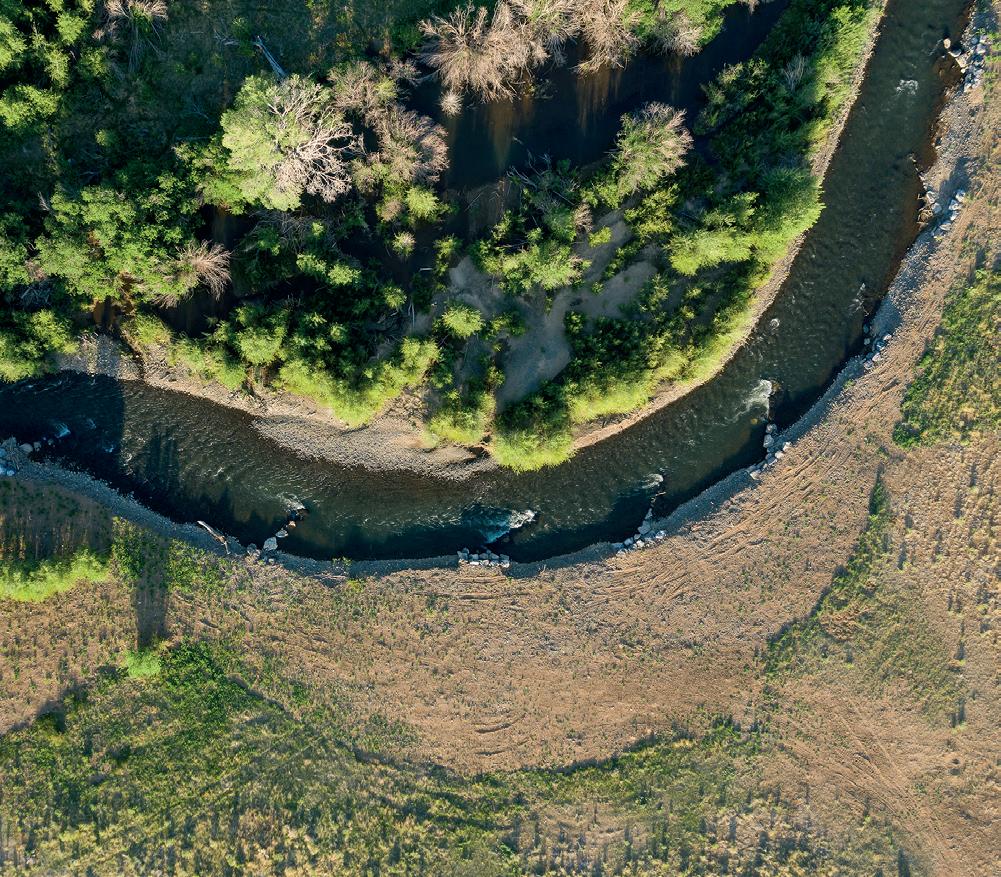
Floodplains
When there is more water than the stream can hold, it enters the floodplain. Even higher flows may reach overflow areas above the floodplain. Planning for large influxes of water is a key component of a resilient riparian ecosystem. The greater flow area and vegetation help decrease flow velocities and limits erosion.
Boulder walls or vegetated soil lifts
Sometimes, the site topography dictates the need for small sections of armouring along the streambank or channel, but the choices extend beyond the traditional riprap. More natural boulder walls or vegetated soil lifts can provide support, decrease erosion, and integrate with the natural landscape.
Vegetation
Proper revegetation of an area is critical to the success of a nature-based stream restoration project. A well-vegetated stream bank can resist erosive storm flows and help further strengthen armoured banks. It is best to choose a diverse seed and plant mixture that mimics the nearby natural stream setting. Riparian plant species thrive where water is present. They flourish on floodplains, tolerate high water tables, and provide erosion resistance. Plants create shade and help control stream temperatures. They also promote biodiversity by providing habitat for both land and aquatic animals and insects.
Fish passage
Fish ladders are sections of stream built to help fish navigate upstream where there are steep slopes and high velocities. Without help, those fish may not have access to important breeding habitat. The fish passage enhancements can take many forms, depending on the swimming ability of the native fish. It is anticipated that this will become more of a focus in future water management projects. In many parts of the US, new and current restoration projects include a fish and aquatic life component, with more regulations around fish passage. 1
Case studies in Colorado’s watershed
The riparian ecosystem of the Alamosa River in Colorado had been damaged by previous mining activity. When it came time to restore the watershed, the focus was on managing erosion and sediment deposition. Stantec restored more than 12 000 ft of the river. As with so many water projects, this was a section of river that served many stakeholders. The reservoir upstream regularly releases high volumes of water to accommodate agricultural needs downstream. Stantec installed boulder weirs along the riverbanks to better regulate the unnaturally high flow in the channel. The structures directed water back into the historic channel flow area, so the heavily vegetated inner banks could manage higher flow. This resulted in
14 March 2024 // global mining review
Figure 1. Natural restoration work on the Alamosa River included installing hydraulic structures to better manage erosion and sediment deposition.

reduced sediment loading and a stabilised channel. This restoration project also helped recharge groundwater nearby and safeguard natural infrastructure. The Alamosa River Restoration was good for the environment, promoted healthier communities, and achieved regulatory compliance, improving the larger watershed beyond the Alamosa River.
Another example in Colorado is Four Mile Creek. It supplies water to a few small towns near Boulder, and the watershed had been impacted by previous mining activity.
When Stantec’s team started work here, the amount of arsenic in the water was over the drinking water standard. Stantec environmental engineers tested waste rock piles to determine what metals were present and removed waste rock from the channel. The channels were restored using the principles discussed above, and the design included a low-flow channel, rifle-pool sequences, boulder walls, vegetated soil lifts, and floodplain areas. The team also capped remaining waste rock with an evapotranspiration cover to reduce leaching. Finally, they planted vegetation consistent with the surrounding forest and native stream channel.
After the restoration of the main channel and side tributaries, water quality in the area has greatly improved. Now, arsenic levels are below detection limits, and the surrounding landscape is regrowing.
Beyond environmental benefits –social acceptance and carbon
Support and buy-in is a very real component of today’s mining landscape. A mining company that has shown attention, care, and funding focused on environmental remediation is more attractive in the eyes of investors and the public. Plus, a proven record of responsible mining and environmental care promotes trust in communities who are often quick to oppose nearby mining activity. Changes in both legislation and reporting capabilities mean independent reviews can verify environmental stewardship successes.

Another benefit that is getting a lot of attention lately is the potential for riparian and wetland areas to sequester carbon. Large swathes of land – especially forested riparian ecosystems – can become carbon sinks as part of a carbon offset programme. This is evident in many industrial site closure plans. 2 It is anticipated that carbon sequestration opportunities will gain popularity, as more companies look to secure carbon credits and carbon offsets.
Cost of nature-based stream restoration
Regardless of the channel type, water management is typically a small percentage of the total reclamation costs at a mine. The greatest costs are usually slope grading, topsoiling, and vegetation. This means that adjusting the channel construction costs from hard armour to a natural system has a small impact on the final cost.
When restoring a stream, Stantec uses geometry and vegetation for erosion protection. As such, any additional excavation and vegetation may cost less than buying and placing rocks. Maintenance costs are also generally less. This is because a natural stream is a resilient ecosystem. It maintains balance through erosion and sediment deposition. Flooding is mitigated by building a grassy marsh area rather than riprap armouring.
In both the US and Canada, many mining projects may qualify for state and federal tax incentives and low-interest loans to support restoration work. 3 This is especially true for historic or abandoned mine sites that do not have an active supply of funding.
A duty to care for land and water
Nature-based water management can be part of every future mine closure plan. It is encouraging to see so many successful projects that have restored landscapes that were damaged due to mining impacts. Choosing to naturally restore stream channels and the surrounding landscape truly is the right thing to do. However, beyond a moral obligation, it can also make it easier to obtain permits, funding, and community support for future projects. Using a nature-based stream restoration approach is a winning solution for mining companies, communities, and the environment.
References
1. DANIS, N., NIGHTENGALE, T., and RYHERD, J., ‘Fish passage: Fixing culverts is key to better stream habitat for salmon, other species’, Stantec, (23 April 2023), https://www.stantec.com/en/ ideas/service/ecosystem-restoration/fish-passage-fixing-culvertsis-key-to-better-stream-habitat-for-salmon-other-species
2. WISEMAN, G., and PLAYER, B., ‘Measuring trees and tracking carbon sequestration from the sky’, Stantec, (30 August 2022), https://www.stantec.com/en/ideas/content/blog/2022/ measuring-trees-and-tracking-carbon-sequestrationfrom-the-sky
3. RYCKMAN, C., and MCCULLOCH, A., ‘Finding funding: New opportunities abound for the mining industry’, Stantec, (7 March 2023), https://www.stantec.com/en/ideas/content/ blog/2023/finding-funding-new-opportunities-abound-for-themining-industry
16 March 2024 // global mining review
Figure 2. Stantec worked with a local ranching community along the Alamosa River in southern Colorado to restore a vital water source that was once suffering from pollution.
Gordon Wilkin, Caterpillar, Inc., reviews the evolution of the CAT® R2900: an LHD on the verge of celebrating 30 years since its first introduction to the mining industry.
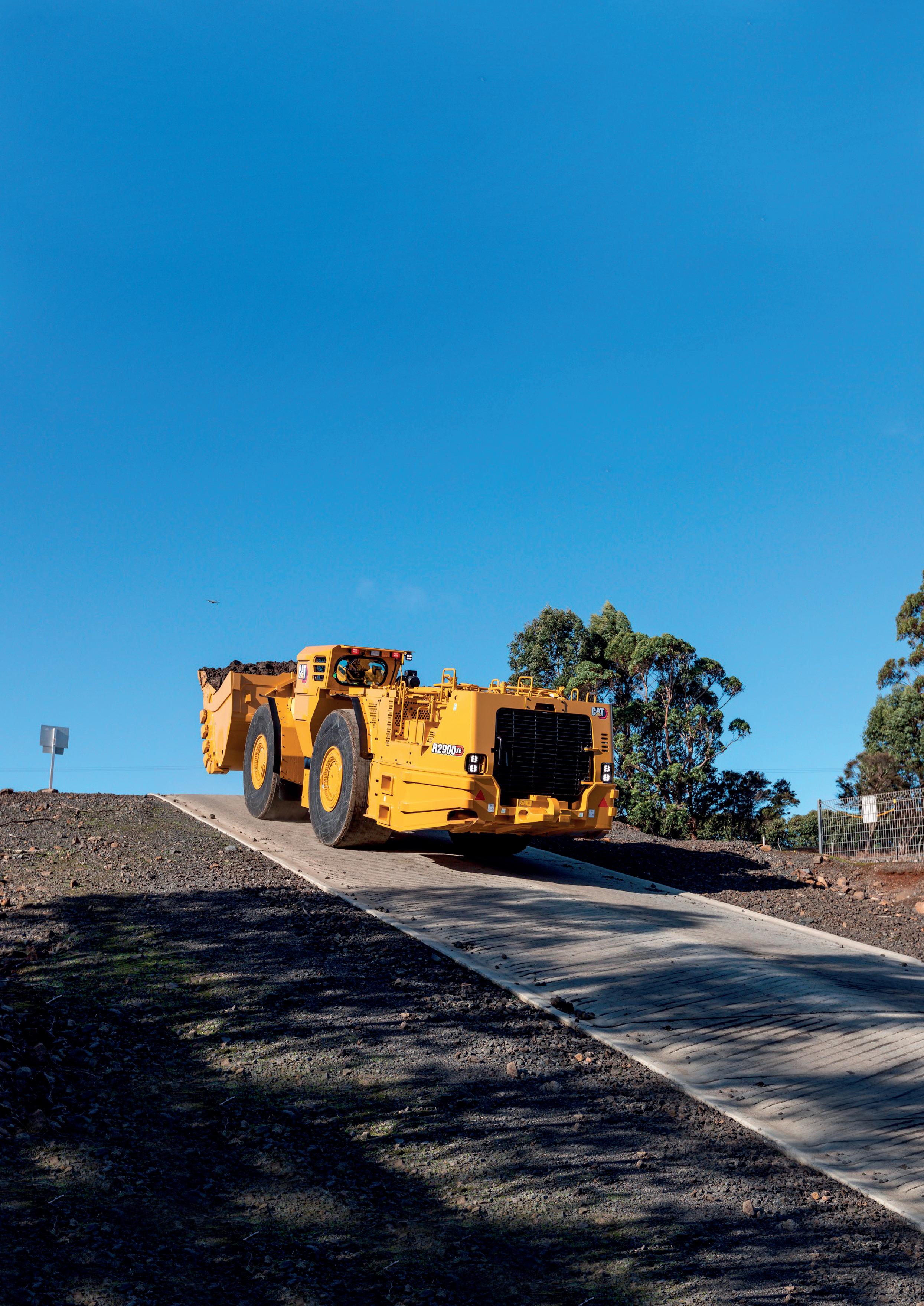
Replacing the originally designed large load-haul-dump (LHD) 2600 machine, which was closely followed by the successful R2800, the Cat® R2900 model series was first produced in December 1994 and made its debut at the 1995 AIMEX mining show in Sydney, Australia. It has enjoyed a rich history of efficient production spanning nearly three decades. The largest of the four LHD models, the R2900, increased rated payload to 17.2 t, 1 t higher than the R2800. At the time, this met mining operations’ needs for increased productivity to reduce the cost per tonne of ore mined. At mine sites in Australia, initial machines impressed operators with improved visibility that addressed left-hand-side blind spot issues common with other models.
Throughout the years, the R2900 series has remained the workhorse of the Caterpillar LHD line, with design updates making only minor changes to many of the productivity
specifications such as payload, bucket size options, and breakout force. Much of the effort focused on reducing exhaust emissions to improve underground air quality. Roughly a decade after the series introduction, the R2900G model was introduced in 2005 with both ventilation reduction (VR) system and EU Stage IIIA/US EPA Tier 3 engine packages. The former offered the optional use of flow through or highly efficient wall flow diesel particulate filters to improve underground air quality.
With commercial availability of the new Cat R2900 model in 2019, Caterpillar added an EU Stage V/US EPA Tier 4 Final engine option for markets adhering to higher emissions regulation standards. It introduced the Cat Clean Emissions Module to the LHD for limiting both particulate matter and NOx to near zero. Technology also played an integral role in machine design with Product Link™ Elite enabling machine
17 global mining review // March 2024
Figure 1. The R2900 XE’s switch reluctance electric drive system with continuously variable speed control provides 52% quicker acceleration and improved machine response over the R2900G.
health monitoring through the in-cab display and making it easier to share data across multiple destinations.
Remote machine operation was also introduced with the early R2900’s to increase operator safety. The scalable remote technology includes the Cat line-of-sight console with other


Cat MineStar™ Command technology options to make it possible for tele-remote and semi-autonomous operation from a distant operator station.
Sea change with the R2900 XE
With a markedly different design, the new Cat R2900 XE, introduced mid-year 2023, serves as Caterpillar’s next evolutionary step in pushing the boundaries of loader performance and efficiency. The company’s first diesel electric LHD model meets today’s mining industry’s needs for bigger payloads, faster loading, and reduced emissions. It features optimised lift arm and component geometry, plus load-sensing hydraulics to elevate lift breakout force to 32 500 kg and calculated tilt breakout force to 42 000 kg, an overall 35% improvement in breakout force from the R2900G.
Moreover, the new LHD includes many operator and technician enhancements designed to improve safety and productivity. Its field-proven switch reluctance (SR) electric drive system with continuously variable speed control provides 52% quicker acceleration and improved machine response over the R2900G. With no driveline or powertrain shock loads, it offers smooth directional changes and increased power train component life. Automatic retarding controls maintain speed on grade, and the anti-rollback feature also prevents coasting in neutral.
With no transmission or torque converter, the R2900 XE features lower hydrocarbon emissions and offers a reduction in fluids that require regular servicing. Service intervals for the Cat C15 engine have been increased to 500 hours. Together with lower heat generation, there is a reduction in service parts required and stoppages for servicing.
At 18.5 t payload, the R2900 XE’s 1.3 t higher payload than the R2900G delivers faster load cycle times and provides a three to four-pass match to the 63 t Cat AD63 underground mining truck. Both models offer a variety of capacity options to match mine site conditions. Productivity for the R2900 XE averages in excess of 20% higher compared to its predecessor.
The new Cat underground LHD model comes from the factory equipped ready for a broader range of Cat MineStar solutions than the R2900G. Mine sites can now choose from a wide array of technologies like Detect, Fleet, Health, and Command for underground that enable remote operation ranging from line-of-sight to full autonomy. Additionally, new Autodig technology optimises loading by automating crucial parts of the digging cycle.
The R2900 XE shares parts and components with the previous R2900G model and the industry proven Cat 988 XE large wheel loader. Many of the safety and technology advancements are also shared with many other models from the broad range of Cat equipment, allowing the local dealer to continue to provide support, service, and parts to the new R2900 XE.
Proving the claims
A six-month, Caterpillar-conducted study of the new R2900 XE followed the unit more than 1500 operating hours to compare its performance to that of the mine site’s existing fleet of five R2900G units. The R2900 XE was equipped with an 18.5 t rated bucket, and the R2900Gs were equipped with 17.2 t rated buckets.
18 March 2024 // global mining review
Figure 2. First produced in 1994, the Cat® R2900 has enjoyed a rich history of efficient production for nearly three decades.
34 % average fuel consumption 101.6 % tonnes / hour 20 % lift capacity 54.9 % CO emissions at high idle Compared with the Cat ® R2900G
Figure 3. Introduced mid-year 2023, the diesel electric Cat R2900 XE meets the mining industry’s needs for bigger payloads, faster loading, and reduced emissions.
Figure 4. Compared to the Cat R2900G, the new R2900 XE increases productivity and lift capacity and reduces fuel consumption and CO emissions.
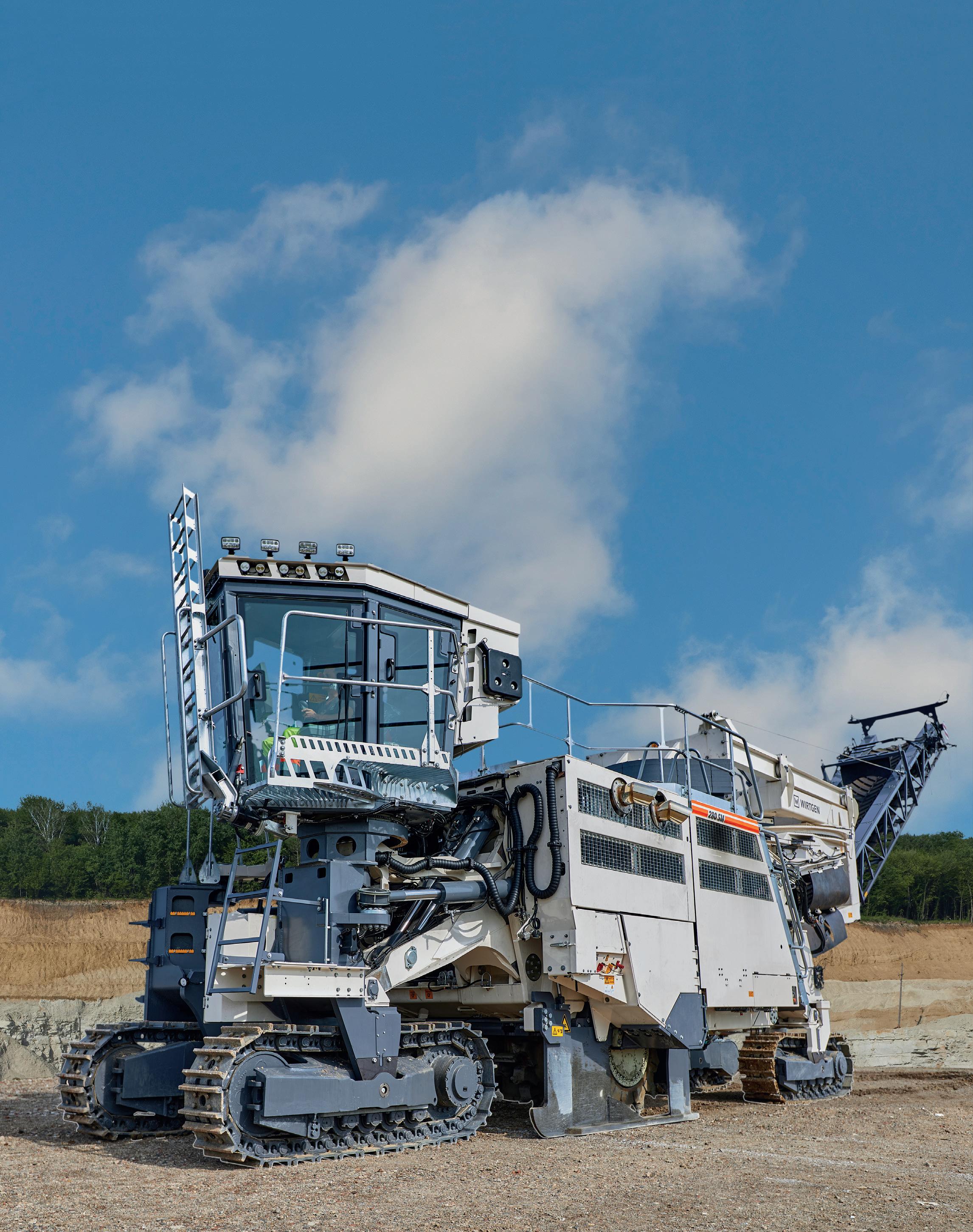
WIRTGEN GmbH · Reinhard-Wirtgen-Str. 2 D-53578 Windhagen T: +49 26 45 / 131 0 A WIRTGEN GROUP COMPANY
SM(i): Surface Mining combines safe mining operations with modern cost-effectiveness: the 280
replaces
otherwise needed for
drilling and pre-crushing. It cuts costs, delivers mined raw materials of higher quality, and ensures more efficient exploitation of the deposits. Take advantage of innovative solutions from the technology leader. www.wirtgen.com www.wirtgen.com/mining Blasting? No! Safety? Yes!
280
SM(i)
the entire equipment
blasting,
Field follow data showed a 34% average fuel consumption reduction with the R2900 XE, primarily due to its SR electric drive system and hydraulic piston pumps. The new R2900 XE also offered 54.9% lower CO emissions at high idle, while NOx emissions were 34% and 42.1% lower at idle and high idle, respectively. Diesel particulate matter was lowered by 99.99%, comparing the R2900 XE EU Stage V/US EPA Tier 4 Final engine to the Tier 2 of the R2900G.
Lower CO and NOx emissions data demonstrated an improved working environment for personnel at the mine using the R2900 XE. Beyond reduced exhaust emissions, a 7 – 11°C reduction in working area temperatures were recorded. At the same time, the R2900 XE operates quieter and reduces exposure to vibration levels compared to its predecessor.
The new R2900 XE offers an impressive reduction in tyre wear, which Caterpillar attributes to the new traction control system design. Traction control reduces tyre spin in difficult underfoot conditions to improve productivity, increase tyre life, and reduce consumable costs.
The R2900 XE, with its higher bucket capacity, provided a 101.6% increase in tonne-per-hour productivity on a duty cycle pulling material from the same loading source to destination. The field follow results also demonstrated a 20% increase in lift
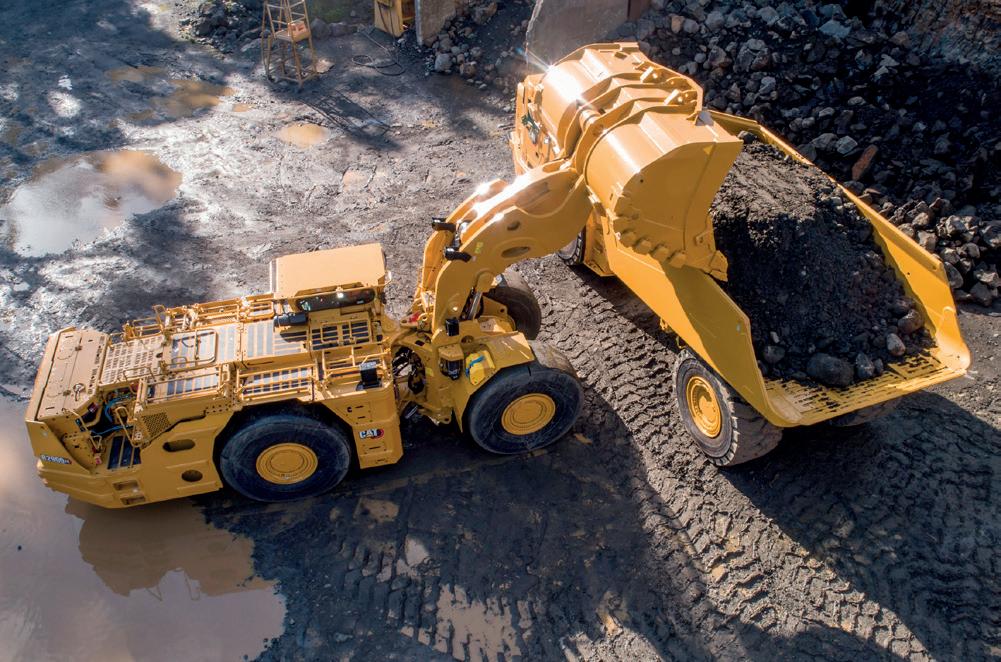
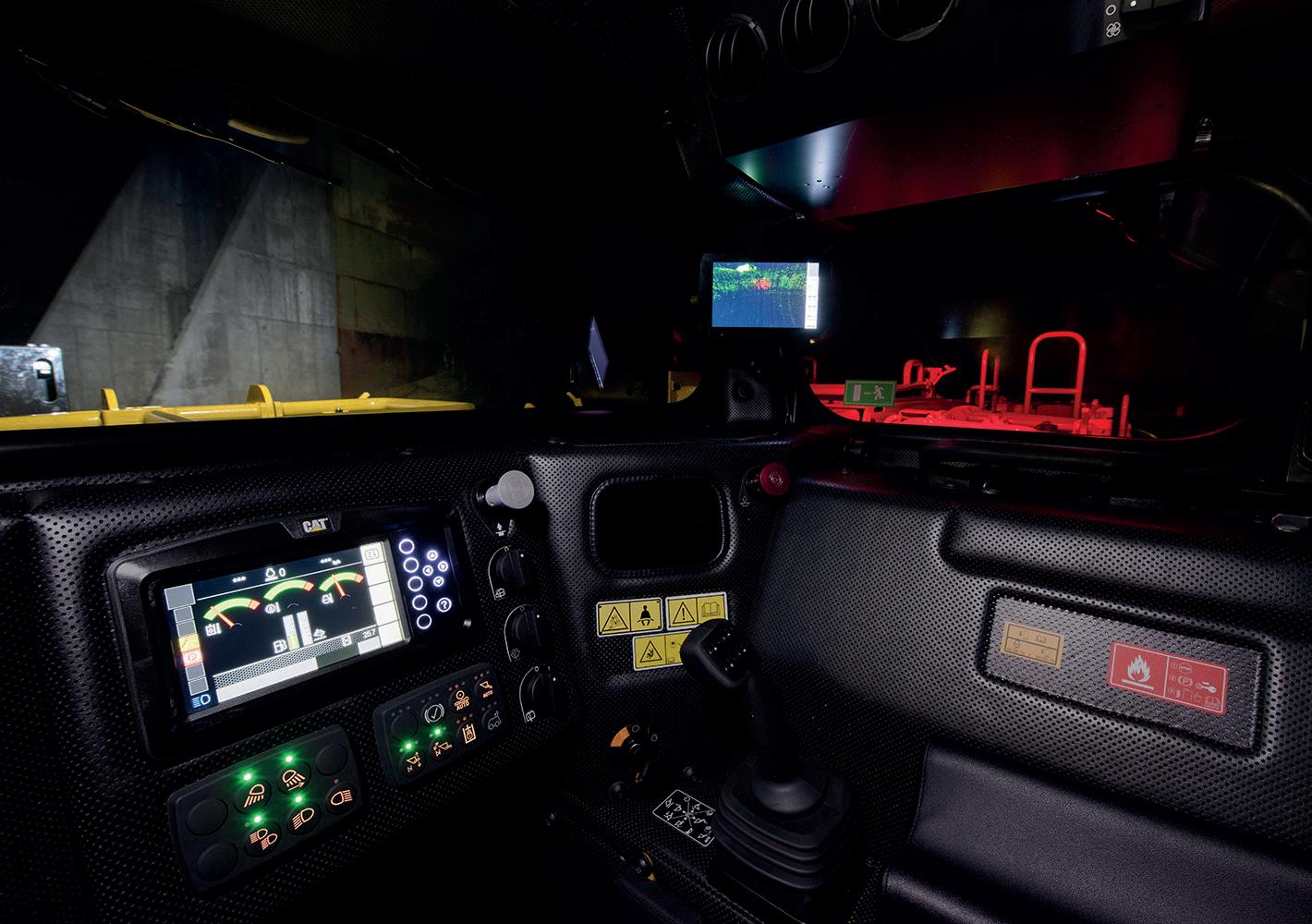
capacity over the mine’s current LHD models, and the R2900 XE delivered three-pass loading – compared to the R2900G’s four passes – of the mine’s AD60 and AD63 trucks, equipped with the mine’s preferred body size.
Compared to the R3000H
At another Australian underground mine, Caterpillar evaluated the performance of the R2900 XE against the Cat R3000H. The performance and payload study included the same draw points measured in the field follow for each loader, and material was dumped at the same tipping location at the mine’s underground crusher.
The R3000H offers a rated payload of 20 t, today the largest LHD in the Cat line, and was equipped with a 10.5 m3 bucket. The smaller R2900 XE’s rating is 18.5 t, and it was fitted with a Cat 9.2 m3 bucket for the study. Even with the smaller bucket and rated payload, the R2900 XE outperformed the larger loader as anticipated by Caterpillar.
The reasoning behind its higher productivity was in part due to the R2900 XE filling its bucket 15% faster, in just 11 seconds. Additionally, the new LHD clocked a much faster fully loaded acceleration speed with its electric drive system compared to the R3000H, delivering faster cycle times.
On top of offering higher productivity, the R2900 XE burned 13% less fuel than the R3000H over the same application. This equated to a 12% better t/l of fuel productivity result.
The mine site plans to equip its future R2900 XEs with a 9.8 m3 bucket. Using the larger bucket, the mine could realise a potential extra 6% increase in productivity gains compared to using the 9.2 m3 bucket.
Against competitive LHDs
A third Australian study pitted the R2900 XE against a competitive LHD model with a published rated payload just over 17 t. The study’s objective was to clear the same amount of material from the same specified area.
The R2900 XE cleared the area in 20 buckets compared to the competitive LHD’s 24 buckets, was 17% faster in clearing the development, and loaded the haul trucks faster. Plus, the measured operating heat generated by the R2900 XE was 7.1°C lower on level ground and 11°C lower on the decline than the competitive LHD.
In comparative working conditions, the R2900 XE had an 8% lower fuel burn rate than the competitive LHD, saving on fuel costs. The R2900 XE also delivered a 20% faster average cycle time on level ground and a 23% average cycle time advantage when travelling down the decline, compared with the competitive model.
Conclusion
Caterpillar acknowledges that the performance statistics documented can vary over applications. However, these studies show the R2900 XE has exceeded its design targets and is proving those results in the field against its R2900G predecessor, larger LHD models, and other OEMs. The Caterpillar designed, integrated, validated, and supported SR electric drive system not only offers a significant improvement in performance and productivity, but also advancements in safety, improved greenhouse gas emissions, carbon footprint reduction, and other emissions reductions.
20 March 2024 // global mining review
Figure 6. A high-resolution display gives operators real-time system information in 11 languages, while all controls, levers, switches, and gauges are positioned to maximise productivity.
Figure 5. With its 18.5 t payload, the R2900 XE provides a three to four pass match to the 63 t Cat AD63 underground mining truck.

Caroline Wies, Michelin Group, France, examines how data mining can be pushed to the next level for safer, smarter, and more sustainable mining operations.
As organisations strive to reach net zero emissions and transition to renewable energy sources, the global demand for essential metals and minerals is set to increase in the coming years. In its report ‘Minerals for Climate Action – The Mineral Intensity of the Clean Energy Transition1’, The World Bank shows that the overall demand for critical minerals such as iron, aluminium, copper, and zinc, essential to manufacture sustainable energy sources, will increase until 2050, after which annual demand will remain superior to current levels.
Mining industries across the globe are facing the challenge to respond to these increasing demands, while also trying to reduce their own environmental impact. As such, they are striving towards innovative products and solutions designed to reduce energy consumption and environmental impact in the entire mining process: from rock to metal.
Smart mines and their partners
The search to reduce their environmental impact and improve efficiencies has led mining companies to look for global partners, such as the Michelin Group, to bring evolving technologies to the mining process. This has contributed to the development of a highly connected, digital mine which includes everything from wearables on staff, in-pit equipment, monitoring devices, drone and GPS utilisation, and –increasingly – automation.
The global mining industry was one of the first sectors to recognise the value of data collection and analysis to improve safety and reach net zero emission targets. Data collection and analysis has evolved throughout the years and continues to contribute to the development of smart mines. There are many definitions of smart mines, but RWTH Aachen University’s Institute for Advanced Mining Technologies (AMT) describes
21 global mining review // March 2024
Figure 1. The Michelin Group strives to empower mining companies worldwide by developing data-driven and digitalised solutions to make their operations safer, smarter, and more sustainable.

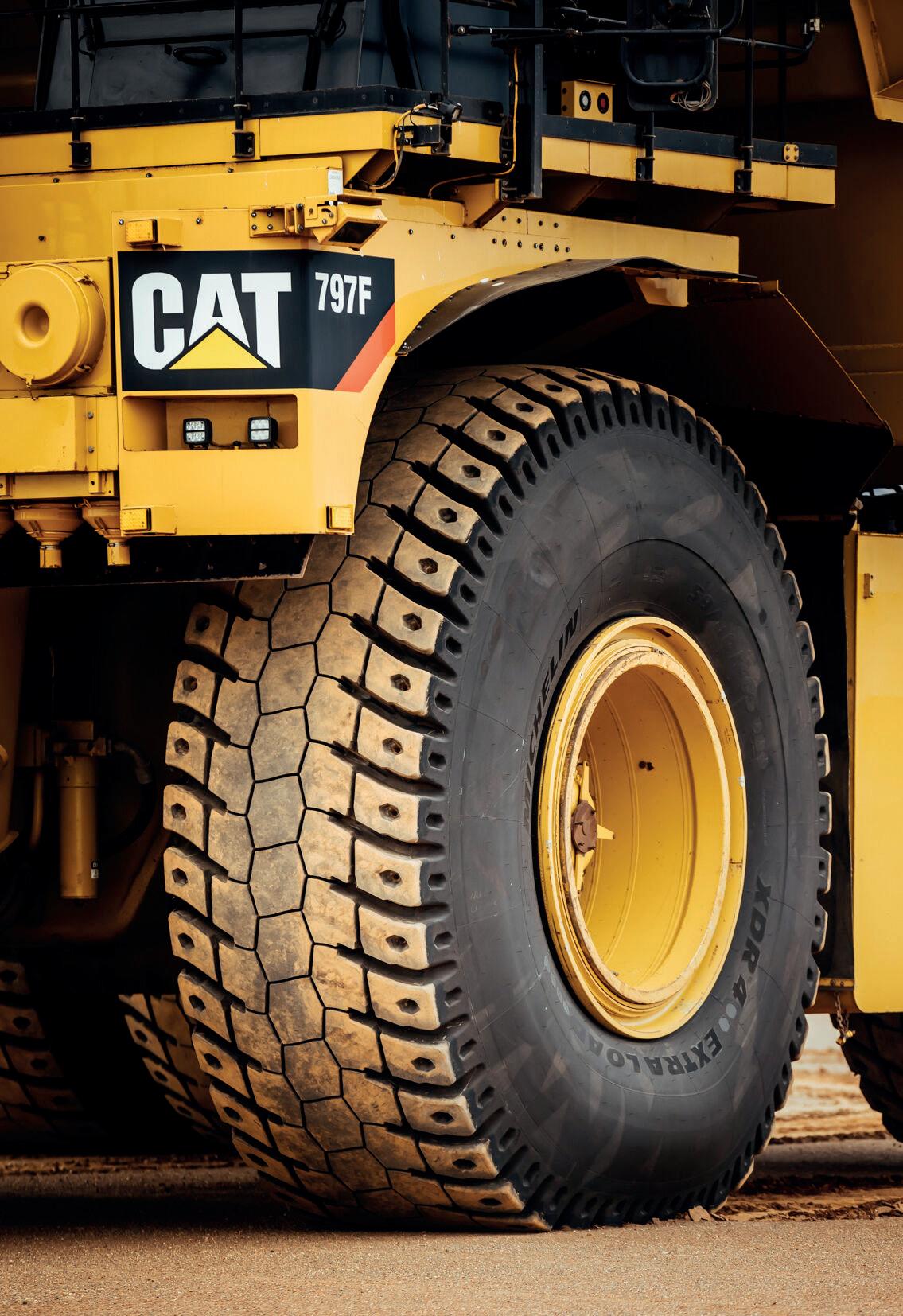
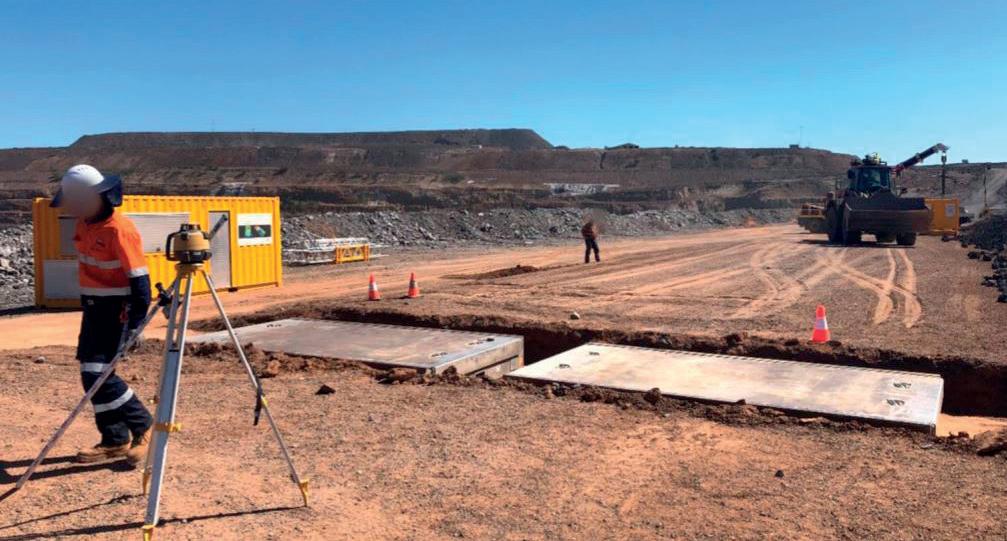
‘smart mining’ as the intelligent connection and integration of mining machines (physical components) using information and communication technologies (cyber-systems) to form so-called cyber-physical systems, where the exchange and transmission of data and information takes place via a platform.2 This definition is in line with the different technologies developed by the Michelin group around and beyond tyres.
As an example, the Tyre Pressure Monitoring System (TPMS) MICHELIN MEMS 4, designed for >51 in. mining tyres, monitors the temperature and pressure of mining tyres remotely and in real time, allowing mines to gain better fleet management performance since 2006. This fourth generation user-friendly TPMS tracks tyres but also goes beyond, providing fleet data for mines worldwide. As the only monitoring system on the market that, by design, retains historical tyre pressure and GPS tracking by tyre for detailed analysis of potential site risk factors, it offers a comprehensive and evolutive suite of over 30 reports. These can be customised, sending automatic email reporting at scheduled times to create actionable reports, as well as trending analysis.
The integration of MICHELIN MEMS 4 with autonomous truck systems offers mines unified maintenance planning and productivity optimisation. An in-depth analysis of the available data coming from the tyres and from the fleets allows for customised recommendations to improve the safety and productivity of the mine, as well as to reduce its environmental impact. With this information, mines are able to quickly react to potential issues and better keep their employees safe. Real-time monitoring also decreases unscheduled downtime and extends tyre life, meaning less raw materials are consumed. Moreover, better pressure management leads to higher fuel efficiency across a mine’s fleet.
Next level data mining for improved decision-making
Data collection and analysis are part of daily operations and are changing decision-making within mine sites. The Internet of Things (IoT) and digitisation of mines are creating quick response times, which enable operational parameters to be changed according to what is happening on site. Any deviation from a target can be quickly identified, allowing for safety, productivity, and cost efficiencies to be improved.
At Michelin, the Consulting & Services Department leverages this gathered data to answer specific questions of mines sites around and beyond tyres; such as fleet productivity, tyre management, and safety issues, based on large historical quantities of data from different sources. The consulting study output will deliver actionable advice to the mine site: short-term steps to take, essential training, KPIs to implement, and measures to consider when the mine plan changes. The knowledge, methodology, and experience of the Michelin Consulting & Services team have proven their worth for mine sites worldwide.
Case studies
Examples of consulting studies include tyre compound and tyre rotation policy recommendations and weight and volume studies, but also fleet cycle optimisation – enabling mines to take full advantage of their fleet equipment and reduce their environmental impact.
22 March 2024 // global mining review
Figure 2. The Michelin Consulting & Services team leverages gathered data to answer specific questions around and beyond tyres.
Figure 3. In-depth analysis from tyre and fleet data results in customised recommendations, no matter what brand.
Figure 4. Among many outputs, weight and volumetric studies help validate the accuracy of the loading unit onboard.
One of the mine sites that hired Michelin Consulting & Services had observed a decrease of the average tyre life over the period that it wanted to study. At the same time, the mine wanted to quantify the impact on the productivity of their rigid dump trucks after changing the vehicle body. Four different scenarios according to tyre compound and vehicle body were studied, staying within tyre load and speed limits. Analysis of up to five years of tyre monitoring and fleet management data, as well as the future mine plan, showed which specific tyre compound to use and which tyre rotation policy to implement to obtain the best results in productivity and tyre life. These actionable insights allowed the mine site to increase productivity by up to 8% and tyre life by up to 10%.
The Michelin Consulting & Services teams also regularly conduct weight and volumetric studies to validate the accuracy of the truck fleet and loading unit onboard payload measurement systems. They proceed by examining related factors that may impact a truck’s payload and productivity.
This type of study includes validating the accuracy of the mine site’s onboard payload measurement system with an acceptable tolerance of ± 5%. In one example, analysis showed contributing factors to maximising payload, including payload positioning which aids in tyre longevity and maintenance prevention, as well as axle distribution that helps avoid premature wear and endurance damage to tyres and components. This study uncovered discrepancies between the site payload target and calculated nominal target for the truck fleets.3
After analysis, it was revealed that the truck fleet had a forward loading bias in payload positioning. This type of loading contributes to premature tyre and component wear and endurance, as well as posing a safety risk, since the vehicle headboard is not structurally designed to carry payload. Most of the truck fleet and loading unit onboard systems were accurate and within tolerance. However, the study revealed a large swing in individual loads, with several trucks well above tolerance – an indicator that the mine site should investigate further to achieve greater productivity.
Conclusion
Building on its experience in the field and its innovative power, the Michelin Group, in its partnership with mining industries, continues to push forward in the coming years by developing data-driven and digitalised solutions to make operations safer, smarter, and more sustainable. The company strives to implement their Michelin Better Mining approach across the globe to help the mining industry meet the global demands for metal and minerals, reach net zero emissions, and transition to renewable energy sources.
References
1. The World Bank, ‘Minerals for Climate Action – The Mineral Intensity of the Clean Energy Transition’, The World Bank Publications, (2020), pp. 71 – 72.
2. SÖRENSON, A., and CLAUSEN, E., ‘The Future of Mining is Smart’, RWTHAachenUniversity’sInstituteforAdvancedMining Technologies, (2021), p. 1.
2. Michelin’s recommendations should be confirmed with original equipment manufacturers in all instances.


beumer.com SOME THINK THAT RAW MATERIALS TRANSPORT REQUIRES TRUCKING. WE THINK DIFFERENT. Visit us! CIM, Vancouver, Canada May 12– 15, 2024
Komatsu USA presents a framework for what an open, democratic, and interoperable ecosystem for the mining industry – that leverages technology – might look like.
Virtually every mining operation is grappling with having to drive greater value amid dwindling resources, while facing the ongoing challenges of sustainability, interoperability, productivity, reliability, and safety.
As mine operations become more complex – and the challenges and opportunities to drive greater productivity become more pronounced – no one solution provider can deliver all of the answers. To compound the situation, cycle times for developing new products, especially from a single-source provider, are long and are not keeping pace with customer demand. Moreover, operators at every level face multiple

challenges of both optimising functions and reducing the carbon footprint.
Every facet of mine planning, operations, and maintenance must be able to achieve still greater levels of performance, as measured in key performance indicators (KPIs). With this backdrop, consistency and predictability, therefore, play a major role in maintaining and achieving greater insights into productivity that can meet business forecasts around mine operations at every level – be it equipment, process, or enterprise.
Mining operations and the solutions that enhance them must be highly scalable and adaptable in order to respond to the ever-changing needs and variables on
24 March 2024 // global mining review
the ground, as well as command centres for enterprise operations. Driving optimum value by hitting variable targets, including dispatcher and operator expertise, equipment reliability, and responding to ground conditions, will ultimately impact both the top and bottom lines.
Who would benefit?
Every mining operation starts out with a plan. While smaller operations may not need automation, they still need to execute a plan that maximises functions common to all operations such as maintenance, refueling, safety, and sustainability.

As mining operations grow, things become incrementally more complex, and variables at the mine site become even more critical, requiring enhanced technology solutions. Hitting KPIs depends on multiple variables, including the skills and experience of dispatchers, equipment operators, the accuracy of road maps, weather conditions, and other factors. When bottlenecks occur, productivity can plummet, putting the best laid plans at risk.
This is where operators can benefit from an industry ecosystem that can develop agnostic solutions and tools that would optimise mining operations; automate and integrate the functions involving mixed fleet operations
25 global mining review // March 2024
(all makes and models), harness data, analytics, and hardware to realise greater performance; and act as an incubator to accelerate the deployment of advanced mining applications across an entire industry.
As all mining operations evolve, the key to their continued growth and survival will lie in having access to

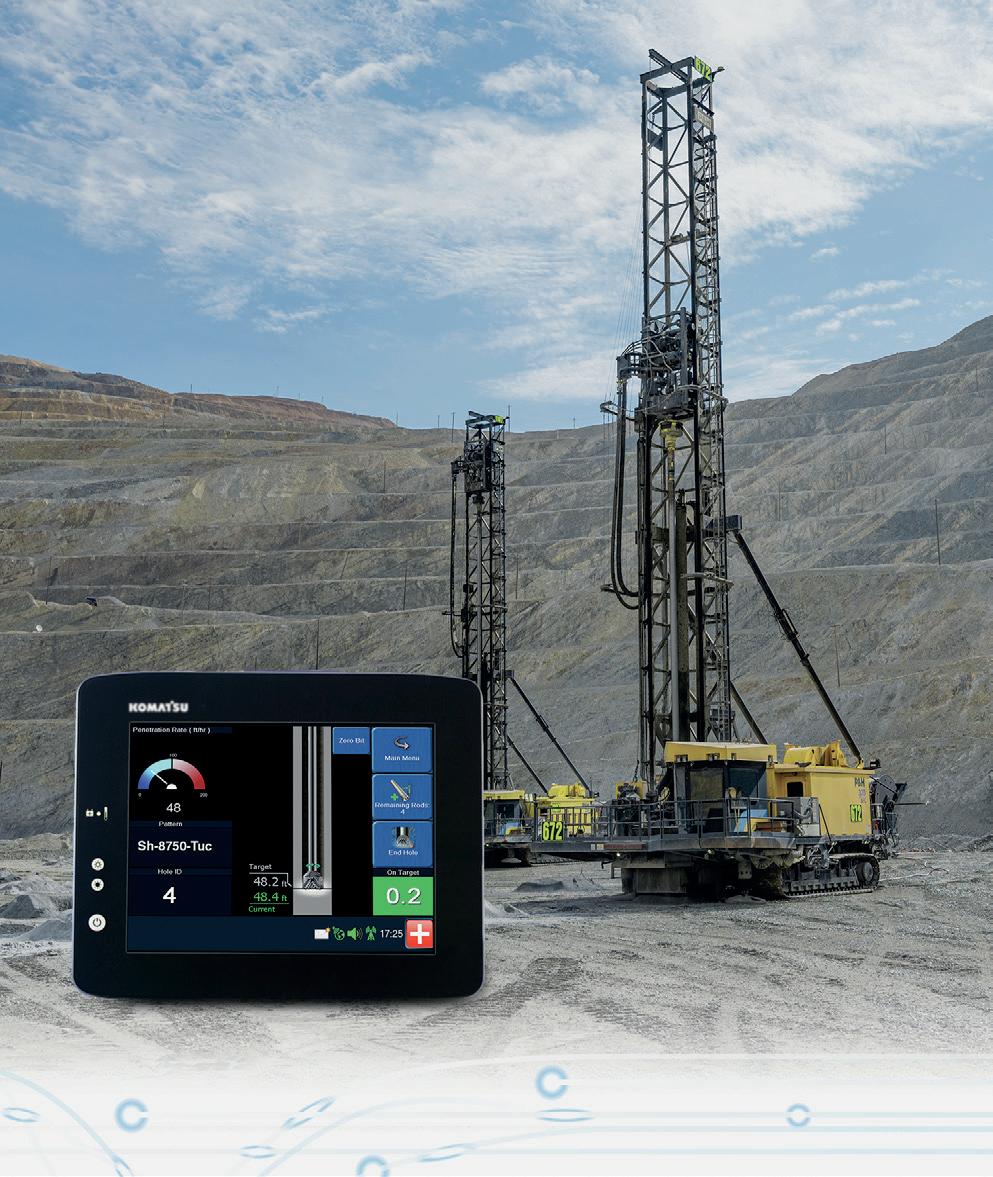
the right tools, at the right time, that an entire industry – not just one company – has to offer.
A unified user experience
A better and more evolved ecosystem is one where all companies, developers, partners, and suppliers are working together to benefit the customer; an agnostic, interoperable and open ecosystem platform that is focused on, not just on one company’s technology, but the innovation and best practices of an entire industry – while allowing individual companies to profit within this environment.
Leveraging the data, products, services, solutions, applications, and hardware of an entire industry must result in a unified user experience (UX). Instead of having multiple screens for mine planning, situational solutions, and equipment tools, each user should have a unified, simplified UX that empowers the user with one screen.
By creating a secure, open, interoperable platform where all vendors and solutions can exchange data to automate operations and share insights, an agnostic ecosystem would allow mining companies to make the most of their investments in equipment, technology, and personnel to deliver the most sustainable, predictive results.
n Equipment/task: At the task or equipment level, the ecosystem would enable third-party software and automation providers to develop applications that can share a single screen from any manufacturer.
n Mine/process: At the process or mine level, the ecosystem would populate a mine plan and apply predictive intelligence that transforms a mine plan into action, implementing several variables to a road network – for example, to align the operation with targeted KPIs.
n Enterprise: In order to deliver predictability, scalability, and sustainability across all mining operations, the ecosystem should be able to monitor all mine sites from a single location; share data and insights; and be secured by a trust framework that provides complete secure control over customer data.
n Towards a democratic ecosystem: The ecosystem needs to be entirely democratic. That is, the ecosystem should not be limited, closed off, or dedicated to one company’s brand of equipment, hardware system, or technology in order to participate. The example most often used to support this rationale is that smaller operations with a mixed fleet operation should be able to access the same level of technology and automation that enterprise operations do. Essentially, everyone is welcome and invited to have a seat at the table.
Benefits of an interoperable ecosystem
n Speed time-to-market: As mining operations grow and face big-picture challenges, like sustainability, customers are demanding quicker access to apps that address their current circumstances. An important aspect of ecosystem success will be ease-of-integration to platforms and apps within the ecosystem.
26 March 2024 // global mining review
Figure 1. Leveraging the offerings of an entire industry ecosystem demands a safe, secure, and trusted platform along with an open, interoperable, and agnostic working environment.
Figure 2. Harnessing best available technology (BAT) from an entire industry – whether at the equipment, mine, or enterprise level – means delivering critical data at the right time for more informed decision-making and more predictable outcomes.
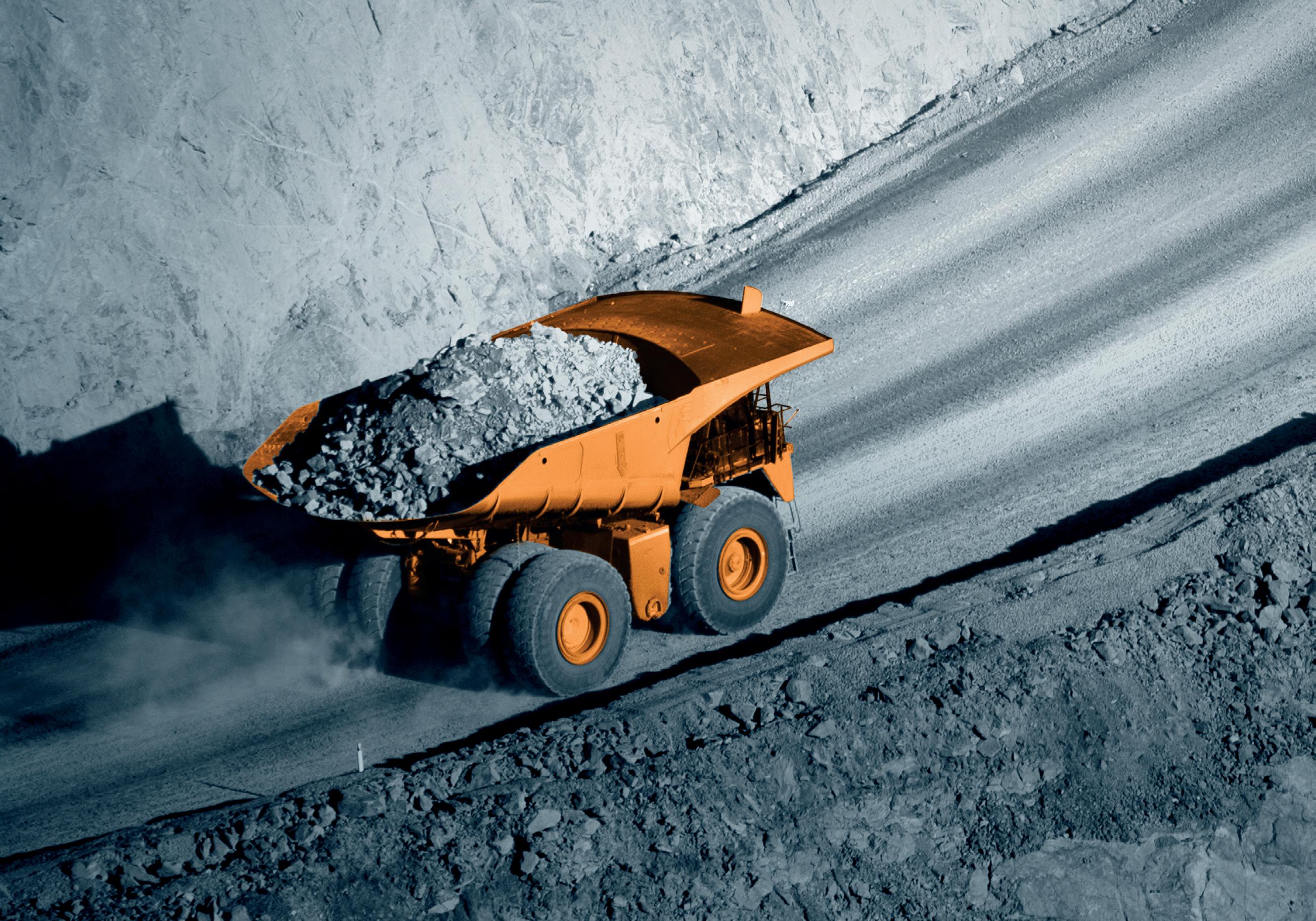
Powering progress, protecting the planet!
TotalEnergies produces high-tech lubricants for the evolving mining industry, where our innovative lubricants are the foundation for a responsible future.
TotalEnegies can help you to optimize operations, reduce TCO and the environmental impact, achieve sustainable growth.
Sustainable solutions for a brighter future.
TotalEnergies 552 006 454 RCS Nanterre - France. Photos: AdobeStock - Design: rm.lubrifiants-industrie@totalenergies.com lubricants.totalenergies.com TotalEnergies Industry Solutions
Mining Lubrication & services
Having available software development kits (SDKs) and a supporting integration framework will accelerate that process and make it easy to securely exchange data.
n Predictive intelligence: Intelligent, predictive, and adaptive tools enable operational teams to quickly make course corrections when situational factors deviate from mine plans and jeopardise KPI targets. When these factors are resolved, sophisticated tools return to the overall mine planning scenarios.
n Best-of-breed marketplace: With an open, agnostic mining ecosystem, the customer wins. Customers would no longer have to independently evaluate each company’s offerings. Instead, they would virtually have unlimited access to cutting-edge, value-added apps, products, services, solutions, offerings, hardware, and data analytics that span the entire industry – all in one holistic platform.
Ecosystem essentials
The advent of an industry-wide ecosystem would need to have a number of required infrastructure components. It would need to act as a repository for all available commercial products, solutions, and services, and their respective partner networks. To support and deliver all of these offerings – including data-driven analysis in a cloud environment – it must also provide everything in a safe, secure, and trusted environment.
n Platform security and trust: Customers, companies, developers, suppliers, and partners need to know that the system where they share their intellectual property


(IP) and data is secure. The platform is the foundation that powers the ecosystem and serves as the secure gateway. Control over data is a key component of a trust framework, so that a mine’s data is not shared or re-sold to third parties.
n Data analytics: Cloud data analytics are accessed through log-ins on a browser with a dashboard of analytics, site specific with global actionable insights that are easily accessible remotely. They would be compatible with customer clouds or partner clouds all supported by a trusted framework. The overarching goal is to leverage data to optimise entire functions at the equipment, mine, and enterprise levels.
n Application technology: Interoperable apps and tech that are compatible with other ecosystem elements – and built upon the ecosystem. Third-party partners within the ecosystem can help the mine site’s central operations to optimise everything from planning to crushing, for example. Despite having multiple screens from disparate software applications, an interoperable ecosystem would account for this and optimise and aggregate applications and data from a single screen for operators.
n Equipment optimisation: This literally refers to onboard computers, hardware, and edge devices inside equipment or light vehicles – hardware devices that are pushing, pulling, and analysing data in real-time to and from the field.
The case for an open, interoperable ecosystem
By its very nature, an ecosystem has to be ‘open’ because the systems, software, data, and hardware are not homogenous by themselves. An ecosystem that only serves the ambitions of one vendor cannot claim to be an ecosystem. An ecosystem that is confined to one party limits growth and innovation. New solution providers and innovators can thrive in an open ecosystem environment and propel it.
A long list of market analysts in business, technology, and investments have continually made the case and advocated the need for the kind of ecosystem outlined here. Given the right platform, collaboration and integration will not only nurture innovation and benefit the customer, but it will also ultimately benefit the bottom-line.
According to global tech analyst firm IDC,1 organisations must embrace digitalised, integrated industry ecosystems that can leverage shared data, application, and insights. They believe that pairing traditional partnerships with new ones that can include competitors and possibly partners from other industries can result in a highly-effective industry ecosystem.
With an open, interoperable, and agnostic ecosystem that spans an entire industry and is dedicated to solving the greatest challenges facing the industry, the future is bright.
References
1. ‘The Future of Industry Ecosystems,’ IDC, https://www.idc.com/ promo/future-of-x/industry-ecosystems
28 March 2024 // global mining review
Figure 3. A closed ecosystem or one that is confined to one or a just a handful of companies and their networks robs the mine customer of best-of-breed technologies that can optimise and enhance their operations.
Figure 4. Having access to the latest data and digital analytics, application technologies, and equipment optimisations allows mine site and enterprise operations to evaluate if they are collectively hitting their targets.
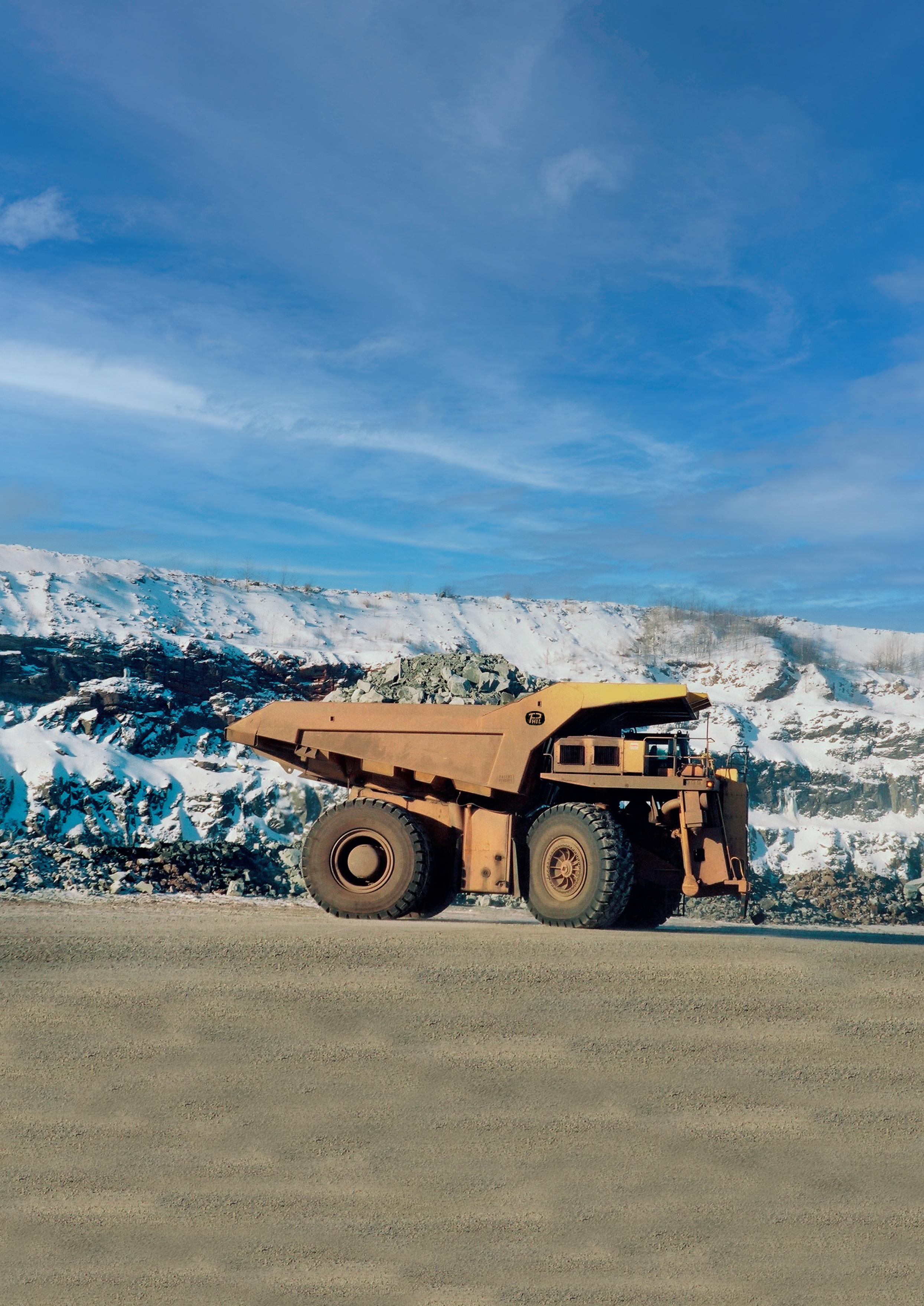
Josh Swank, Philippi-Hagenbuch, USA, describes the importance of choosing a lightweight truck body that offers all of the benefits, without the sacrifice of short wear life.
There are some things in life that make more sense, or simply become more useful, when paired together – milk and cookies, cars and heated seats, mobile phones and internet connection – the list goes on. Each of these items on their own provides some benefit – cookies taste good, cars are much faster than previous methods of transportation, and mobile phones are more convenient compared to landlines. Add in the complimentary item to each of these, though, and their benefit is elevated even more.
A similar anecdote could be applied in the mining industry when it comes to lightweight mining bodies: when a producer selects a
29 global mining review // March 2024
Figure 1. Producers can work with custom haul truck equipment companies who can take information about their needs and use it to design, engineer, and manufacture a custom truck body that accounts for a specific set of challenges and opportunities within the mining operation.
lightweight truck body for added hauling capacity, they will probably want it to last longer than three years. This makes sense, as custom truck bodies are a much more serious investment than a cookie, mobile phone, or even a car. To truly realise the full utility of one – whether lightweight or standard – there are many factors producers must consider.
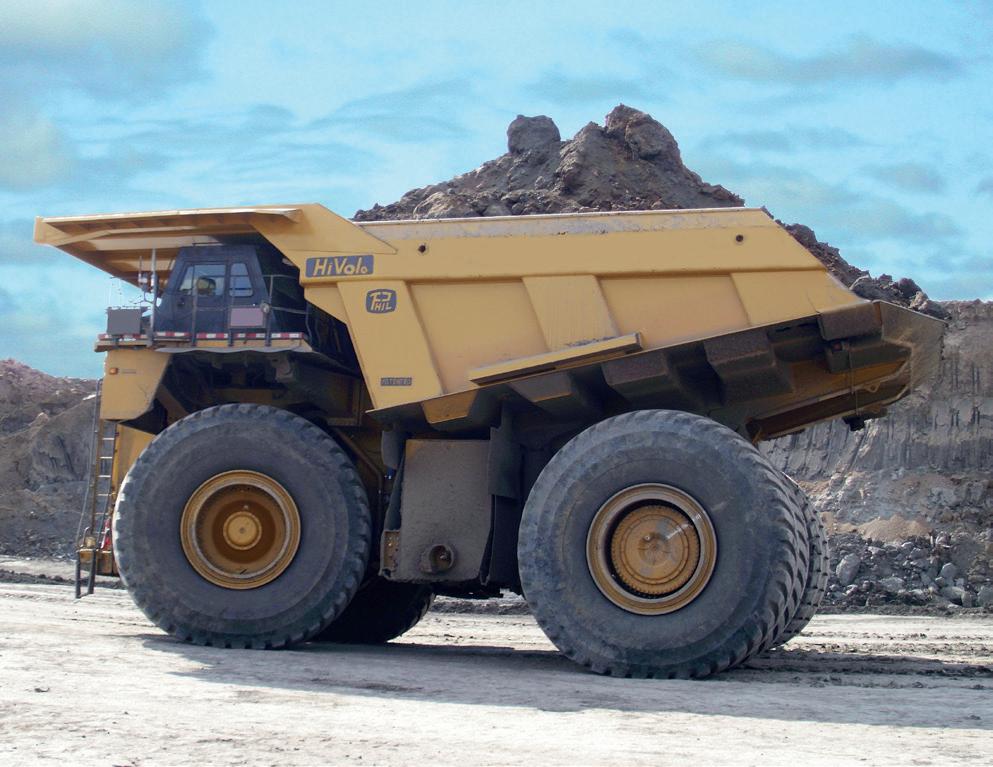
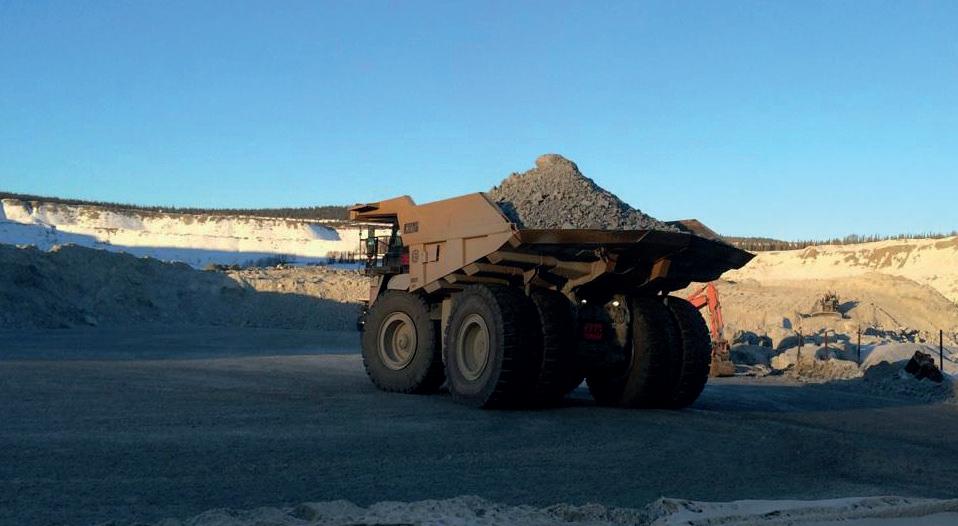
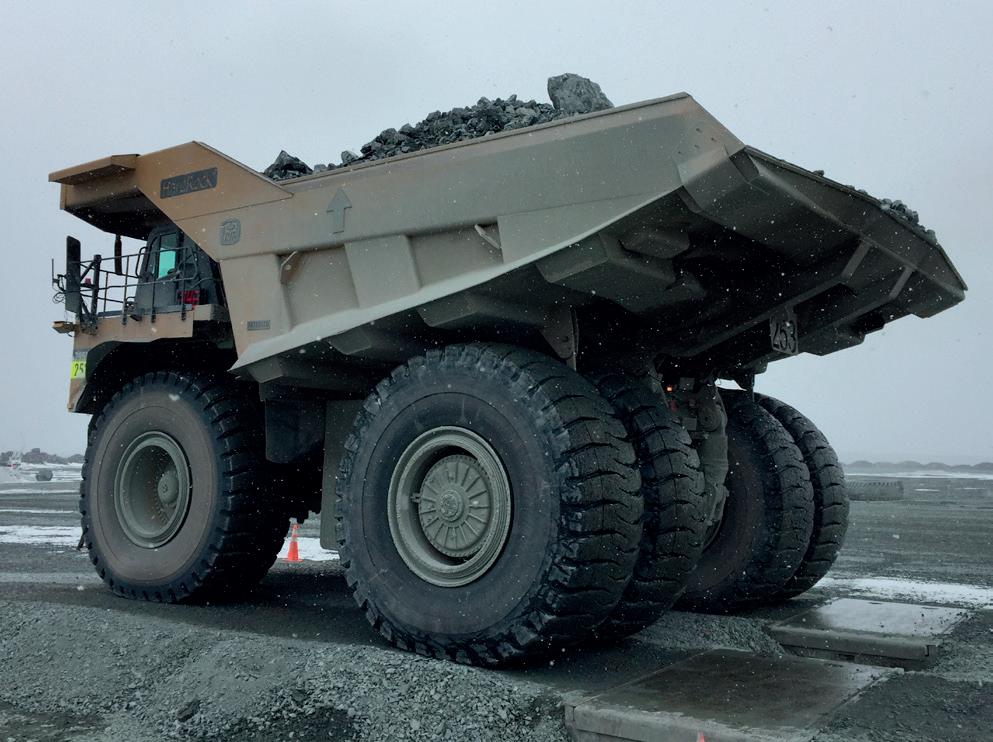
Custom vs off-the-shelf truck bodies
The first consideration when looking at lightweight bodies is whether or not a custom solution is needed to maximise productivity, or if an off-the-shelf solution is the right fit. For some operations, an off-the-shelf truck body does the job for standard operations. However, with increasing pressure for speed, efficiency, and scaled up production, the need for equipment that can support these demands becomes even more important. For producers that want to truly optimise their operation, boost profits, and meet the growing industry pressure amidst the infrastructure boom, custom mining bodies offer what standard OEM bodies and other off-the-shelf bodies cannot. Producers can work with custom haul truck equipment companies who can take information about their needs and use it to design, engineer, and manufacture a custom truck body that accounts for a specific set of challenges and opportunities within the mining operation. This is in contrast to a blanket solution that would be offered by a standard OEM body, or a supplier that has a couple designs and simply puts sideboards and liners on the body to ‘customise’ it.
Custom bodies allow producers to haul the truck’s full rated capacity by planning for material density and weight. The body can also be designed to align with the loading equipment that the operation uses and be fitted for a custom tailgate, if desired, to further increase load capacity, while shortening the body floor and addressing other environmental factors of the operation – such as overhead barriers or tight spaces. Additionally, manufacturers consider the type of material being hauled and whether it is sticky, requiring a load ejector or other custom equipment to help minimise carryback. On the other hand, abrasive material may call for different engineering requirements or the addition of liners to the body. All of these adjustments lead to an increase in hauling capacity, durability, and payload.
When deciding on a custom body, it is crucial to look for a manufacturer that focuses on increased stability and operator safety in the design of custom haul truck equipment. Custom bodies should be constructed with a low centre of gravity to ensure the best weight distribution and minimise vibration for the driver, as well as impact to the truck overall. Customising individual truck bodies to the mine’s specifications increases loading safety and greatly reduces the potential for loading damage by ensuring the truck body dimensions are correctly paired with the loading tool.
Another consideration is maintenance, and to truly maximise productivity, custom truck bodies should address this concern. Some manufacturers add four free-floating lifting eyes into the body rather than the sides, enabling fast and easy removal or installation of a body for maintenance from a lower overall height without the need for going outside and using a portable crane.
Maximising payload with lightweight bodies
One of the key goals of a custom truck body is to maximise the amount of payload an operation can haul with each pass. While coal operations often have difficulty maximising a haul truck’s capacity due to the amount of volume necessary with such lightweight material, hardrock operations often face the
30 March 2024 // global mining review
Figure 2. One of the key goals of a custom truck body is to maximise the amount of payload an operation can haul with each pass.
Figure 3. In addition to payload and wear life, producers should consider partnering with a manufacturer that looks at the big picture, including how the truck body fits into their operation while maximising operator safety.
Figure 4. Custom bodies allow producers to haul the truck’s full rated capacity by planning for material density and weight.
opposite problem. With a heavier payload and the weight of the standard mining class body, maximum gross weight is reached very quickly, limiting the amount of material hauled in each load. This provides mining operations with a dilemma: add more trucks to the haul fleet, or utilise the existing fleet more efficiently.
In years past, the solution was for manufacturers to use a thinner steel to reduce the body weight. This decrease in weight directly translated to an increase in payload capacity, as more of the haul truck’s rated weight could be allocated to the material hauled with each load. However, the lighter weight steel brought with it a shorter lifespan, often leading to the term ‘throwaway’ body. In other words, producers had to choose between increased capacity or durability. For some producers, the sacrifice in wear life of the body was worth it for the ability to haul extra material. However, eventually, the need to change out the body after just a few years would frustrate fleet managers and they would return to purchasing the heavier bodies that offered longer life and less maintenance, resulting in a swing between lightweight and standard class bodies as they searched for an optimal solution.
The best of both worlds
However, what if the pros could more easily overcome the cons? What if producers did not have to choose between capacity and durability? This is a question that drove some manufacturers to research, engineer, and create options that offer the full benefit of maximised capacity in the form of a lightweight body that lasts more than three years. Producers can distinguish these more durable options from the ‘throwaway’ lightweight mining class bodies by looking at the quality of the steel. Some of the most durable options on the market are manufactured with Hardox 500 Tuf steel, which increases abrasion resistance by three times, compared to 450 brinnell steel.
These lightweight mining class bodies offer increased wear life, while adding 10 – 20% to payload capacity. This means that a mining class body that was
previously 100 000 lb would now weigh approximately 75 000 – 80 000 lb, saving up to 25 000 lb that can be allocated to the payload. The result is an immediate gain of up to 12.5 t in payload capacity. In terms of wear life, bodies engineered with 500 Tuf steel offer up to 30% – 40% more life than traditional lightweight bodies, creating an ideal solution that maximises capacity without the extreme sacrifice in durability.
Choose all
Mine operations managers should not have to choose between maximising payload and getting the best possible life out of their truck bodies. In addition to payload and wear life, producers should consider partnering with a manufacturer that looks at the big picture, including how the truck body fits into their operation while maximising operator safety.
If a mining producer is given additional payload capacity in the form of a lightweight truck body, they will want some durability to go with it, which only makes sense.
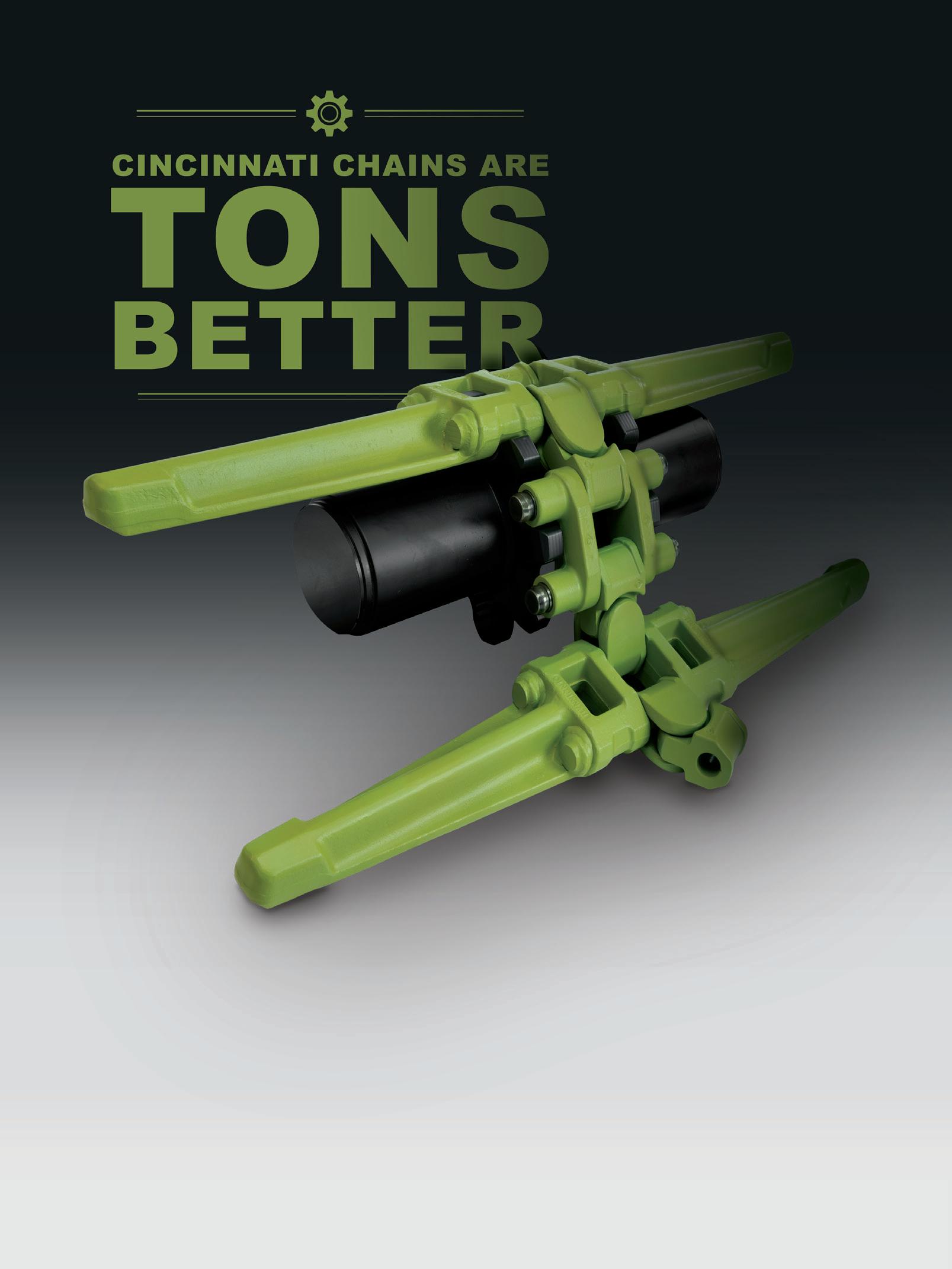
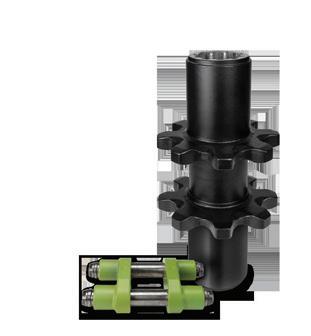
Contact us at 1•513•728•4040 or visit cinmine.com to learn more about Cincinnati Mine Machinery products. Cincinnati Dual Sprocket Conveyor Chains are proven to be b etter than other mining chains Tons better, in fact. Tests confirm our chains deliver 20 percent more strength The result is greater durability, maximum availability and a trouble-free service life. That’s how we deliver the lowest cost per ton. For 90 years, Cincinnati has proven to be THE STRONGEST LINK .
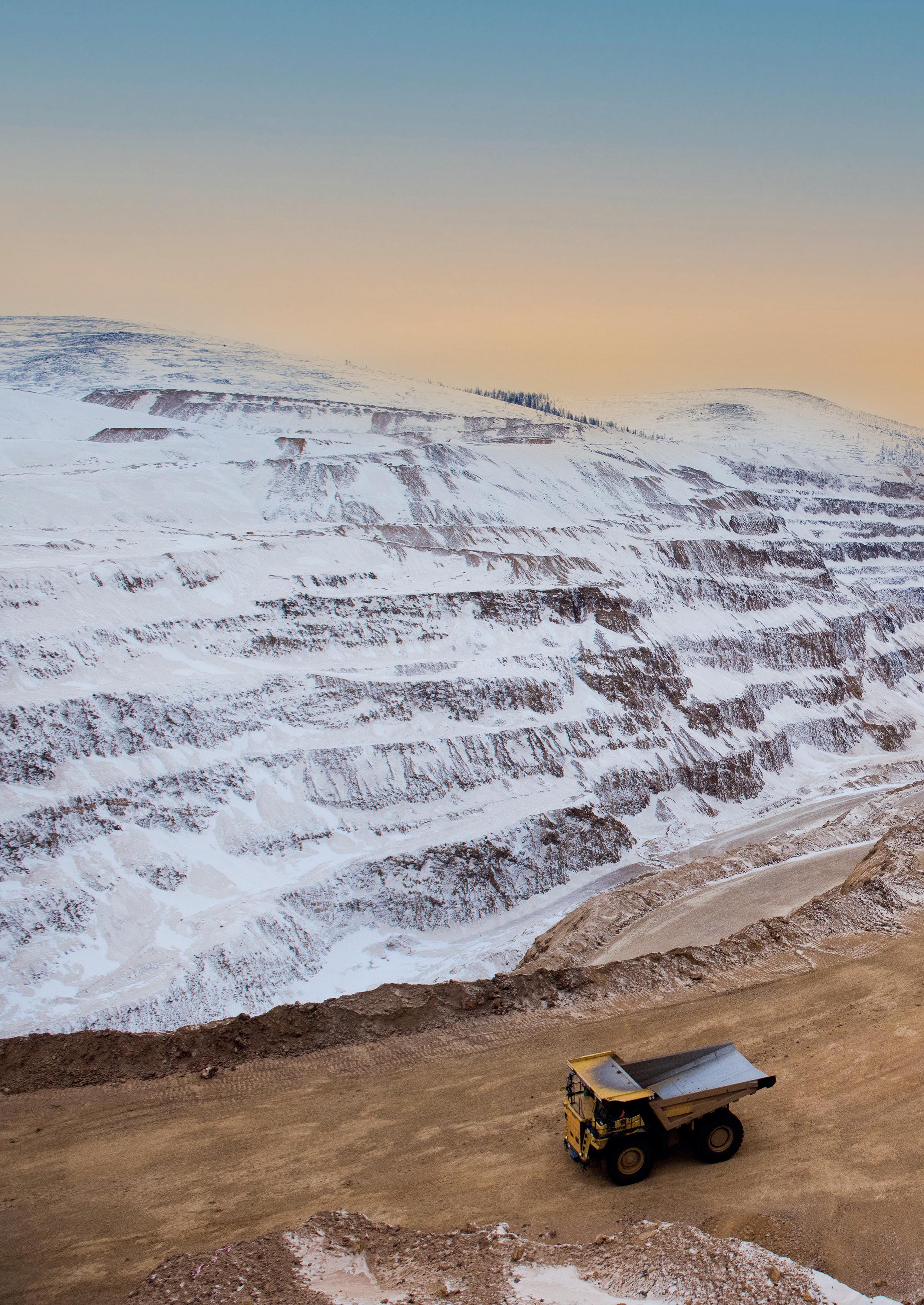
32 March 2024 // global mining review

Luiz Sampaio, TotalEnergies Lubrifiants, France, highlights the critical role of lubricants in reducing the ecological footprint of mining activities.
The mining industry, an integral driver of economic progress, finds itself at a crossroads amidst a global shift towards more sustainable energy. This transition signifies a pivotal moment, demanding innovative approaches to balance economic growth with environmental responsibility. Within this new landscape, the role of lubricants emerges with a crucial and frequently underestimated position, having significant influence over the industry’s trajectory. This article unravels the complex dimensions through which cutting-edge lubrication technologies are exerting a profound impact on the mining sector, serving as a keystone for attaining both operational efficacy and ecological sustainability.
As the mining industry moves towards aligning with energy transition goals, lubrication stands as a foundation for enhancing equipment performance, minimising wear and tear, and optimising resource utilisation. The use of advanced lubricants and mining practices not only maintains efficiency, but also contributes to the broader goal of mitigating environmental impact. This exploration delves into the intersection of lubrication technologies and mining practices, highlighting their potential to transform the industry. In doing so, the essential role lubricants play in steering the mining industry towards a sustainable and energy-efficient future will be clear.
Lubrication challenges in mining operations
The mining industry navigates complex operational challenges, each presenting difficult obstacles for lubrication systems. Mining equipment operates in environments characterised by extremes – ranging from burning desert heat to frigid places. The machinery struggles with heavy loads, ceaseless vibrations, and the constant threat of contaminants (such as dust, water, and abrasive particles). This section explores the complex challenges inherent in mining operations and examines the crucial role that lubrication plays in overcoming these adversities.
For instance, mining operations are notoriously harsh environments for equipment, presenting significant obstacles for traditional lubricants. Some of the key lubrication challenges encountered in mining include:
1. Overloading: Mining equipment is often pushed to its limits, carrying heavy loads and operating at full capacity. This puts immense pressure on lubricants, increasing friction and wear. Inadequate lubrication can lead to component failure, downtime, and costly repairs.
2. Hot and cold extremes: Mining operations can take place in scorching deserts or freezing tundras. Extreme temperatures test the limits of lubricants, causing them to break down, thicken, or thin excessively. This can lead to increased friction, decreased efficiency, and premature component failure.
3. Rain and dust: Mining sites are often exposed to elements, which with relentless rain and dust storms wreak havoc on equipment. Water can wash away lubricants, while dust can contaminate them, leading to abrasive wear and reduced performance.
33 global mining review // March 2024
Figure 1. Gold mining in the winter.
4. Contamination: Mining environments are naturally dirty, with exposure to rocks, minerals, and other contaminants. These can find their way into lubricants, clogging systems, increasing wear, and causing premature failure.
Despite these challenges, advances in lubrication technology offer solutions for mining operations. Examples of strategies are:
n Using high-performance lubricants: Formulated with special additives to withstand extreme temperatures, heavy loads, and contamination.
n Implementing automated lubrication systems: Ensure consistent and precise application, reducing waste and maximising lubricant effectiveness.
n Adopting preventive maintenance programmes: Regular inspections, oil analysis systems, and lubricant changes can identify and address issues before they lead to costly breakdowns.
n Partnering with lubrication experts: Collaborating with experienced partners can help select the right lubricants and implement effective maintenance strategies.
Lubricants as efficiency enablers
In the dynamic landscape of mining operations, advanced lubricants emerge as indispensable efficiency enablers, playing a crucial role in maximising the efficiency and productivity of heavy-duty machinery. These advanced lubrication solutions have proven to be essential in optimising performance, prolonging component life, and driving overall sustainability within this sector.


When it comes to mining, lubrication plays a key role in ensuring reliable machinery. By carefully choosing and using advanced lubricants, mining companies can significantly minimise unexpected breakdowns and disruptions. In fact, there are real-life examples where the implementation of the right lubrication solution has acted as a key factor in maintaining reliability, and ensuring continuous and efficient operation even under the most demanding conditions. Such enhanced reliability not only saves valuable time and resources by avoiding downtime, but also promotes a streamlined and efficient mining operation.
When considering the importance of longevity for components, advanced lubricants emerge as an important factor. By mitigating wear and reducing friction, these lubrication solutions protect vital components from premature deterioration. The application of high-performance lubricants has resulted in a significant increase of the lifespan of critical mining equipment. This has translated into substantial cost savings by deferring the need for frequent replacements.
Beyond reliability and longevity, advanced lubrication also leads to increased productivity within the mining industry. Reduced friction and optimised mechanical performance lead to smoother machinery operation, enhancing the throughput of mining processes. In practical terms, this efficiency translates into increased tonnage extraction, streamlined material handling, and a strengthened bottom line for mining companies.
The economic advantages of embracing advanced lubrication are clear in terms of reduced maintenance and downtime in the mining industry. By employing lubricants tailored to the specific challenges of mining environments, operators witness a visible decrease in maintenance frequency and associated costs. The ripple effect of minimised downtime amplifies these economic benefits, ensuring that mining operations remain consistently productive, thereby optimising the utilisation of resources and enhancing the industry’s overall efficiency.
Sustainable lubrication technologies
As the global focus on environmental sustainability intensifies, the mining industry is undergoing a paradigm shift towards adopting eco-friendly practices, with lubrication technologies emerging as a crucial player in this transformation. The cutting-edge developments in sustainable lubrication technologies emphasise adopting biodegradable, re-refined base oils and environmentally-friendly lubricants to align with companies’ goals to minimise their environmental footprint.
The evolution of sustainable lubrication technologies represents a critical step towards harmonising mining activities with ecological considerations. Biodegradable lubricants, formulated from renewable resources, offer a viable alternative to traditional petroleum-based counterparts. These lubricants, in some cases, not only exhibit comparable performance, but also boast the distinct advantage of being inherently less harmful to
34 March 2024 // global mining review
Figure 3. TotalEnergies’ Research Centre, Solaize, France (Credit: Laurent Cipriani – Capa – TotalEnergies).
Figure 2. Coal anthracite mine.
the environment. Mining companies have already been seen successfully transitioning to sustainable lubrication solutions, thereby reducing their reliance on non-renewable resources and diminishing the overall environmental impact of their operations.
One of the key focuses of this exploration is to illustrate the practical implementations of sustainable lubrication technologies and their tangible outcomes on both operational efficiency and environmental stewardship. In many cases, the adoption of biodegradable lubricants has led to enhanced operational performance, contributing to machinery reliability and longevity. The positive correlation between sustainable lubrication and reduced maintenance requirements is underscored, showcasing the economic advantages of such technologies.
Environmental stewardship takes centre stage as mining companies increasingly recognise the significance of mitigating their impact on surrounding ecosystems. Sustainable lubrication technologies play a crucial role in this endeavour by minimising soil and water contamination in the event of leaks or spills mainly where environmentally-friendly lubricants have been successfully implemented, resulting in a notable reduction in the ecological footprint of mining activities.
Re-refined base oil technologies
The reprocessing of used lubricating oils presents a compelling opportunity to reduce the environmental footprint of the lubrication industry. Instead of relying on virgin fossil fuels or facing improper disposal, these oils can be reborn as re-refined base oils, serving as raw materials for manufacturing new lubricants. This closed-loop approach offers significant benefits in terms of resource conservation and environmental impact reduction.
Firstly, re-refining mitigates dependence on virgin crude oil, a finite resource whose extraction and processing carry substantial environmental burdens. By utilising used oils as feedstock, the demand for newly drilled oil is lessened, thereby slowing the depletion of this valuable resource.
Furthermore, the re-refining process itself demonstrably requires less energy compared to conventional oil refining. This translates to a smaller carbon footprint for lubricants formulated with re-refined base oils, contributing to a reduction in greenhouse gas emissions and overall environmental burden.
Beyond resource conservation and energy efficiency, reprocessing used oils reduces the risk of environmental contamination. Improper disposal of used oils, such as landfilling or uncontrolled burning, poses a significant threat to soil, water, and air quality. Re-refining diverts these oils from such harmful pathways, promoting responsible waste management practices and safeguarding environmental health.
The environmental benefits of re-refined base oils are further amplified by ongoing advancements in re-refining technologies. Improved filtration techniques, selective solvent extraction, and catalytic hydro-processing technologies consistently enhance the efficiency and environmental impact of this valuable recycling process.
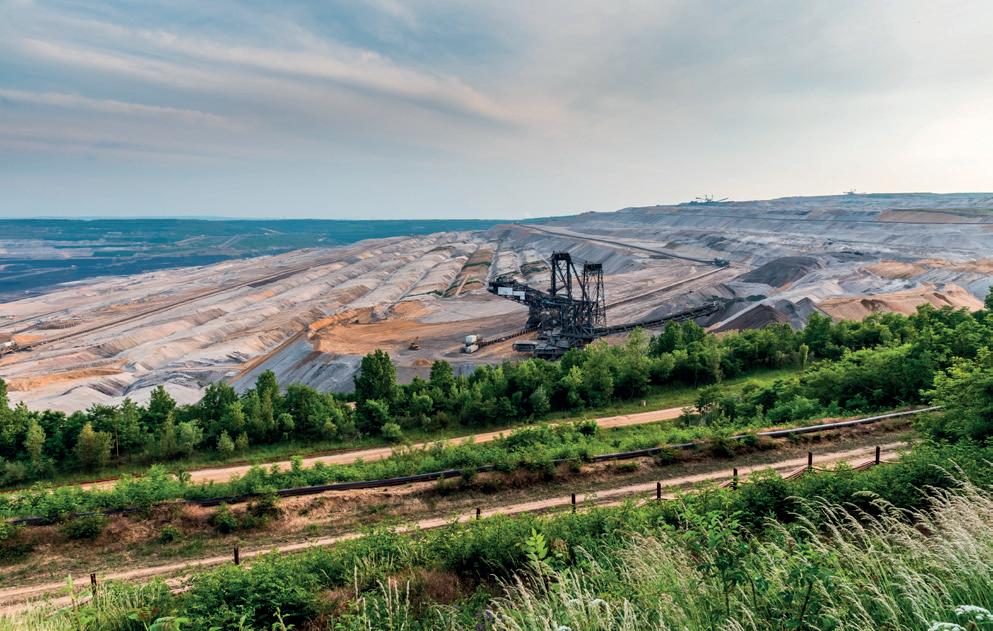
Challenges and opportunities
While sustainable lubrication technologies present a compelling environmental path for mining operations, some challenges remain. Biodegradable lubes, for instance, may not always match the performance of traditional counterparts in all applications. Additionally, re-refined base oil technologies require robust collection and processing infrastructure, which may not be readily available in all regions.
Despite these challenges, the future of sustainable lubrication technologies appears promising. Continuous advancements in lubricant formulations and raw materials manufacturing techniques are overcoming performance limitations. As far as re-refined oils are concerned, infrastructure development is steadily addressing waste oil collection and reprocessing hurdles, as more stringent regulatory frameworks develop.
In this context of growing environmental regulations and societal push for greener solutions, adopting sustainable lubrication technologies in the mining industry is poised to accelerate, paving the way for a more responsible and sustainable future.
Conclusion
This comprehensive analysis highlights the critical role of lubricants in designing a sustainable future for the mining industry. As demonstrated in the previous sections, lubricants act as multifaceted supporting materials, addressing challenges from extreme operational conditions to wear protection, equipment longevity, and maintenance optimisation.
Often underestimated, lubricants are proving to be performance enhancers, playing an important role in enhancing machinery reliability, prolonging component life, and ultimately boosting overall productivity in mining operations. The integration of advanced lubrication technologies, including sustainable and eco-friendly options, indicates a revolutionary shift towards aligning mining practices with environmental responsibility.
The exploration of sustainable lubrication technologies highlights an essential step towards environmental stewardship. The biodegradable lubricants and environmentally-friendly solutions discussed throughout this article reveal successful implementations that reduce the ecological footprint of mining activities.
35 global mining review // March 2024
Figure 4. Opencast mine in the Rhine area.

DISCOVER THE LATEST MINING EQUIPMENT AND TECHNOLOGY.
MINExpo INTERNATIONAL 2024 is coming back to Las Vegas! At the world’s largest global mining event, you will uncover new products and transformative technology that can help you increase productivity and safety.
Massive machinery. Innovative solutions. Essential resources. Every element from exploration, planning and processing to safety, sustainability and reclamation is here
Learn more at MINExpo.com.

Elitza Terzova, Shell Lubricant Solutions, outlines the four factors that could shape the future of mining and the importance of collaboration in addressing key challenges.
Miners face an unprecedented challenge. The world relies on them for the materials that power the advanced digital businesses of today, while supporting the drive towards a zero-emissions tomorrow.
By 2050, annual copper demand will more than double.1 Decarbonising transport alone will require a six-fold increase in global lithium production.2 Whether it is the transition to electric vehicles (EVs) or renewable energy, mining is crucial to a more sustainable, advanced, and digitalised future.
Additionally, miners are under pressure to deliver on their own commercial and sustainability goals, as they must produce more while emitting less. Consequently, the challenge lies in finding feasible ways to achieve this.
‘Breaking New Ground: Shaping a Successful Future for Mining’, a new whitepaper from Shell, explores the biggest challenges facing miners over the next 3 – 5 years and examines how they can overcome them.3 Building on more than 500 interviews with mining decision-makers worldwide, it provides insights into how mines can operate more productively and sustainably – while accelerating the digitalisation of operations and addressing a growing skills shortage.
Four challenges that miners must overcome
To meet society’s and industries’ needs and achieve their own ambitions, miners must focus on four critical areas:
1. Delivering more cost-effective site operations
Cost is miners’ number-one priority over the next 3 – 5 years. One in three (33%) say the rising cost of consumables (e.g. fuel and lubricants) will have the biggest impact on site operations.4 One in five (19%) identify supply disruption and production shortages (18%) as major concerns.4
Despite this, 21% believe that addressing shareholder demand to increase profits and maintain low operating costs will remain a top priority for their business.4 This is especially challenging, as soaring inflation and talent costs are significantly increasing mining overheads, squeezing productivity, and delaying expansion plans.5
There might be no easy route, but working towards more cost-effective operations is a journey that all miners will need to make if they are to set themselves up for success in the future.
37 global mining review // March 2024
2. Reducing environmental impact and CO2 emissions
In addition to meeting commercial targets, miners must prioritise sustainability. Pressure to reduce CO2 emissions is the factor that will have the biggest impact, say 26% of miners. However, emissions are not the only element they need to address.4
Water and soil contamination are also key issues. A quarter of miners cite society expectations (25%) and regulatory influence (23%) as factors that will shape their operations.3 Miners are also facing increasing demands to improve the way they assess risks and opportunities, and to become more rigorous in their reporting.5
The opportunity miners should not overlook is how more sustainable operations can also be more profitable. Businesses with higher environmental, social, and governance (ESG) ratings on the MSCI index (a leading provider of investment research

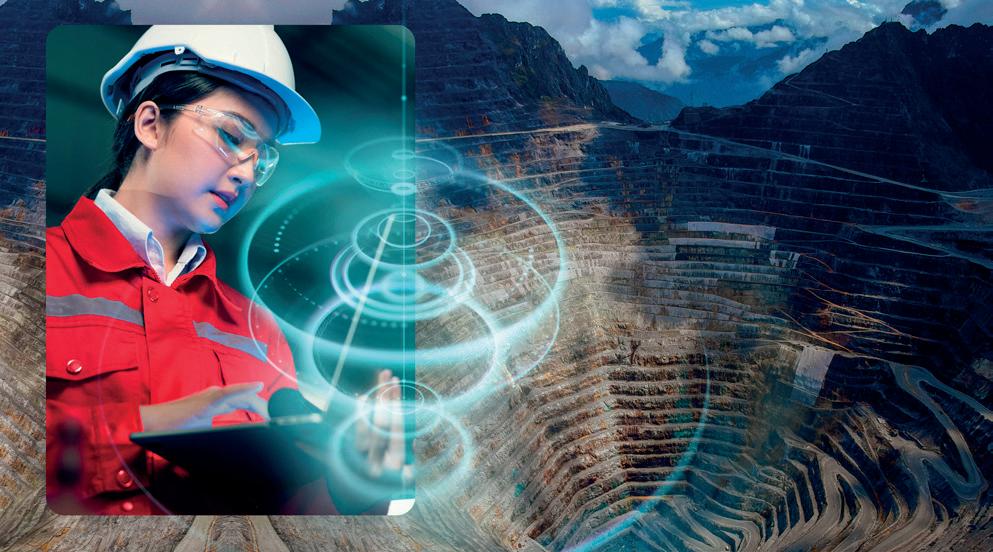

and tools) showed a 10% higher-than-average shareholder return.3
3. Accelerating the digitalisation of mining site operations
Because of its importance in enabling productivity and sustainability, the digitalisation of mining is picking up speed. Miners are looking to new digital tools and technologies to help them build smarter mines, automate processes, and unlock efficiency gains. Three-quarters (75%) are already investing in digital tools to drive operational efficiency, or plan to do so in the next two years.4
While digital technology is already a key enabler for mining, it will continue to be a disruptor as well. Roughly a quarter (24%) of miners see the emergence of technologically advanced equipment as a significant change they must adapt to in the next 3 – 5 years.4 The next challenge will be adopting the tools behind smart mining to scale operations. Not only could this help to reduce emissions by 20%,6 it could also help the sector save up to US$390 billion each year.7 Digitalisation is key to improving operational efficiency, so mines can meet their commercial and sustainability goals.
4. Addressing the shortage of new skills required across the sector
Digitalisation can significantly improve mining productivity and sustainability, but it is also a challenge. Miners face an acute skills shortage – particularly in digital. As digital tools become increasingly integrated into their mining site operations, the demand for people with the relevant digital and data skills grows. Along with the gathering transition to data-centric, autonomous, and remote operations, this shift is changing the skills profile needed for mining.3
One in five (20%) of the mining leaders surveyed expressed concern about their workforce lacking these digital skills or qualifications.4 Most mines (78%) are working to train their workforces on digitalisation and sustainability practices to tackle the issue, but 75% are still not confident in their ability to resolve the current labour shortage.4
Cross-sector collaboration is essential to mining success
Three-quarters of miners do not feel well-equipped to tackle the challenge of rising costs and 71% say they are not ready to handle the pressure they face to reduce CO2 emissions.4 The reality is that they face a complex range of issues, and no single site or business can master the challenges alone.
Collaboration will be critical to future mining success. Miners must work closely with expert collaborators to deliver the solutions and support needed to improve operational efficiency. Similarly, it will take sector-wide cooperation to scale up and accelerate the decarbonisation of the mining industry. It is why collaborative initiatives, such as the Charge On Innovation Challenge8 and the Charging Interface Initiative (CharIN) Mining Taskforce, are so important.9,10
Driving operational efficiencies through effective maintenance
As the whitepaper showcases, there is a clear way forward for mines to break new ground and achieve their objectives for
38 March 2024 // global mining review
Figure 1. Digitalisation in the mining industry.
Figure 2. Digitalisation and opencast mining.
Figure 3. Sustainability in the mining industry.
the future. The common element of efficiency will be vital in helping miners to understand that they do not have to compromise their commercial or decarbonisation ambitions. An efficient mine can be both productive and sustainable.
To control rising costs and deliver greater sustainability, miners must operate more efficiently with the equipment they have today. Equipment health is critical in driving productivity and sustainability. While the cost of consumables such as lubricants might be rising, they can still deliver savings when used effectively, and they have the potential to both reduce emissions and total cost of ownership (TCO). Therefore, lubricants have a much larger impact on the overall site performance than their mere cost. However, 60% of miners agree that senior stakeholders do not give lubricants selection and management the importance it deserves.4 A scientific approach to equipment lubrication and a data-driven lubrication regime, together with high-performing lubricants tailored to the task and the application, can extend equipment life, improve productivity, and minimise unplanned downtime. Additionally, the better the lubrication regime, the less energy is lost due to friction. This improves fuel efficiency, which reduces emissions. Adopting carbon-compensated and biodegradable lubricants can help cut emissions even more.
Moreover, working with the right lubricant supplier, mines can build a digital ecosystem to gather performance data from critical equipment and subsystems. Using this data – both historical and real-time – miners can improve the performance and reliability of equipment across the whole operation,
while also tackling the growing skills gap in the industry by working with trusted collaborators.
References
1. ‘Looming Copper Supply Shortfalls Present a Challenge to Achieving Net-Zero 2050 Goals, S&P Global Study Finds’, S&P Global, (14 July 2022), https://press.spglobal.com/2022-07-14-Looming-Copper-SupplyShortfalls-Present-a-Challenge-to-Achieving-Net-Zero-2050-Goals,-S-PGlobal-Study-Finds
2. ‘Mining vital in net-zero transition’, MiningWeekly, (27 January 2023), https://www.miningweekly.com/article/mining-vital-in-net-zerotransition-2023-01-27
3. ‘Breaking New Ground: Shaping a Successful Future for Mining’, Shell, (2023), shell.com/mining
4. Based on a survey to 561 decision makers in the mining industry across 7 markets in July 2022. The survey was commissioned by Shell Lubricants Solutions and conducted by research firm Edelman Intelligence.
5. MITCHELL, P., ‘Top 10 business risks and opportunities for mining and metals in 2023’, EY, (26 September 2022), https://www.ey.com/en_gl/ mining-metals/risks-opportunities
6. GEORGE, M., O’REGAN, K., and HOLST, A., ‘Digital solutions can reduce global emissions by up to 20%. Here’s how’ WEF, (23 May 2022), https://www.weforum.org/agenda/2022/05/how-digital-solutions-canreduce-global-emissions/
7. ELLIS, D., ‘Top 10 technologies and strategies in mining’, MiningDigital, (14 July 2022), https://miningdigital.com/top10/top-10technologies-and-trends-in-mining
8. ‘Winning Technology Innovators Announced’, ChargeOnInnovation Challenge, (12 May 2022), https://chargeoninnovation.com/winningtechnology-innovators-announced/
9. ‘Charging the mining industry into an electric future’, CharIn, (27 September 2022), https://www.charin.global/news/chargingthe-mining-industry-into-an-electric-future/
10. ‘Shell Joins Mining Taskforce to Drive Net-zero Mobile Fleets’ AzoMining, (31 March 2023), https://www.azomining.com/News.aspx?newsID=17401
Can’t Make It Rain…. But We Can Help Ease The Pain!
Evaporation is a major cause of water losses from farm dams and other water bodies during summer. WaterGuard GOLD is a silicone-based liquid which spreads across the water surface to form a very thin film and reduce evaporation.
Trials using WaterGuard GOLD have achieved evaporation savings of 50% or more.



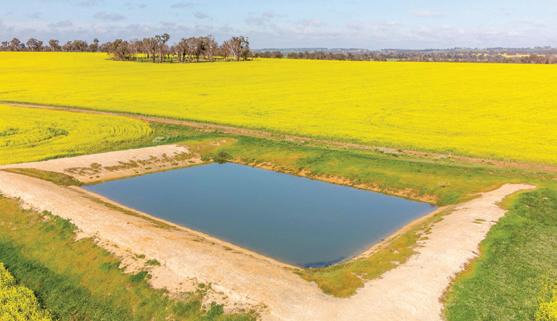

Enquiries: Danny Bryan (Australia) Cell: +61 497 436 848 Email: danny@aquatain.com www.aquatain.com
Easy to apply Cost-effective Safe for the Environment
We

ELECTRIFICATION IN MINING 2024

VIRTUAL CONFERENCE16TH APRIL 2024
FIND

bit.ly/49ytkos
OUT MORE
Jim Thomas, Lubrication Engineers, USA, addresses how the right choice of lubricant can boost operational efficiency and prevent costly failures.
After repeated failures of its crushers caused production losses, a large copper mine’s Maintenance & Reliability Team knew something had to change. In this case, it was the gear oil protecting its bushings. With this one change, they increased equipment availability to production by 2.2% – a remarkable improvement in the mining world. They also reduced lubricant usage by 83%, resulting in cost savings and a reduction in safety risks and carbon footprint. Total annual savings exceeded US$2.8 million.
The mine, located in South America, was having to undertake full rebuilds up to five times a year on the bushings of each of its two primary crushers, resulting in excessive production losses. The mine processes more than 280 000 t/d with these two crushers. This excessive unplanned downtime was largely caused by tramp metal ingested by the crushers.

When either of these two crushers ingests a shovel tooth or other metal object greater than 9 in., it typically causes irreparable bushing damage, which necessitates full rebuilds (Figures 2 and 3).
The crusher in Figures 2 – 5 had been lubricated with a ‘premium’ gear oil, which was filtered with a 20 µm filtration system. ISO particle counts typically ran at 24/22/18. The introduction of tramp metal initiated extreme pressures and temperatures that would last as long as needed for the metal to clear itself. Once, the crusher came to a complete stop due to the sheer size and mass of the ingested metal. Each of these tramp metal incidents started a cascade of events that literally toasted the bushing and its base plate.
When looking at these failures, it is helpful to focus on the particles generated from the tramp metal ingestions.
41 global mining review // March 2024
Figure 1. This large South American copper mine has two primary crushers feeding its process line. Collectively, the line processes over 280 000 t/d.
Other sources of contamination were also present, but they were insignificant in comparison to the tramp metal.
Lubricant failure leads to primary and secondary damage
The oil’s foremost responsibility is to keep lubricated metal surfaces from touching each other. When the oil fails at this task, contamination particles are generated and certain types of wear appear on the metal surfaces. This wear can be classified as ‘primary damage’. Particles created from primary damage can be very abrasive depending on their source. Those formed from soft bearing material might be the least destructive, while those formed from hardened steel are especially destructive.
Particles from primary damage tend to create their own damage by lodging between metal surfaces and creating


new particles. This is ‘secondary damage’, and is a direct result of particles from primary damage creating additional particles in a cascade effect. During the life of an oil change, the cascade can go as high as 19:1 in a diesel engine. Gear trains are less, but 10:1 is not unusual.
Stopping the primary damage will have a large impact on the amount of secondary damage. When comparing Figure 4 to Figure 6, it is evident that the extreme pressure additive in the lubricant is imperative to the lubricant’s success. The EP additive in the gear oil being used in the crushers had failed to stop metal-to-metal contact. The resulting particle generation was immense, as was the creation of secondary damage particles that followed.
Each tramp metal event caused the level of damage shown in Figures 2 – 5. The mine’s Maintenance & Reliability Team thought it was impossible for gear oil to do anything to stop such catastrophic failures. They examined the current physical procedures on tramp metal elimination and determined they were at a high standard, with only minor tweaking required to maximise current processes.
The only exception was the older stockpiled material they occasionally used. Although purported to be clean, its composition is largely unknown with respect to tramp metal. It had been accumulated before current tramp metal remediation practices were applied. The mine has a significant amount of this stockpiled material that requires processing. Given the sheer volume of this material, it must be processed with the two crushers. The challenge for the team was to stop the crusher failures.
The crushers are considered critical assets, for which unplanned downtime has severe production and cost consequences. Ongoing losses associated with this problem had to be resolved, and could not be considered business as usual. Given the stockpiled material could not be improved, focus was directed toward the bushing destruction and what, if any, preventative options were available.
It was determined the gear oil being used to protect the bushing could not withstand the spike in extreme pressure caused by a sudden stoppage of the mantle. Therefore, it was time to look at oil again. The crushers were critical assets that required a critical lubricant, as repeated failures had demonstrated that routine lubricants were not meeting their needs.
After the team tried various suppliers’ maximum pressure gear oil products with no discernible difference, the mine’s senior reliability superintendent approached Jim Thomas of Lubrication Engineers (LE) about this issue. Thomas had supported several North and South American mine sites for over a decade with lubrication, filtration, and monitoring devices and has achieved previous success with this application.
The superintendent said that the mine continued to have significant issues with the crushers’ inner bushings, where tooth ingestion created significant metal debris and high return oil temperatures. He added it was common for them to change this bushing due to it being burned.
He stated this problem would likely prevent the mine from achieving their next planned maintenance interval, which was becoming the norm. It also was having a significant negative impact on its ability for continual processing downstream.
42 March 2024 // global mining review
Figure 3. The outer bushing surface shows severe damage from extreme pressures, high temperatures, and burnt oil.
Figure 2. The crusher’s 110 t mantle is extracted, exposing the damaged bushing.
New oil puts stop to failures
As an initial measure, Thomas suggested conducting a trial with a synthetic gear oil containing a unique and proprietary extreme pressure additive – Duolec – which was developed by LE and is not available from other suppliers.
The result of this trial was an immediate halt to the catastrophic failures. After the new oil was applied, the tramp metal ingestions continued, including four more from shovel teeth and a large steel plate. One of these ingestions even brought the system to a complete halt; however, the new gear oil – Duolec Syn Gear Lubricant – protected the bushing, and no rebuilds were required after clearance was achieved. The convex bearing and base plate were also unscathed.
The oil and its additive package put a stop to nearly 90% of the primary damage. Figure 6 shows the immediate impact of this. Current ISO readings are 20/18/16 and relatively steady. Secondary damage remained the same because the filtration system was not changed.
Critical assets require the right lubricants to minimise unplanned downtime and costs. Each bushing change costs US$360 000 in lost production, parts, and labour. During the past 12 months since implementing use of the advanced EP gear oil, the mine’s two crushers combined have avoided eight rebuilds.
After one year, the Maintenance & Reliability Team has documented the following results:
n Total annual savings exceeded US$2.8 million.
n Availability to production increased by 2.2%.
n Payback was achieved in less than two months.
n Lubricant usage dropped from 12 000 to 2000 gal./y for both crushers, resulting in cost savings, as well as a reduced carbon footprint.
n Safety risks lowered due to less unplanned maintenance.
Next step: Filtration and monitoring
With regards to secondary damage, the expense of the lubricant can be defrayed if it is kept clean, cool, and dry. Superior filtration can enable use of the same oil for up to five years, while upgrading the filtration system would further improve the mine’s results.
A new depth media filtration system – CCJensen HDU 4x27x108 – is set to be added to the mine, which will remove 99% or more of particles to 3 µm. This will greatly reduce secondary damage and effectively extend the oil life to five years.
An oil monitoring system will provide insight into real time oil contamination levels (ISO 4406), water intrusion, oxidation, temperature, and pressure. With the addition of VeriTAI vibration analysis, the programme can provide up to three months of advanced notice of impending maintenance issues, giving the Maintenance & Reliability Team time to plan. It also answers the question of whether the equipment will keep running until the next planned maintenance.
Lubrication is a very small part of an operating budget, typically 3 – 5%. However, it literally touches every rotating and moving surface. In this case, use of the LE gear oil for the critical asset added 2.2% availability to production for a relatively small increase in cost with a payback of less than two months. This kind of leverage can be available for any critical asset.


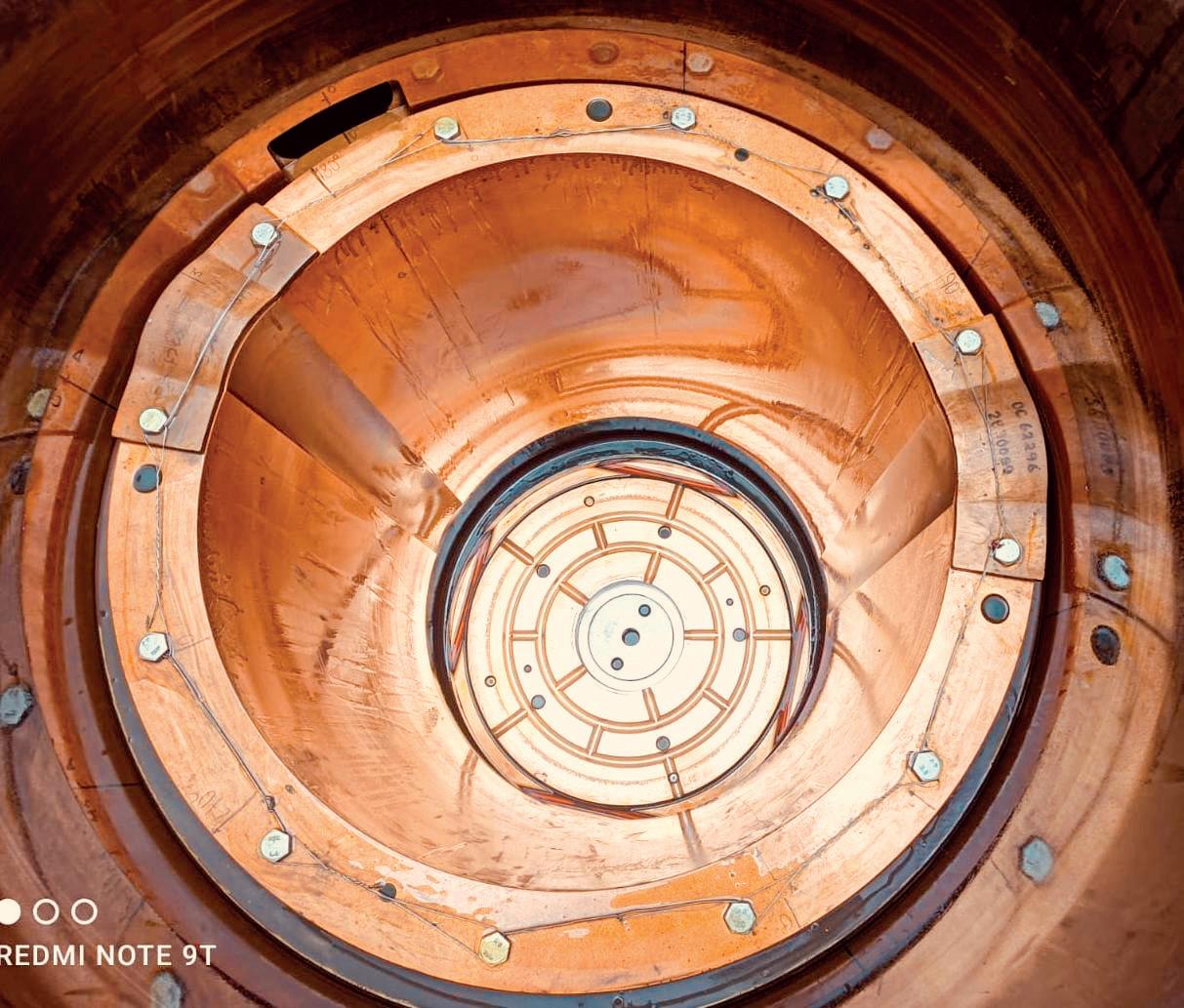
43 global mining review // March 2024
Figure 4. The scorched inner bushing surface shows long structural cracks, with the longest being 4 ft in length.
Figure 5. Scorched oil-races on base plate bearing of the mantle shaft.
Figure 6. Eight months and five tramp metal ingestions later, the crusher’s inner bushing remains in good condition.
Join us for 3 days of immersive program where you can elevate your expertise with:
Expert-led short courses
An educational technical program
Innovative panel sessions Technical presentations
Join us for social events to increase your network and connect with industry leaders.
Tap into targeted opportunities to capture leads and engage with the mining industry face-to-face!


Our annual event is back under a new name: CIM Connect convention.cim.org REGISTER NOW! VANCOUVER CONVENTION CENTRE, WEST BUILDING May, 2024
American Pacific Mining Corp. provides an update on its portfolio growth in the western US; with joint venture partnerships with industry majors in Alaska and Nevada, the Canadian junior miner has expansion plans for precious and base metals opportunities.
Staying true to its mission to “grow by the drill bit and by acquisition”, American Pacific continued to prove its reputation in 2023 as a mining David that wins over industry Goliaths. An acquisition agreement inked last year added three more promising gold projects in top-tier mining districts in Nevada. This included a joint venture partnership on the lead asset in the package deal.
During the same period, American Pacific continued advancing its high-grade flagship projects with well-respected metal producers in Montana and Alaska. This includes achieving milestones in support of production goals. Its partnerships and joint venture (JV) agreements have

collectively provided American Pacific with exploration funds rivalling majors and continued industry acclaim, including multiple award nominations.
Western US strategy
Headquartered in Vancouver, British Columbia, American Pacific has three active exploration projects in the American west, including two in JVs with major mining companies – Dowa Metals and Mining and Centerra Gold.
The success of American Pacific’s approach is evidenced in its JV portfolio growth since 2020, with notable achievements in the past 12 months.
45 global mining review // March 2024
First, Montana
The 100%-owned Madison Copper-Gold Mine is a high-grade, past-producing project in Montana that American Pacific acquired as its first flagship project in 2020. Between 2020 and 2023, the company partnered with Rio Tinto Group’s exploration arm to advance the project’s copper-gold resource. Previously familiar with the property, American Pacific’s leadership identified Madison as a ‘company-maker’ with similar characteristics to the past-producing Fortitude deposit (2.5 million oz of gold). Located in Madison County, it is analogous to and just 48 km from the Butte mine area of Montana, which produced 21 billion lb of copper, 715 million oz of silver, and 2.9 million oz of gold.
Next, Alaska
Leveraging the success of its work at Madison, American Pacific next acquired Constantine Metals and its ownership stake in the Palmer Volcanic Massive Sulfide (VMS)
Project in Haines, Alaska. Another project of company-maker calibre and with exceptional exploration upside, the November 2022 deal resulted in a JV with Dowa Metals and Mining, which owns Japan’s largest smelter. American Pacific serves as Palmer’s operator.
Both Dowa and American Pacific are committed to advancing Palmer towards feasibility with a goal of production by 2030.
Palmer is an advanced, 14 million t, high-grade zinc-copper-gold-silver VMS project at the preliminary economic assessment (PEA) stage. Filed in 2019 and amended in 2022, the PEA presents a low capital expenditure, low operating cost, and high-margin underground mining operation with attractive environmental attributes. There are 16 VMS showings at Palmer, but only four are included in the PEA, so American Pacific believes the VMS can be significantly expanded.
The project hosts two NI 43-101 compliant resources, the Palmer Deposit and AG Zone Deposit, with a total consolidated mineral resource of 4.68 million t (indicated) of 10.2% zinc equivalent and 9.59 million t (inferred) of 8.9% zinc equivalent. Total project expenditures of approximately US$78 million were made through to the end of 2022.
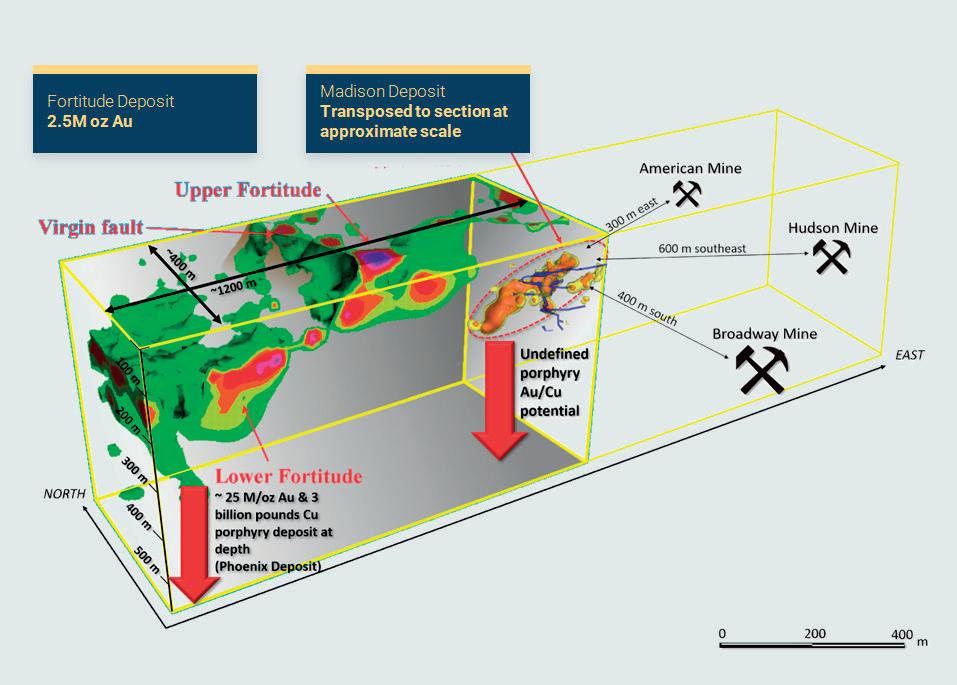
The Palmer transaction also cements American Pacific’s reputation as a premier explorer and development partner for industry mid-tier and majors.
Growth in Nevada
In May 2023, American Pacific acquired Clearview Gold and its three Nevada gold properties. The agreement included the Ziggurat Project, a joint venture with Centerra Gold.
100%-owned by American Pacific, Ziggurat is located at the northern end of the Round Mountain Trend, an active mining
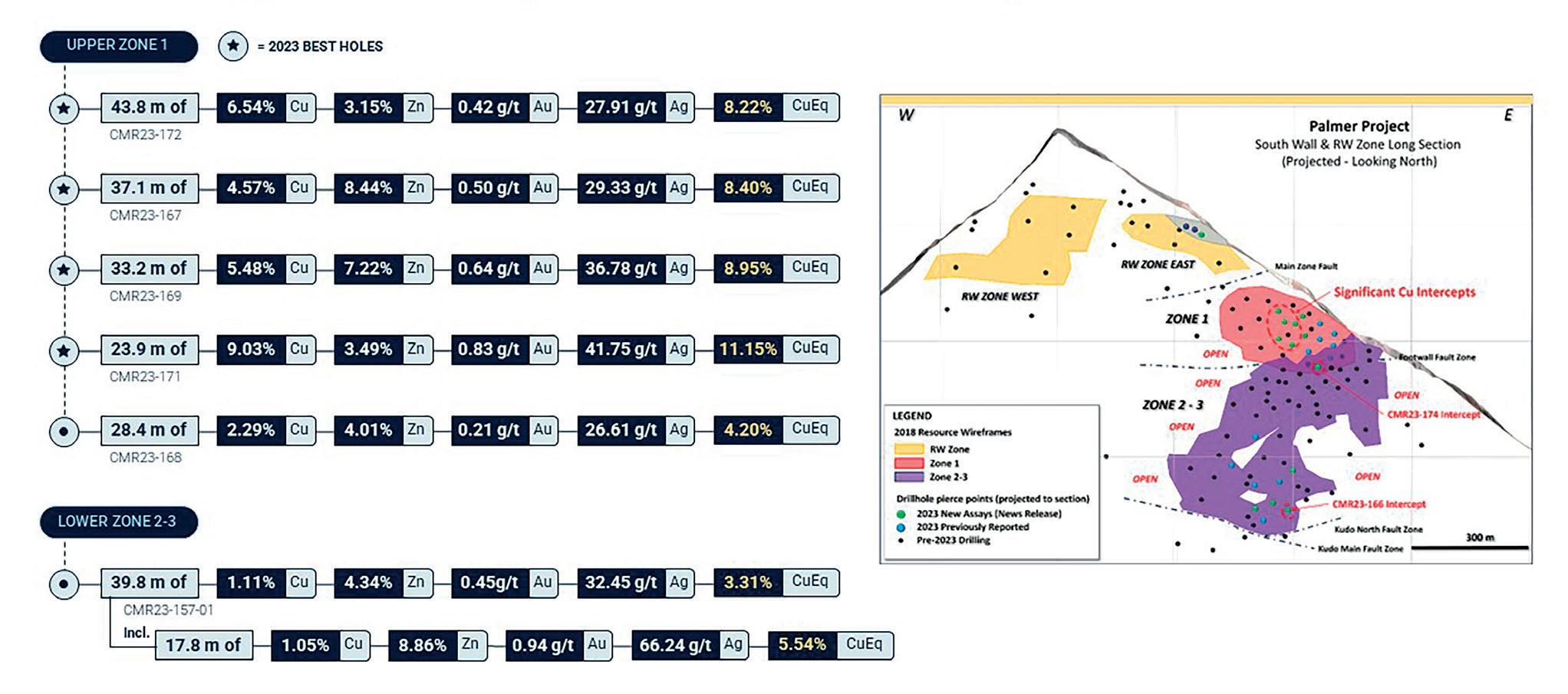
46 March 2024 // global mining review
Figure 1. Madison Project has Fortitude characteristics.
Figure 2. Best copper intercepts in Palmer history drilled in 2023.
region in Nevada with several multi-million-ounce gold projects. Ziggurat is close to key infrastructure, allowing for year-round, cost-effective exploration.
Additionally, the Clearview acquisition included two other 100%-owned gold projects for American Pacific’s Nevada pipeline. The Danny Boy Mine property, located on the northern extension of the Carlin trend, is adjacent to American Pacific’s Tuscarora Gold-Silver Project. Danny Boy’s proximity to Tuscarora has allowed American Pacific to package the properties as the ‘Tuscarora District’, creating new synergy within the existing portfolio and increasing upside potential.
Lastly, the Alpha Project is proximal to the Carlin and Battle Mountain-Eureka trends, and previous exploration has targeted near-surface Carlin-type oxide gold.
Partnered funded: David powered
US$3.5 billion market capitalisation) and Coeur Mining (US$26 million, US$1 billion market capitalisation).
Dowa provided the lion’s share of American Pacific’s 2023 operating funds. The JV partner’s contribution was allocated last summer for the single largest annual campaign ever completed at Palmer.
American Pacific anticipates a robust exploration budget in 2024 from partner funding.
Growth achieved in 2023
American Pacific conducted the most annual exploration activity ever completed at Palmer. This includes adding additional expert personnel to the project team in preparation for the 2024 programme, completing the construction and commissioning of a 60-person field camp facility, initiating new geotechnical and geophysical programmes, and furthering all
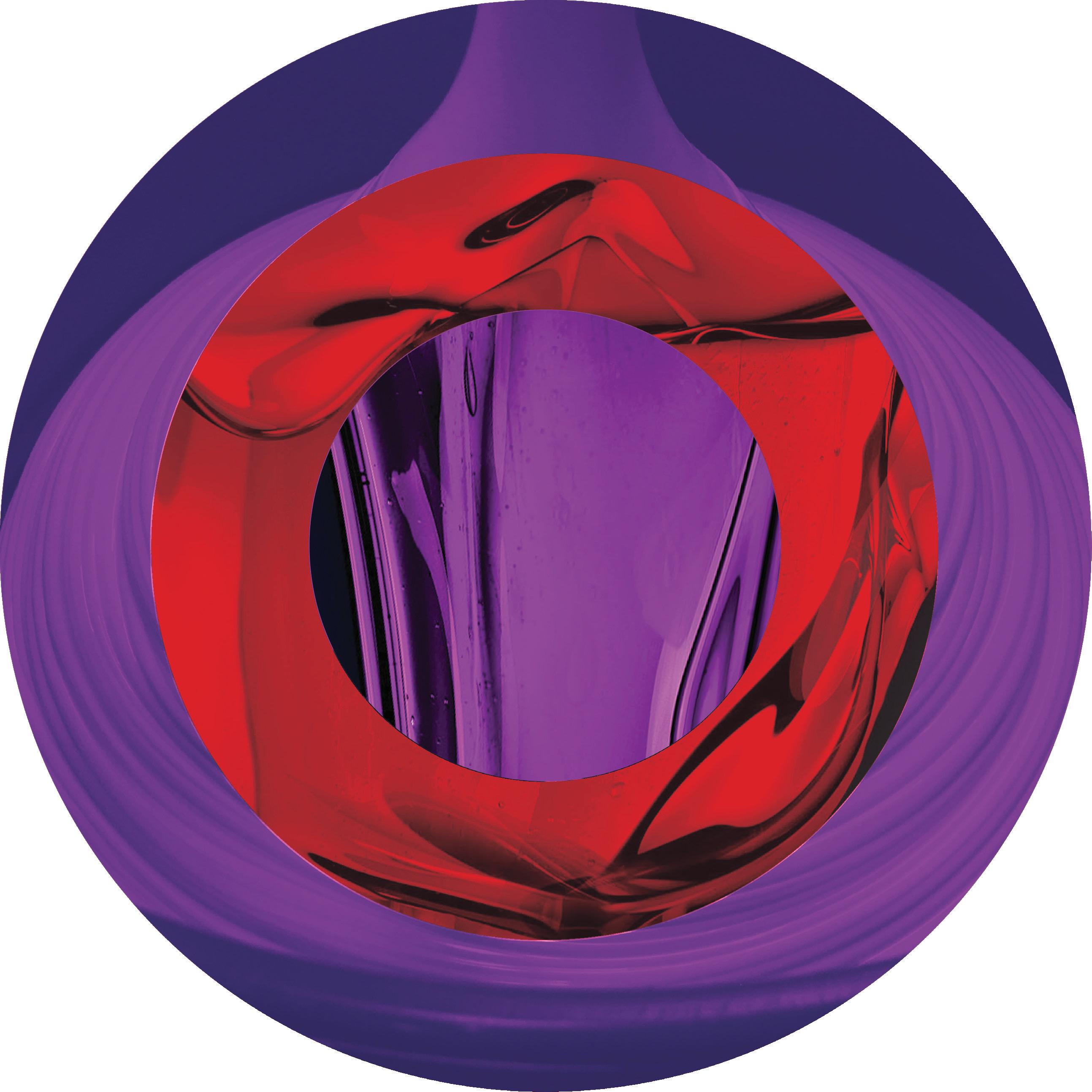
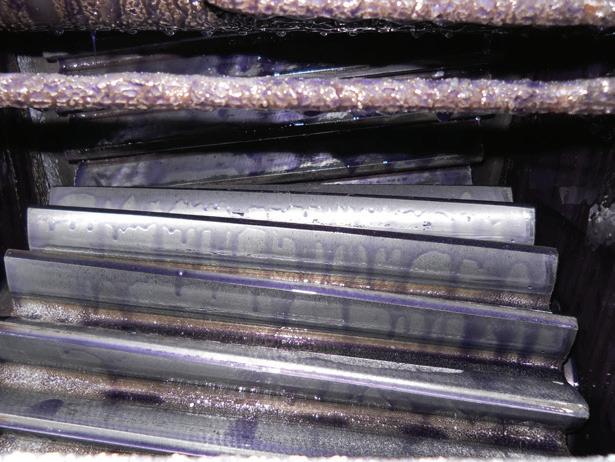

www.LElubricants.com | 800-537-7683 | info@LE-inc.com | Wichita, KS Provide superior protection for your open & enclosed gears while extending intervals We love a challenge! Contact us today to get started. ON TARGET LUBRICANTS FOR MINING DUOLEC INDUSTRIAL GEAR OIL PYROSHIELD SYN OPEN GEAR LUBRICANT Gear performance is vital to your success. LE’s Pyroshield® and Duolec® gear lubricants – with high-quality base oils and proprietary additives – perform even in difficult conditions in which conventional lubricants fail, including mining operations around the world.
At Madison, exploration activities included a high-grade gold and copper sampling programme in early 4Q23; 73 rock chip samples were collected from five targets. Values confirm a large mineralised system. Surface gold and copper mineralisation occurrences were identified over an 11 km2 area. All five targets present significant exploration possibilities.
The first phase of sampling and property evaluation was completed at the Danny Boy Project, now part of the
consolidated Tuscarora District in Nevada. The Tuscarora District has 10 priority targets and large unexplored areas that will be mapped and further sampled.
Continued shareholder confidence during 2023 was highlighted via an increased position by strategic investor Michael Gentile, now holding the equivalent of 12.48% of the company’s issued and outstanding shares on a partially diluted basis. Gentile’s increased stake adds credibility in the marketplace and with current and potential project partners. Institutional investment now accounts for 15% of the shareholder base, including Merk Investments, Ixios Asset Management, Palos Management, and Intact Financial.
Highlights from American Pacific’s final assay results reported from 2023 resource definition and geotechnical drill programmes at Palmer.
Drill hole/zone Assay highlights – including significant copper (Cu), zinc (Zn), gold (Au), and silver (Ag); metres (m)
CMR23-172 / Zone 1 43.8 m grading 6.54% Cu, 3.15% Zn, 0.42 g/t Au, and 27.97 g/t Ag (8.22% CuEq)
CMR23-167 / Zone 1 37.1 m grading 4.57% Cu, 8.44% Zn, 0.50 g/t Au, and 29.33 g/t Ag (8.40% CuEq)
CMR23-169 / Zone 1 33.2 m grading 5.48% Cu, 7.22% Zn, 0.64 g/t Au, and 36.78 g/t Ag (8.95% CuEq)
CMR23-171 / Zone 1 23.9 m grading 9.03% Cu, 3.49% Zn, 0.83 g/t Au, and 41.75 g/t Ag (11.15% CuEq)
CMR23-168 / Zone 1 28.4 m grading 2.29% Cu, 4.01% Zn, 0.21 g/t Au, and 26.61 g/t Ag (4.20% CuEq)
CMR23-174 / Zone 2 – 3 39.8 m grading 1.11% Cu, 4.34% Zn, 0.45 g/t Au, and 32.45 g/t Ag (3.31% CuEq), including 17.8 m grading 1.05% Cu, 8.86% Zn, 0.94 g/t Au, and 66.24 g/t Ag (5.54% CuEq)
Copper equivalents (CuEq) calculated using the same metal prices and recovery assumptions as the American Pacific’s NI 43-101 Technical Report (JDS 2022). Full 2023 assay results and corresponding disclosure notes were reported by the company in news release issued on 11 January 2024.
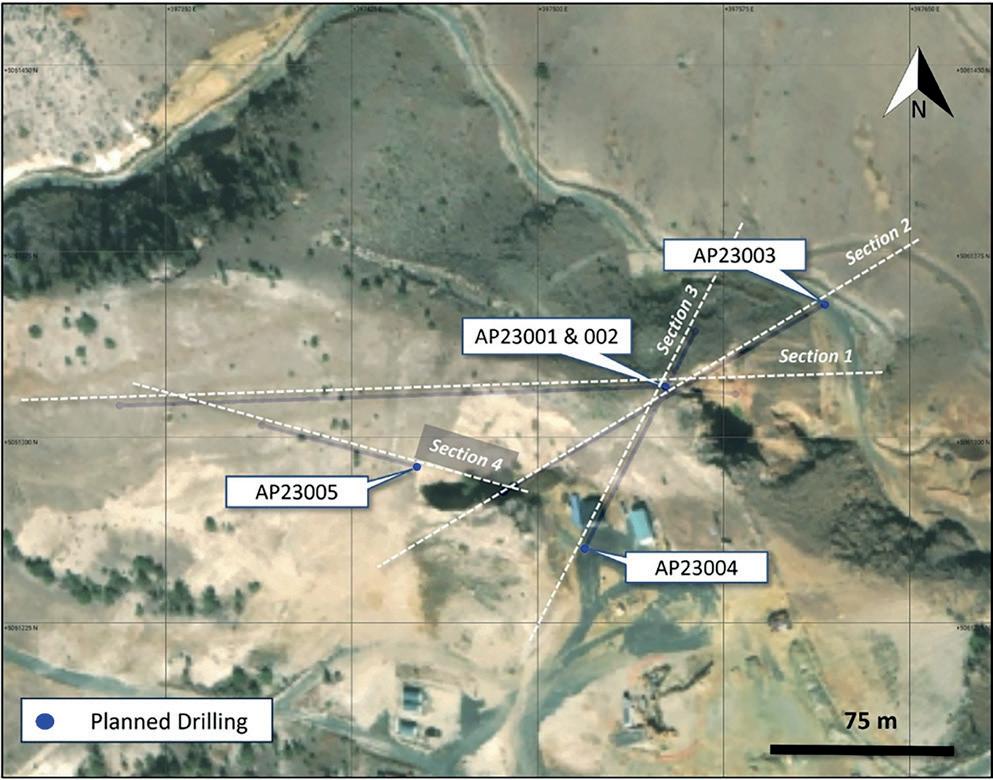
American Pacific continued to garner industry acclaim in recognition of the company’s growth, projects, and leadership team. For the 2023 Resourcing Tomorrow Outstanding Achievement Awards, the company was nominated for ‘Collaboration of the Year’ for its JV partnership with Dowa and ‘Unsung Hero’ for the pivotal role of Co-Founder Eric Saderholm. Earlier, the company was a finalist in five categories for the 2022 S&P Global Platts Metals Awards, including ‘Deal of the Year’ and ‘Rising Star’.
Evolving leadership
Several key team appointments and executive moves were made in 2023, further strengthening leadership and technical capabilities for the years to come. Serving as President from American Pacific’s founding in 2017 until summer 2023, Co-Founder and Director Eric Saderholm transitioned to Managing Director of Exploration. The newly created role allows Saderholm to focus on project development and advancement.
To fill the vacancy, Director Joness Lang was appointed as President. Lang brings 15 years of corporate growth strategy and capital markets experience in the resource sector. He has an established track record of securing and managing joint-venture and strategic partnerships with major mining companies. Lang was formerly Executive Vice-President at Maple Gold Mines, where he managed joint-venture relations with JV partner Agnico Eagle Mines.
Focused on the Palmer Project, Peter Mercer was appointed Senior Vice-President, Advanced Projects. Mercer brings an extensive background in mineral exploration, permitting, construction, and mine development.
Ali Hakimzadeh joined as an Independent Director, bringing expertise in merchant and investment banking, corporate finance, and venture capital for the public markets.
Looking to 2024
American Pacific will be active with exploration in 2024 across the western US. The company has received the required permits for Madison to commence a five-hole diamond drill campaign in 1Q24. The programme is designed to further define and expand on known near-surface, high-grade copper and gold mineralisation. It will also extend beneath known mineralisation to provide a foundation for deeper exploration in areas with limited historical drilling.
Drilling at Palmer and Ziggurat will be underway in 2024. Outstanding 2023 drill results are expected to be issued from multiple projects during 1Q24.
Table 1. The Palmer VMS Project
Significant assay results: South Wall Zones 1, 2 – 3.
48 March 2024 // global mining review
Figure 3. American Pacific’s 2023 diamond drill programme at Madison, including a focused five-hole drill campaign (3700 ft/1130 m) in 4Q23. The programme was designed to further define near-surface, high-grade copper and gold mineralisation, as well as provide a foundation for deeper exploration in areas with limited historical drilling.

Frank Termeulen, Rhosonics, the Netherlands, explains how technological advancements can make slurry density measurement safer, greener, and more cost-effective.
In order to keep the mining industry moving forward, new and innovative solutions and technologies are needed. The slurry measurement and management sector of the industry is no exception, as demands for safer and more sustainable mining practices become ever more prevalent. Rhosonics, a company specialising in non-nuclear slurry density meters, has unveiled its third-generation product, the SDM ECO. This advancement in slurry density measurement technology offers improved accuracy, reliability, and user-friendliness.
What is the SDM ECO?
The SDM ECO is a non-intrusive ultrasonic slurry density meter that uses sound waves to measure the density of slurries in real-time. It is a safer and more cost-effective alternative to traditional radiometric density meters, which use radioactive materials. Rhosonics introduced this technology for measuring slurry density in 2008, with its first model, the 9690 series. In 2016, the SDM-series was launched, which has reached an installed base of over 1500 density meters today. The SDM ECO is the newest generation for non-nuclear slurry density measurements offering innovative features to the industry.
Features of the SDM ECO
The SDM ECO has several features that make it suitable for slurry density measurement, including:
n Non-nuclear: The SDM ECO uses ultrasonics to measure the slurry density, which is non-hazardous and offers lower lifetime costs compared to radiometric density meters.
n Reliability: The SDM ECO is designed to withstand harsh industrial environments and provide reliable and repeatable measurements, even under the most demanding conditions.
n User-friendliness: The SDM ECO has a user-friendly interface and intuitive software, making it easy to operate the instrument.
49 global mining review // March 2024
n Fast and easy communication: The SDM ECO provides several outputs, which are both analogue and digital. The HMI has an interface with a touchscreen and buttons to control the device. Information can also be extracted from the instrument using a USB and ethernet port. Settings can be changed remotely when connected to the webserver, and an optional Wi-Fi module allows for easy control by mobile phone or tablet.
Applications and advantages
The SDM ECO offers a wide range of applications in mineral processing, dredging, tunnelling, and other industries. The measuring results can be used to:
n Monitor slurry density in real time.
n Control and optimise process performance, pump efficiency, etc.
n Control and improve the product quality.
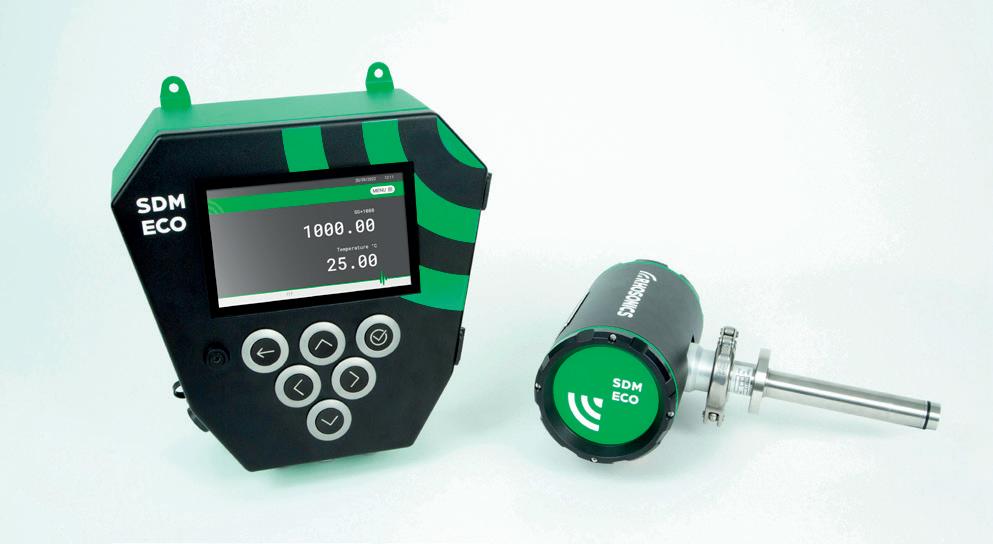
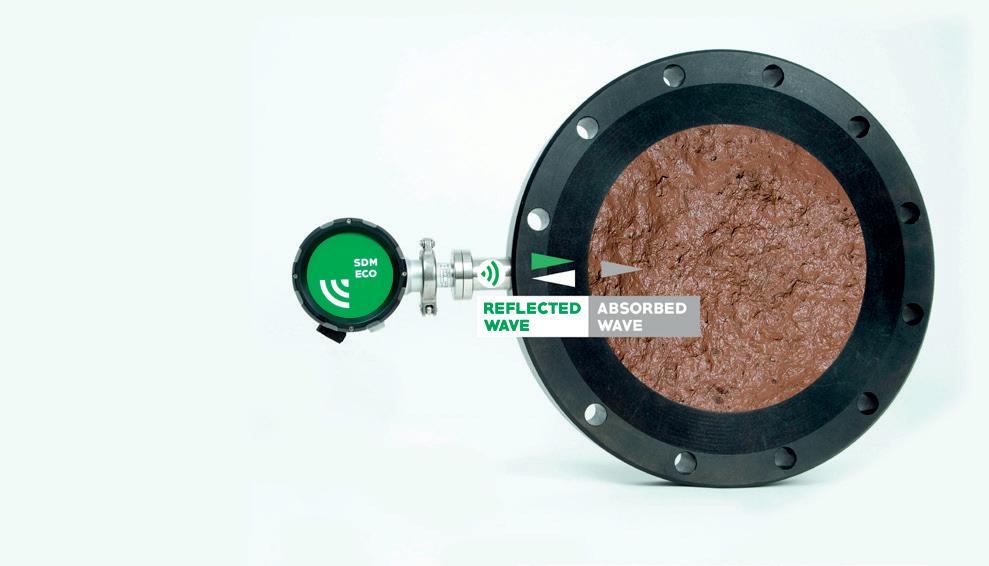
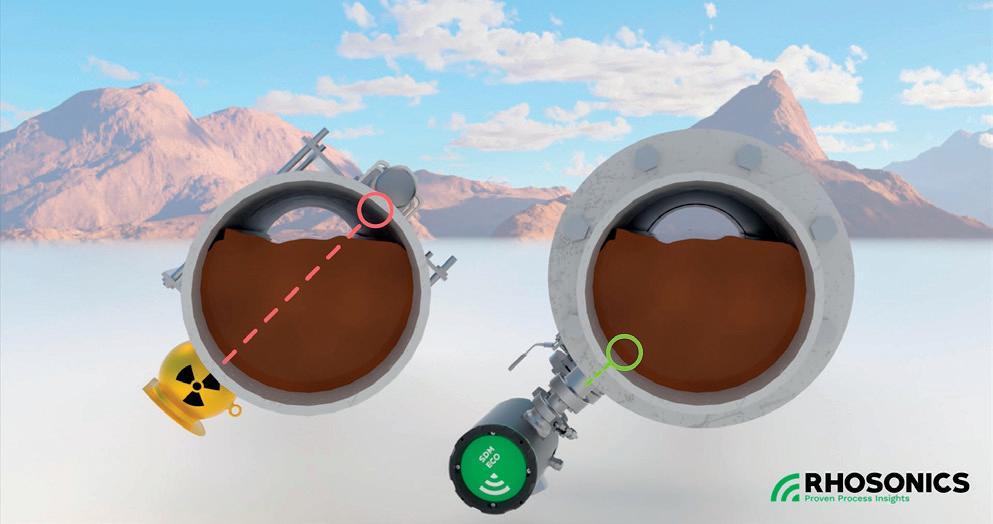
n Reduce downtime through early detection of sudden process changes.
Advantages of the SDM ECO over traditional radiometric density meters
The SDM ECO has several advantages over traditional radiometric density meters, including:
n Safety: The SDM ECO does not require the use of radioactive materials, making it a safer option for workers and the environment.
n Cost-effectiveness: The SDM ECO is more cost-effective than traditional radiometric density meters due to lower lifetime costs. Clients benefit from reduced ownership costs as they no longer need to maintain the nuclear source or comply with radiation guidelines and administrative burdens. There is no need for restricted access to the instrument and clients do not have to train radiation safety officers. They also do not have additional radiation protection costs, such as safety signs, fences, and storage bunkers.
n Ease of use: The SDM ECO is a lightweight product, with a body of 1.5 kg. This makes the product easier to install, operate, and maintain than traditional radiometric density meters that can weigh up to 500 kg due to the heavy lead radiation shielding.
Comparison between measuring principles
The Rhosonics SDM ECO measures slurry density differently than traditional radiation-based instruments. The main distinction is that the SDM ECO’s measuring principle is based on the reflection of sound waves on the sensor-slurry interface. This means that there is no need to measure through the pipe’s cross section, providing easy application of the sensor in different processes. The versatility of the SDM ECO is evident as the same sensor can be seamlessly utilised in tanks, pipes, and open launders. In contrast, radiation-based technology necessitates the beaming of radiation through the slurry. A source holder emits isotopes to the opposite side of the pipe, where a detector gauges the loss of energy, known as an attenuation-based measuring principle. This approach requires a specific source intensity to penetrate through, contingent on the slurry density and pipe size. Consequently, the same radiation source cannot be employed for larger pipes or in tanks.
The optimal conditions to use the SDM ECO
The SDM ECO reaches the most representative results under the following conditions:
n Particle size range: < 2 mm
n Flow rate: < 5 m/s
n Temperature range: 0°C – 150°C
n Pressure range: 1 – 16 bar @ 110°C / 40 bar @ 20°C
Installation of the SDM ECO
Proper installation is crucial for optimal measurement performance, and Rhosonics provides specific guidelines for
Figure 2. The SDM ECO measures the power of reflected ultrasonic waves.
50 March 2024 // global mining review
Figure 3. Explanation of the differences in the measuring principle of radiation vs ultrasonics.
Figure 1. The SDM ECO HMI-unit and the smart sensor (transmitter + transducer).
this purpose. Vertical flow is preferred over horizontal due to the characteristics of the flow. In horizontal pipes, installation points are more critical as air bubbles tend to rise to the top, and sand can accumulate at the bottom. It is essential to position the sensor away from obstacles like pipe bends, as they can affect flow behavior. As a general rule of thumb, there should be a minimum of 3 – 5 pipe diameters of straight pipe running upstream or downstream from these obstacles. Another crucial aspect is the method of installation. Rhosonics provides custom-made installation tools to ensure optimal measurement performance. The sensor is flush-mounted, meaning it is in direct contact with the slurry without intruding into the slurry stream. This installation method ensures the sensor’s longevity, resulting in an extended product lifespan. Rhosonics produces the following tailor-made process assembly tools, each offering its advantages:
n Wafer: A wafer is a flange-like installation tool that is clamped between the pipe flanges. This is a lightweight yet strong method, since the wafer is made of UHPE material. It is most commonly used in applications with lower abrasion rates.
n Spool (with optional sample port): This method is a pipe piece that is made by Rhosonics to fit between the pipe flanges of the client, matching all customer-specific diameters. Optionally, a sample port is included in the design, which is important for the calibration of the SDM ECO. The client is able to take a sample from the
process stream near the sensor, to perform a calibration and get the best measurement results.
n Clamp-in: A clamp-in tool is a cost-efficient solution with a shorter lead time compared to the other methods. This is a saddle that can be clamped around the pipe. The advantage of this method is that it is only necessary to drill a hole in existing pipes, and there is no need to make larger adjustments such as cutting the pipe. Another useful feature is that this unit comes with a hot tap, which is a ball valve construction offering the possibility to retract the sensor from the pipe without the need to stop the process. This is especially useful in case of expected scaling, since the sensor can be cleaned at any time.
n Weldolet: This is a small metal adapter that is welded onto the pipe, and requires drilling a hole into an existing pipe to fit the sensor. This method is advantageous because it can also be applied to tanks. The weldolet can be side-mounted to an agitated tank to measure the slurry density in real-time, allowing for quick process control.
Conclusion
The SDM ECO is a versatile slurry density meter that is well-suited to a wide range of applications. It presents a green choice for the industry, one that is safer, cost-effective, and more user-friendly, compared to conventional radiation-based technologies.



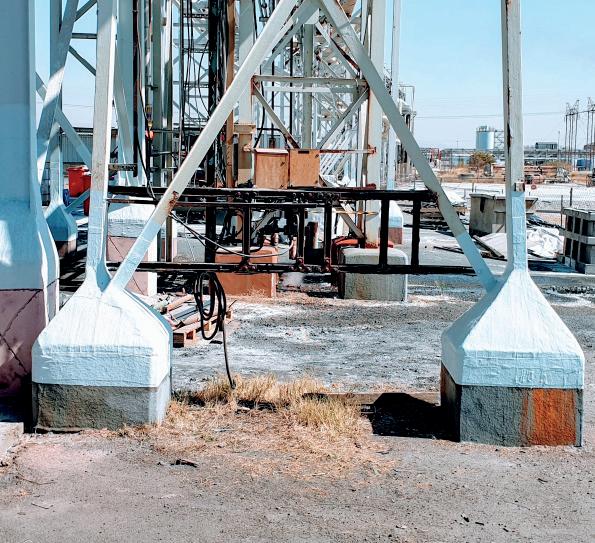


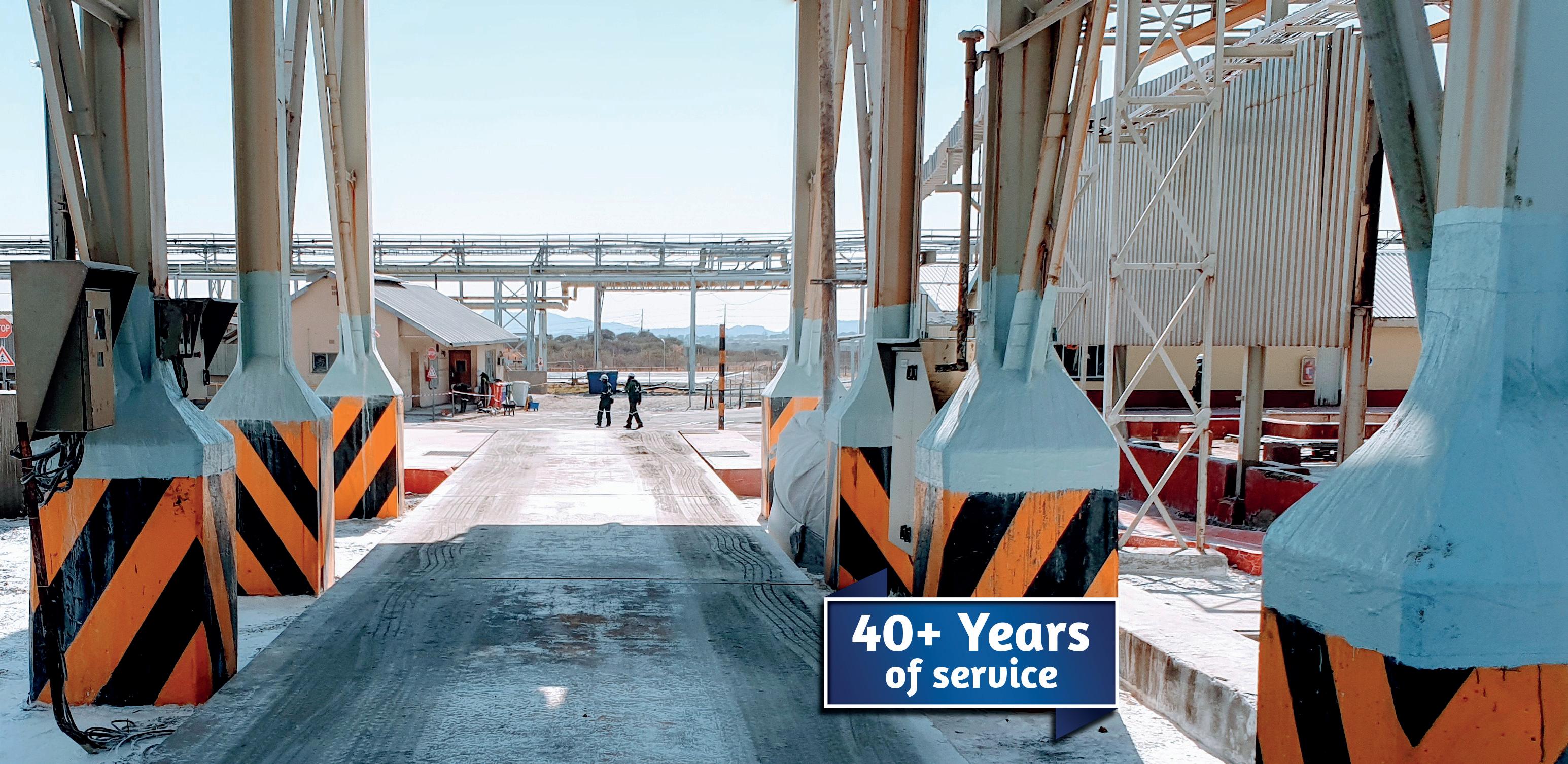


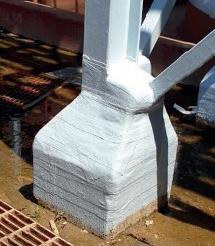


&
columns,
legs, structural steel and
hard-wearing waterproong protective
to apply with minimal surface preparation
for long-lasting corrosion protection. Call: 281-821-3355 E-mail: info@densona.com www.densona.com PROTECTIVE ENCASEMENT SYSTEM FOR COLUMN BASES & STEEL STRUCTURES Resistant to Acids, Alkalis, Salts, Etc. High Conformability & UV Resistant
The
Denso Covercoat™ System is designed to provide corrosion prevention for steel
concrete
support
more. Covercoat offers a
coating that is easy
required

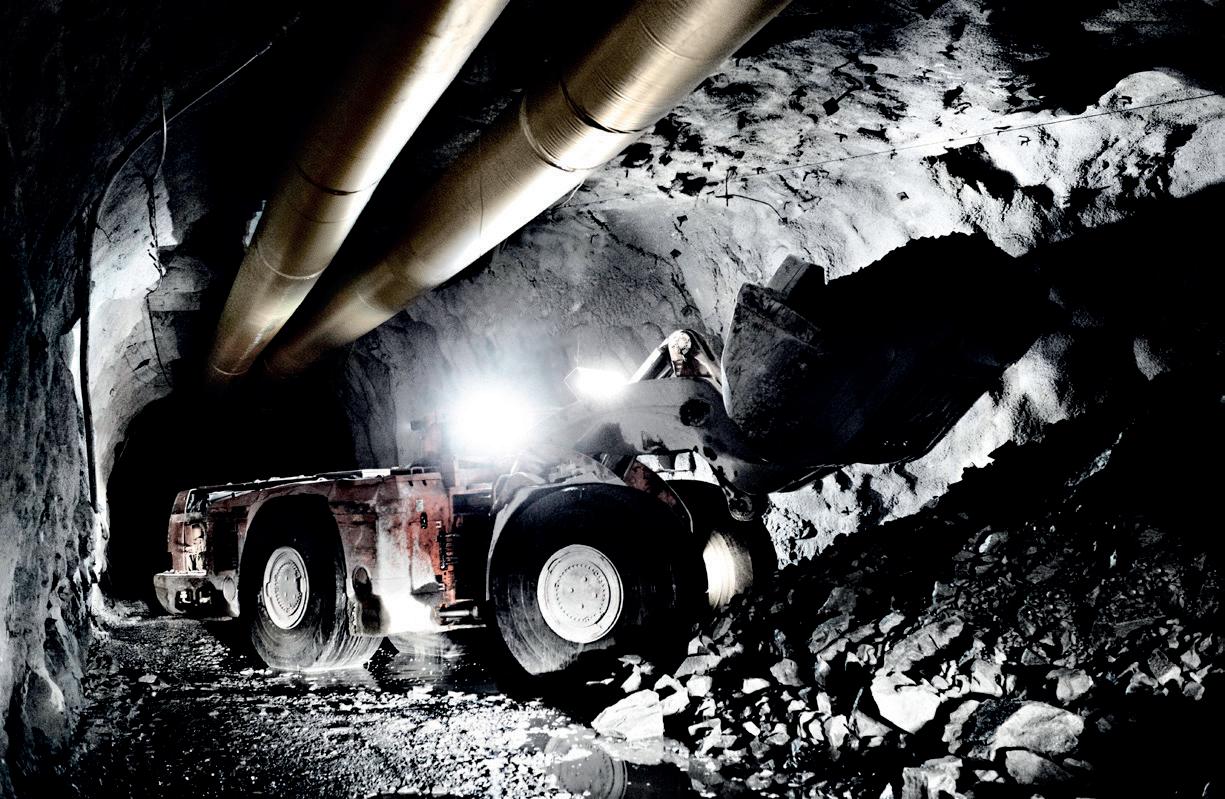





www.euromineexpo.com Euro Mine Expo is organized by Nolia AB 28-30 MAY 2024 | SKELLEFTEÅ, SWEDEN EURO MINE EXPO Cutting edge innovations & the latest methods in mining GOLD SPONSORS: SILVER SPONSORS: Register today! Book tickets and hotel rooms at our website for best availability. euromineexpo.com Euro Mine Expo is organized by Nolia AB >40 NATIONS 200 EXHIBITORS >50% MANAGERS >30 LEARNING SESSIONS GOLD SPONSORS: SILVER SPONSORS:

Tibor Nemes, Nokia, Hungary, assesses the benefits of utilising digitalisation to drive sustainable mining practices.
In recent years, the global business landscape has witnessed a significant shift towards sustainable and responsible business practices. Companies across industries understand the importance of environmental, social, and governance (ESG) factors for their operations. The mining industry is no exception, having experienced much criticism over the years for the impact it has had on the environment and social issues.
This article explores the evolving role of ESG in the mining industry and how companies are now navigating this complex landscape.
53 global mining review // March 2024
Understanding environmental sustainability in mining
To practice sustainable mining, companies must recognise the limited availability of the Earth’s resources and extract these in an environmentally conscious way to both preserve them and protect the planet and the people living on it for many future generations.
Environmental sustainability
The impact of mining operations on the environment is a growing concern for governments and regulators around the globe. Traditional mining practices have frequently resulted in ecosystem damage, soil erosion, water pollution, and deforestation. However, mining companies face mounting pressure to adopt environmentally sustainable practices as the demand for metals and minerals increases.
Modern mining companies today are investing in technology that minimises their environmental impact, including the use of water recycling systems and waste management techniques. Additionally, there is a growing emphasis on responsible sourcing of minerals, with companies committing to ethical mining practices and traceability throughout the supply chain.
Social responsibility
Many companies are now also assessing the social impact that mining has. The industry has traditionally experienced challenges related to land rights, displacement, and the wellbeing of communities when projects have taken place in the vicinity of villages, towns, and cities.
To address these concerns, mining companies are increasingly focusing on community engagement and social responsibility. This includes working closely with local communities to understand and handle their requirements, providing employment opportunities, and contributing to local infrastructure development. Companies are also working to ensure that their operations respect the rights of indigenous communities and their cultures.
Governance and transparency
Good governance is one of the most crucial elements of ESG in the mining industry. Investors and stakeholders demand transparency in corporate governance, ethical business practices, and adherence to legal and regulatory frameworks. Mining companies are expected to implement strong governance frameworks that include diversified boards, effective risk management, and accountability mechanisms.
Reporting transparency is another growing requirement. Today, many mining companies provide annual sustainability reports that include information on their ESG performance, objectives, and projects. In addition to developing trust among stakeholders, this transparency encourages investors to make decisions on a company’s sustainability commitment, has a higher probability of engaging socially responsible investors, can enable access to financing on more favourable terms, and establishes a positive reputation in the worldwide financial markets.
Economic viability and long-term planning
Sustainability in mining not only preserves the environment and advances of social wellbeing for the communities in the vicinity of operations, but also concerns financial considerations. A mining business must be economically sustainable to remain competitive and survive in the long-term.
Companies are increasingly adopting the circular economy concept, promoting recycling techniques, and exploring ways to manage resources more effectively to extend the longevity of mines. Additionally, to reduce the long-term effects on society and the environment, sustainable mining includes sustainable mine closure strategies, such as community support and land rehabilitation.
Innovation and technological advancements
Sustainability drives innovation in mining technologies, which in turn supports the development and implementation of more efficient processes which have a less damaging impact on the environment. This benefits the ecosystem around the mine, improves competitiveness, and increases the longevity of operations.
Digitalisation is crucial for driving sustainability in the industry. It introduces transformative changes that enhance operational efficiency, reduce environmental impact, and promote responsible resource management. It has a positive impact across operations, including:
Energy efficiency and renewable integration
Digital technologies enable mining companies to monitor and optimise energy consumption. Smart grids, energy management systems, and sophisticated analytics are beneficial for identifying areas for improvement and accomplishing more efficient energy use. Furthermore, more companies are now leveraging renewable energy sources, such as solar and wind power, to power their operations. Digitalisation simplifies the integration of these renewable resources, considerably reducing the carbon footprint of mines.
Precision mining and resource optimisation
Adopting digital technology, such as Geographic Information System (GIS) mapping, sensors, and drones, fundamentally transforms the processes of monitoring and controlling mining sites. These devices provide real-time data and information on geological formations, enabling companies to identify the most suitable locations for extraction. This can allow companies to reduce their environmental impact and preserve ecosystems by more precisely recognising mineral deposits and reducing wasteful excavation.
Predictive maintenance and equipment efficiency
Predictive maintenance is made achievable by integrating sensors and Internet of Things (IoT) devices into mining infrastructure. This improves operating efficiency by
54 March 2024 // global mining review
allowing teams to identify and correct operational issues before downtime occurs. In turn, this reduces costs relating to downtime and part replacement and expands the life of equipment, making operations more sustainable.
Automation and safety
Digitalisation has enabled use of automation in the mining sector, which is particularly transformative for hazardous and monotonous operations. Digitalisation capabilities –including autonomous trucks, drilling systems, and material handling operations – allow mining companies to improve workforce safety while enhancing operational sustainability, by minimising the dependence on physical labour in hazardous locations.
Supply chain transparency
The mining supply chain utilises blockchain technology to improve traceability and transparency. This is especially important to guarantee ethical sourcing and responsible mining methods. Blockchain contributes to credibility among stakeholders by offering an unchangeable and transparent record of transactions, and demonstrating a commitment to accountable and ethical resource exploitation.
Data-driven decision-making
Advanced analytics and machine learning algorithms process vast amounts of data generated during



mining operations. This data-driven approach boosts decision-making in several areas, including process optimisation and environmental impact predictions. By making well-informed decisions, mining companies may ensure responsible resource management and reduce their ecological footprint.
Conclusion
As the world embraces sustainable practices, mining companies leverage cutting-edge technologies and digitalisation to enhance efficiency and safety and minimise their environmental impact. Sustainability is not just a goal but a necessity, and it is achievable. Mining companies must transform their reputation from being environmental offenders to becoming innovators in sustainable resource management by adopting technology that prioritises efficiency, safety, and environmental responsibility.
In the context of climate change, mining companies have a unique opportunity to develop sustainable solutions collaboratively. The telecommunications industry plays a crucial role in helping mining companies become more sustainable, safe, productive, and efficient. At COP 26, Pekka Lundmark, Nokia’s President and CEO, emphasised the integral role of digital technologies, such as the Internet of Things (IoT), data analytics, artificial intelligence (AI), and private LTE, in fostering sustainability across various industries, including mining.
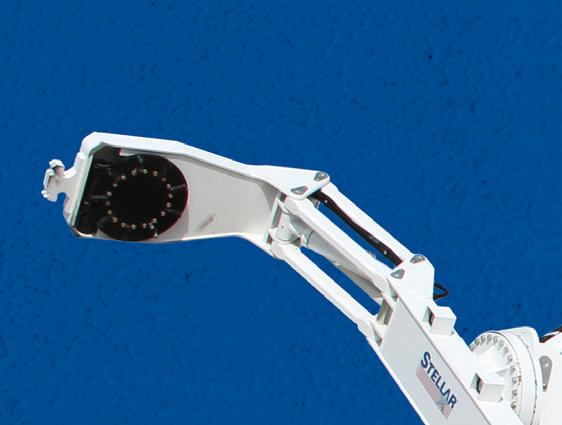


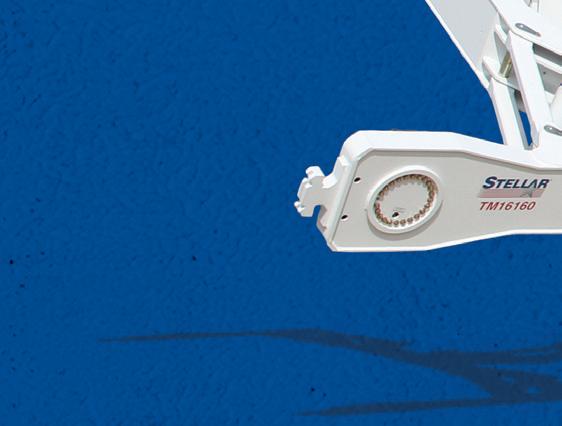



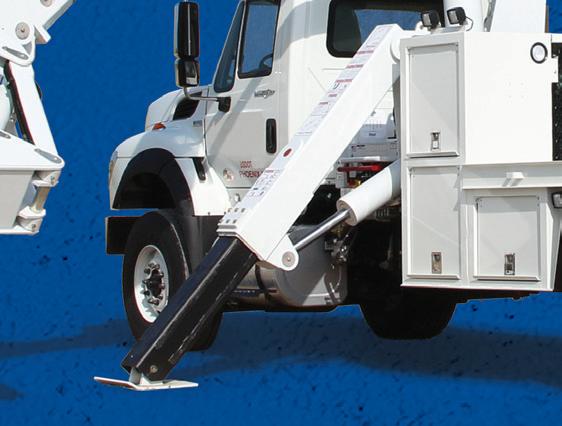


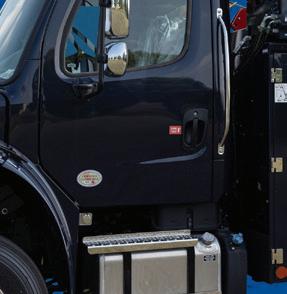

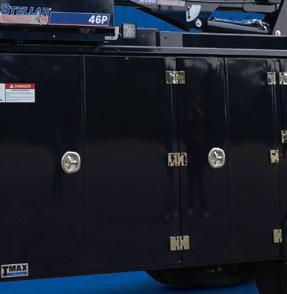




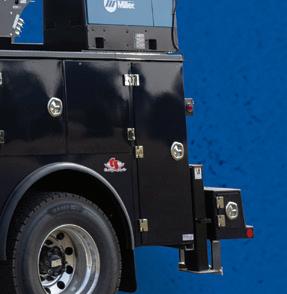




MINE MORE UPTIME Learn more at stellarindustries.com Count on hardworking Stellar ® products to keep your equipment operating. Rugged TMAX™ Mechanic Trucks have what you need to handle tough conditions. Stellar Large OTR Tire Trucks and Tire Manipulators have the industry-leading features you need. The innovative design of Stellar Tire Manipulators delivers the strength and capacity to handle a wide range of tire sizes.

The biggest heavy industry trade fair in Europe!
40 years of experience!
Join us! Showcase your machinery, equipment, and cutting-edge technologies to an international audience.
Enter our prestigious competition! Showcase your products and innovations!
Shape the Future of Industry at EXPO KATOWICE: Embark on a journey of innovation with Dynamic Networking, Growth Opportunities, and the Enlightening Conference “Industry 5.0 - Transformational challenges of industrial sector” - All Under One Roof!
Mark your calendars for September 4-6, 2024, and let EXPO KATOWICE be your gateway to global success.
Reserve your spot by the end of June and unlock your potential with EXPO KATOWICE

Eric Åström, Hägglunds, Sweden, evaluates the pitfalls of overdimensioning and considers how electrohydraulic direct drives can provide a more efficient solution in the management of peak demand.
Where mining equipment gets pushed beyond its standard operating conditions, drive system overdimensioning is the typical way to manage peak demands. While it protects drives and machines from harm, however, overdimensioning runs counter to today’s efficiency focus. Electrohydraulic direct drives can provide the same protection without overdimensioning, which is why they may be a better choice in key mining situations.
57 global mining review // March 2024
Figure 1. A complete electrohydraulic direct drive system installed on a belt conveyor.
Incentives to avoid overdimensioning
In many mining tasks, variable-speed drive systems are used to optimise production and reduce the power consumed. Yet the advantages of variable speed come with challenges to machine reliability and lifetime, especially in low-speed, high-torque applications.
Overdimensioning can resolve these challenges by providing a physical buffer against application extremes. However, it is neither the only way to meet them nor necessarily the best way. In an age of tight profit margins and decarbonisation, there are significant benefits if drive overdimensioning can be avoided:
n Reduced CAPEX and CO2 footprint: By definition, overdimensioning means buying larger and perhaps more equipment than what is needed for most of a machine’s operating time. Avoiding overdimensioning cuts cost up front, and it reduces the CO2 burden connected with materials, production, and transport.
n Higher efficiency in operation: In general, overdimensioning leads to drive system losses that increase OPEX. An optimally dimensioned drive system is more efficient by nature, which lowers its lifecycle cost. In cases where greater efficiency translates into energy savings, CO2 footprint is also reduced over time.
n Smaller installation: A smaller drive system means a smaller machine. Although space is seldom a direct issue in mining, leaner design can further reduce CAPEX, improve service access, and potentially lead to savings through reduced weight.

Choosing an electrohydraulic direct drive system over a traditional electromechanical drive system is an easy way to harness these advantages. Hägglunds provides electrohydraulic direct drive systems to major mining customers worldwide, and the number of Hägglunds systems is especially high in applications where overdimensioning is common.
How electrohydraulic direct drives sidestep overdimensioning
Electromechanical drive systems and electrohydraulic direct drive systems can both deliver variable low speed in high-torque applications. However, their differences have a substantial impact on drive dimensioning. Above all, they differ when it comes to the electric motor, which is the main component in an electromechanical system but only the prime mover in an electrohydraulic system.
Although common in mining, variable-speed AC drives with self-ventilated motors cannot operate at rated torque throughout their entire speed range. Due to the electric motor’s limitations, the continuously available torque is reduced at low speed. This demands a basic level of overdimensioning to compensate, and introducing frequent starts/stops or high starting torque requirements leads to even more. Because a gearbox is used to convert the electric motor’s existing speed and torque to low speed and high torque, it too must be overdimensioned.
By contrast, electrohydraulic direct drives have no gears and no limitations on continuous torque. Their maximum pressure can be applied from zero speed and for an indefinite time, so the hydraulic motor can be dimensioned solely for the torque demand. Because the electric motor drives only the hydraulic pump, it operates at a fixed speed and needs no overdimensioning. Its operating conditions are constant, regardless of the application challenges.
Mining scenarios where overdimensioning is prominent
Overdimensioning, of course, is just one consideration in choosing the correct drive system. However, the impacts of overdimensioning – and the potential advantages of choosing an electrohydraulic direct drive over an electromechanical drive – are significant in the following scenarios:
n When torque above nominal is needed throughout the speed range.
n When frequent starting and stopping is required.
n When high starting torque is needed for long periods.
n When shock loads can lead to damaging torque spikes.
In a mining context, belt conveyors and apron feeders are good examples of these scenarios. Commonplace at mining sites, these applications are crucial to overall flow and productivity. An issue in either can have large implications downstream.
In both applications, drive dimensioning is critical to operations and reliability. Yet the correct dimensioning of an electrohydraulic direct drive system will be significantly smaller than that of an electromechanical system for a given installation. A closer examination of each scenario makes this clear.
58 March 2024 // global mining review
Figure 2. The hydraulic motor is the only component physically connected to the shaft.
Providing sufficient torque throughout the speed range
Belt conveyors and apron feeders are among the mining applications where consistent torque is needed, regardless of operating speed. Although these machines spend most of their time at nominal speed, reaching it may require high starting torque and a period of acceleration. On occasion, there may also be situations that require a temporary slowdown.
This is problematic for electromechanical drive systems, especially if they utilise self-ventilating electric motors. When the speed is close to zero, their continuous torque is limited to approximately 70% of the motor’s rated torque. For the required torque to be available at all speeds, the motor and gearbox must be overdimensioned, and additional cooling may also be needed.
Such compromises are unnecessary with electrohydraulic direct drives, where the electric motor runs continuously at rated speed. The hydraulic motor, which turns the shaft, runs no risk of overheating. Therefore, both motors can be sized exactly for the torque demand, resulting in lower CAPEX and potential energy savings in operation.
Handling frequent starts and stops
Once at speed, belt conveyors in mining tend to maintain their pace. Apron feeders, however, are more likely to start and stop frequently. This small difference in behaviour can place substantial stress on apron feeder drive systems.
Intermittent operation is hard on electromechanical drives, where the speed is controlled by the electric motor and converter. After a certain number of starts and stops, the two components simply overheat. This number can be increased, but only through overdimensioning and/or added cooling, which increase cost and introduce losses.
The situation is different for electrohydraulic direct drives, where the electric motor always runs at its rated speed. The electric motor never stops or overheats, because the rotation is steered by the pump flow. The hydraulic motor on the shaft, whose speed and direction are controlled by the pump, can start, stop, and even reverse as often as necessary.
Supplying high torque without time restrictions
Of course, mining can be unpredictable for any type of equipment. Apron feeders can become blocked or freeze in extreme weather, belt conveyors can be overloaded, and electricity outages can always occur. When the unexpected happens, high torque may be necessary for a longer period of time, especially if the machine has to restart in a loaded condition. Otherwise, the load may have to be removed manually, increasing the downtime and production lost.
In electromechanical drive systems, the starting torque available from the electric motor and converter is higher than the continuously available torque. If the starting torque is sustained, however, the risk of overheating is significant. Torque in the 180 – 200% range can only be applied for a few seconds, which means a larger motor, a larger converter, supplemental cooling, and perhaps a fluid coupling are needed to compensate.
In electrohydraulic direct drives, the increased pressure at starting torque can be sustained indefinitely by the
hydraulic motor. Not only is the electric motor unaffected, it also consumes less power when the hydraulic motor is at low speed. Maximum torque can therefore be applied for as long as needed, with no risk of overheating or additional production losses. The drive system’s fully variable speed can also be used for inching, making it easy to check for strain-related damage.
Building in shock load protection
For apron feeders, as well as many other types of mining equipment, there is a further source of potential damage: shock loads. When large amounts of heavy material impact the machine, the sudden stop creates a torque spike that can do extensive harm – not only to the drive system, but also to other machine components. Where shock loads occur, robust protection must be built in.
Safeguarding electromechanical drive systems requires extra equipment, such as a shear pin coupling. Moreover, components such as chains, sprockets, and bearings must be overdimensioned for the strain. Above all, shock loads necessitate a substantially overdimensioned gearbox, usually at a significant extra cost. This is because geared systems greatly multiply the moment of inertia, which is the source of additional torque when a sudden stop occurs.
Electrohydraulic direct drives respond much differently to shock loads, in part because the hydraulic fluid itself has a damping effect. More importantly, the hydraulic motor has a very low moment of inertia, and there are no gears to multiply it. Thus, the total moment of inertia is up to 1000 times less than that of an electromechanical drive system. When a shock load occurs, the hydraulic system will relieve the torque stress instantly, relying on a built-in pressure-limiting function rather than overdimensioning of machine components.
A wide case for electrohydraulic direct drives in mining
With these dimensioning factors in mind, it is unsurprising that Hägglunds electrohydraulic direct drives are used by many of the largest and most respected actors in mining. Common on belt conveyors and apron feeders, Hägglunds solutions can also be found on crushers, sizers, and mills. Likewise, they are used on a wide range of bulk handling equipment, such as bucket wheel reclaimers.
Bucket wheel reclaimers benefit from the accurate drive dimensioning, but also from the overall flexibility of the Hägglunds drive layout. The lightweight hydraulic motor can be mounted on the boom to drive the wheel, while the electric motors and pumps are shifted to a central location. In this way, steel bulk and counterweight can be reduced, creating a leaner, more agile, and more cost-efficient machine in total. This solution was recently employed on the world’s largest bucket wheel reclaimer, capable of moving 20 000 tph.
In applications large or small, the potential of electrohydraulic direct drive systems is worth evaluating –especially in positions with frequent starts and stops or high, unpredictable torque demands. Simply put, the ability to protect vital equipment without building in unnecessary costs and efficiency losses is well aligned with today’s mining strategies.
59 global mining review // March 2024
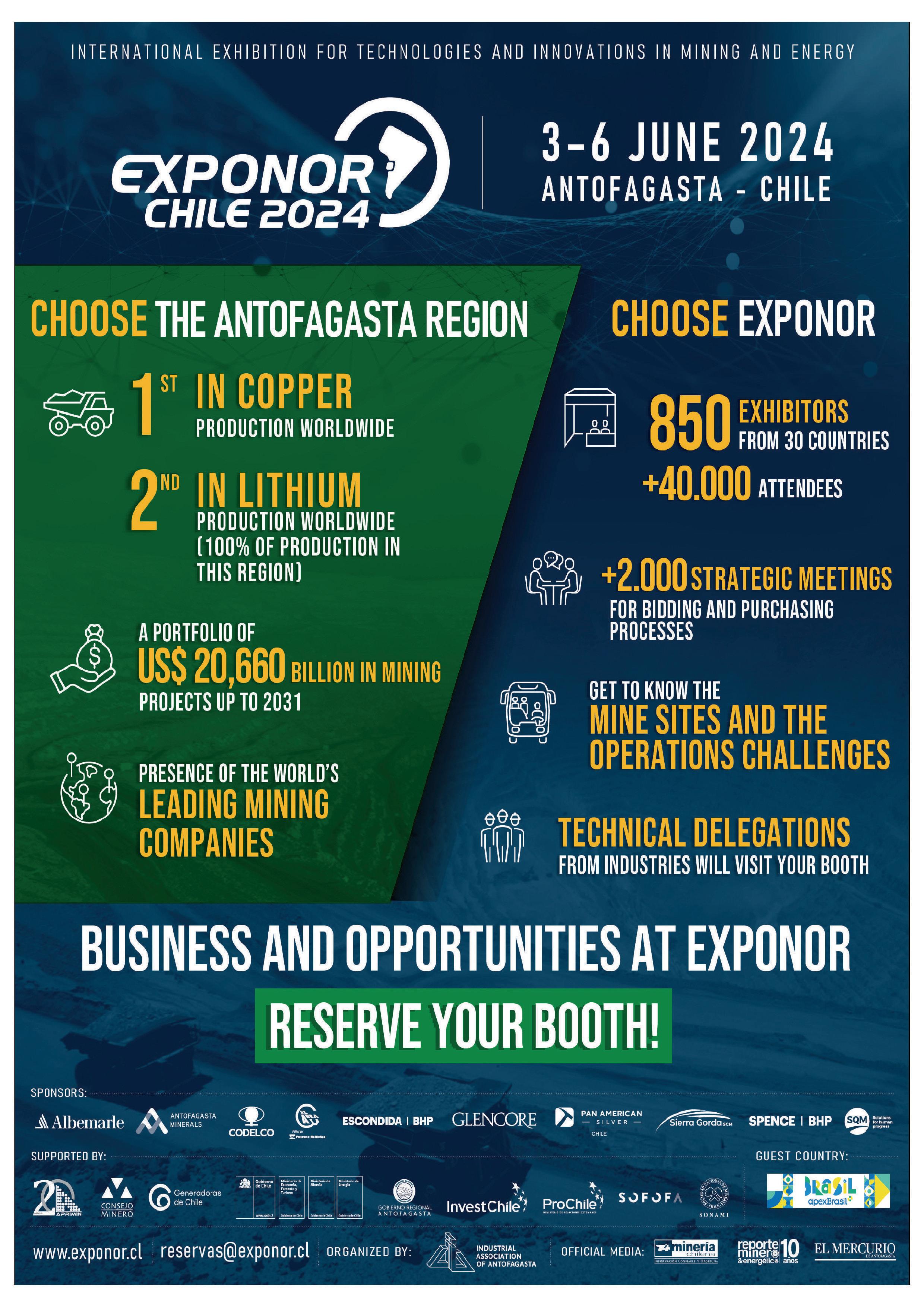

Giancarlo Scaturchio, Rockwell Automation, Italy, explores how variable frequency drives can deliver improved sustainability for mining operations through a collaborative business model.
The global transition towards clean energy requires as much as 3 billion t of metals, and the demand is expected to grow in the coming decades. According to the World Economic Forum, to hit net zero emissions globally by 2050, six times more mineral inputs will be required in 2040. The mining process, from exploration to operation, is highly energy intensive. It accounts for 10% of the world’s energy consumption, hindering net zero ambitions and causing significant environmental impact from land-use change.
61 global mining review // March 2024
Mining, utilities, oil and gas operators, and other demanding industries have long relied on variable frequency drives (VFDs) to improve energy efficiency. Drives like Rockwell Automation’s PowerFlex® medium voltage VFDs can control large industrial motors – keeping operations running for 24 hours daily. Their use in the mining sector is often hampered by their high upfront capital cost, but a new collaboration between Rockwell Automation and the Energy Drive Group is changing that business model.
Boosting the use of VFDs
Rockwell Automation and Energy Drive are collaborating on projects that are designed so that the resulting energy savings offset any investment in technology and systems required to drive sustainability solutions. Energy Drive partners with companies from various energy-intensive industries to actualise their energy-related sustainability goals. They use variable speed drives (VSDs) to reduce energy consumption
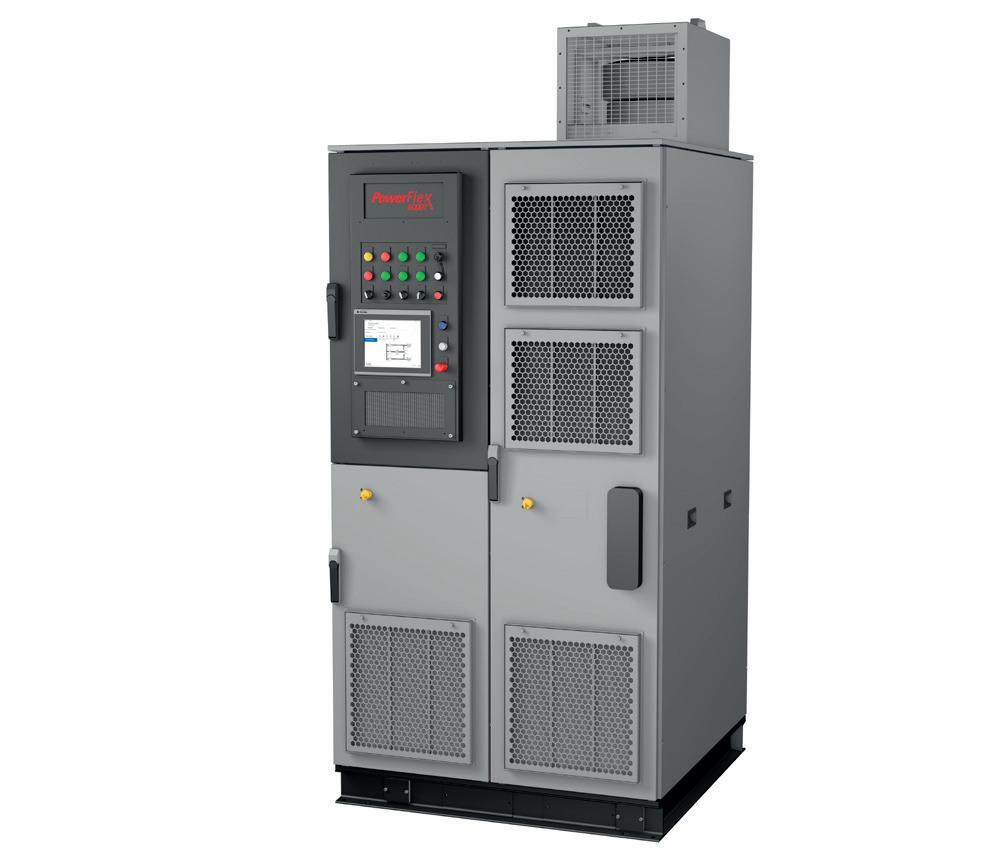
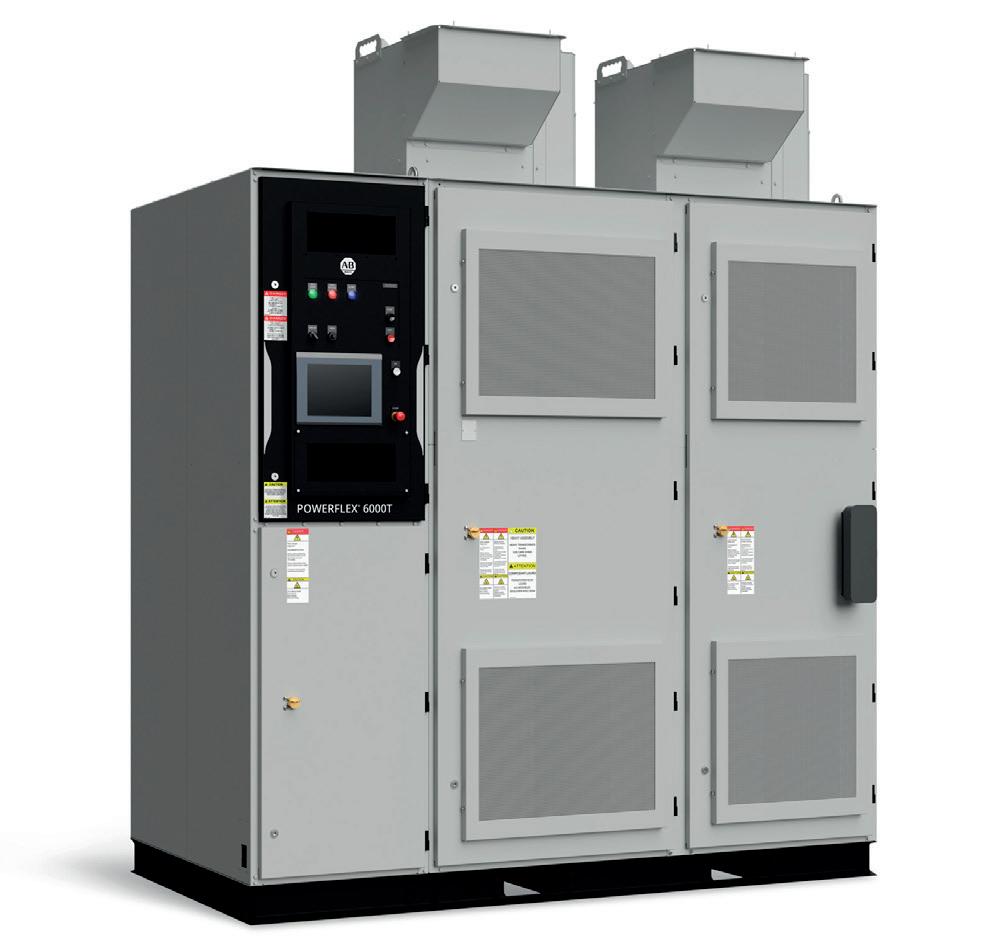
and achieve more efficient operations, while lowering energy-related business costs. This is achieved by removing the barriers to energy optimisation by taking on the risk and staying invested in organisations for the long term. Energy Drive assists clients in the identification and assessment of the opportunity. Then, by purchasing the required equipment, installing it, and ensuring that it runs effectively for as long as it is on a site, an innovative, fully engineered, turnkey sustainability solution can be executed via a zero-CAPEX service contract.
One example of this collaboration occurred at a gold mine owned and operated by Sibanye-Stillwater, a multinational mining and metals processor. They engaged Energy Drive to improve and accelerate the energy efficiency of their mine ventilation systems, and in turn, Energy Drive turned to Rockwell Automation for its VFDs. The initial focus was on the large surface ventilation fans used in two of Sibanye’s gold mines in South Africa. Ventilation in underground mining is critical but uses a lot of energy.
To meet health and safety requirements, at least one fan is fully operational, and another is on standby in case of failure. Energy Drive installed and optimised VFDs on the motors of both fans and then turned the speed down while running them together.
A gold standard for energy efficiency
The site uses multiple medium voltage (MV) ventilation fans to provide airflow to its mine. The two vent fans at the shaft are directly coupled to two 2240 kW induction motors – a standard squirrel cage motor and a slip ring motor. These fans run in a duty and standby pattern that is normal for such a ventilation fan system in mining operations. In this fashion, one fan runs continuously to provide airflow to the shaft, while the second fan is used as a standby fan to ensure redundancy. The fans were controlled from the mine’s central Wonderware SCADA network using Inlet Guide Vanes (IGVs). A third-party energy partner managed the clipping schedule on behalf of the mine, which used the IGVs to reduce airflow during peak times.
Energy Drive engineers saw the opportunity to run both fans together to provide the same airflow as one fan. While counterintuitive, this concept would allow Energy Drive to run each fan at a much lower speed. Each fan would provide a lower airflow, and the well-documented affinity law relationships would substantially decrease power demand. Additionally, running two fans with fully open IGVs would allow the fans to return closer to their best operating point (BOP), leading to for greater efficiency. The Energy Drive engineers predicted an energy saving of 60% using the mine’s suggested flow rates.
A speed reduction can be efficiently achieved using a VFD, which has become a well-established, proven technology for process control and, in this instance, saving energy.
Rockwell Automation PowerFlex 6000T VFDs were used to control and reduce the fan speed, and this delivered an average of 62% in energy savings in the first shaft and 48% in the second. The two upgraded shafts have been operational for nearly a year, and a third shaft will soon join them. When this is operational, the three upgrades are expected to deliver energy savings of about 360 GWh over the contract term,
Figure 1. Rockwell Automation’s PowerFlex 6000T VFD.
62 March 2024 // global mining review
Figure 2. Rockwell Automation PowerFlex 6000T VFDs can be used to control and reduce the fan speed.
equivalent to removing 5000 homes in South Africa from the grid every month. More importantly, measuring actualising sustainability will save 379 000 t of carbon over the period, and will significantly reduce water and coal consumption.
The VSDs intended for use at the mine were too tall for the typical 40 ft high cube container, prompting project engineers to consider other solutions. With the ease of transportability and a familiar footprint for logistics companies, shipping containers were utilised for this purpose, designed and built by Energy Drive Projects, a group company. The decision was taken to use the exact base dimensions as the 40 ft container but with a bespoke e-Unit constructed on it. This allowed Energy Drive to accommodate the tall VSDs, while still having an easily mobile and self-contained solution.
Safety first with online monitoring
Energy Drive electronically controls the upgraded systems from the surface. All of the systems are monitored 24/7 with pre-set alerts on critical conditions. The communication between Energy Drive and the site PLC is crucial, allowing feedback to the mine on the state of the VSD and receiving input from the mine on clipping/non-clipping modes of operation. The PLC can also keep IGVs fully open when under VSD control to maximise savings for the site. A data and analytics platform allows the engineers to have a live view of VSD health, as well as the health of system communications. In the event of anything out of the ordinary, this data is at the fingertips of engineers who can inform mining personnel and dispatch technicians when needed.
A critical part of the commissioning process was establishing a flow baseline for the mine. This was achieved with the help of a third party, who performed a comprehensive set of pitot tube tests to determine the pressure when on IGV control. These tests were performed during the clipping and non-clipping stages of operation. The VSD was tested at three operating speeds, 30 Hz, 27 Hz, and 24 Hz. Once all these tests had been performed, a comprehensive comparison between the flows under IGV control and those under VSD control could be made. The report showed that while under VSD, an operating speed of 27 Hz on each fan would provide the mine with the same flow it received during its non-clipping operations. Both fans could be run at 24 Hz during clipping times to achieve the same flow rates.
Conclusion
With an original baseline of 1710.3 kW, the fans now run at 605.75 kW. The results of this project have been so successful that Energy Drive was awarded the Energy Award for ‘Industrial Energy Project of the Year’ by The Southern African Energy Efficiency Confederation (SAEEC) for 2021.
This joint initiative has been a great success for all stakeholders; with an original baseline of 1710.3 kW (recorded for Shaft 8), the fans now run at 605.75 kW since installing the system. A saving of 374.02 GWh has been predicted from Shafts 8 and 2 and the upcoming project Shaft 5 from August 2021 to August 2031. This equates to reductions of 393.7 million kg of CO2, SOx, and NOx emissions; 519.9 million l of water; and 256.6 million kg of coal and ash.




OF INDIA'S LEADING MINING COMPANIES
PROJECT DIRECTOR FOR A GLOBALLY HIGH RANKED COPPER MINE WITH ZINC AND LEAD LIFETIME ASSET VALUE : US$ 3B Candidates with relevant experience and expertise may get in touch with us by visiting our website www.gmdcltd.com For more details Scan QR code 469th � RANK ((AN} IN • � IM l·lil,l◄I INDlliS �
ONE
SEEKS









39 Aquatain Products Pty Ltd 23 BEUMER Group IFC Caterpillar Inc. 44 CIM Connect Convention + Expo 31 Cincinnati Mine Machinery Co. 04 CR Powered by Epiroc 51 Denso Inc. IBC Discoveries Mining Conference 40 Electrification in Mining 52 Euro Mine Expo 56 EXPO KATOWICE 60 Exponor Chile 63 Gujurat Mineral Development Corp. Ltd 06 Komatsu 47 Lubrication Engineers 36 MINExpo International 02 Petro-Canada Lubricants 15 Philippi-Hagenbuch 55 Stellar Industries OFC & 27 TotalEnergies Lubrifiants OBC Weir 19 Wirtgen 64 World Coal Advert Index Global Publication Subscribe online at: www.worldcoal.com/subscribe A global industry requires a global publication ® WCL_Global_Publication.indd 1 24/09/2015 15:01





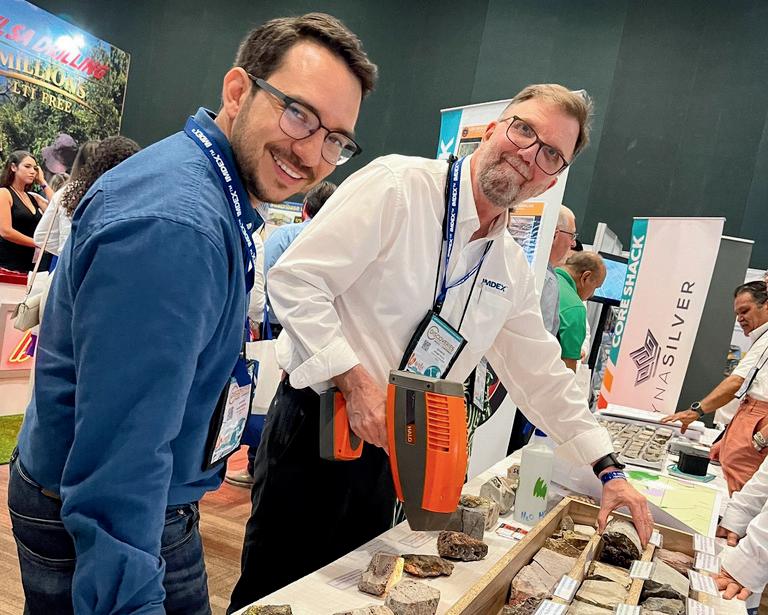




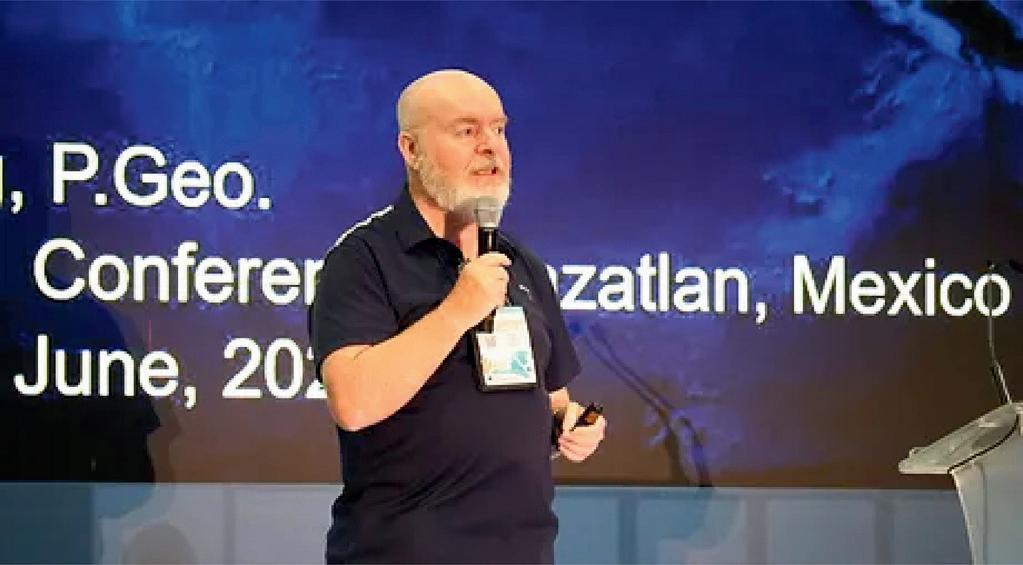


Don’t spend more on tailings than you have to.
Weir Minerals’ unmatched technology and expertise means you can find a solution that’s built to your operational and site requirements. We’ve reduced customer energy consumption by 51%, average water usage by 76% and lowered TCO all while safely improving the stability of tailings and reducing the tailings footprint. Plus, we can even help re-purpose waste into useful materials for dam wall construction and backfill that saves valuable resources and increases efficiency.
Now it’s your turn to re-think tailings with a Weir Minerals tailored solution. global.weir/rethink_tailings
Copyright©
2023, Weir Minerals Australia Ltd. All rights reserved.



















































































 Figure 1. WaterGuard GOLD is available in several sizes, up to 1000 litre IBCs.
Figure 1. WaterGuard GOLD is available in several sizes, up to 1000 litre IBCs.












































































































































